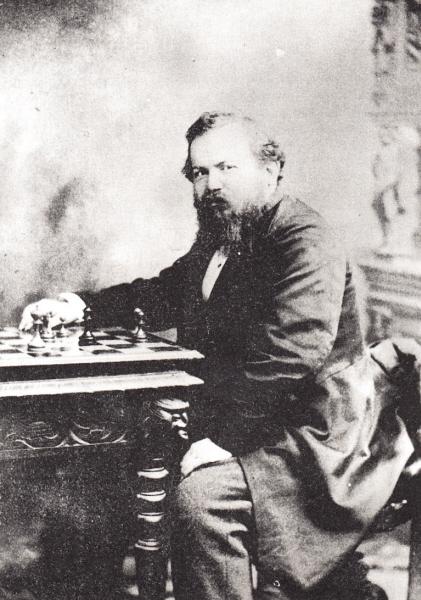
Edward Winter

Wilhelm (William) Steinitz. See C.N. 7654 below.
Bobby Fischer’s view of Steinitz appeared in the article ‘The Ten Greatest Masters in History’ (on pages 56-61 of Chessworld, January-February 1964):
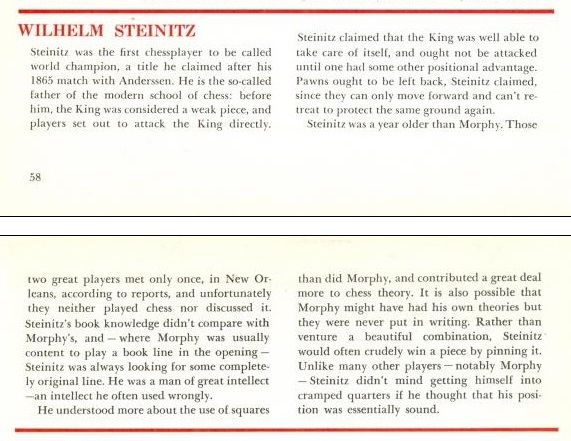
Steinitz writing on page 22 of the January 1887 International Chess Magazine (part of the justification provided for his Personal and General column):
‘... to make it disagreeable for dishonest parties who are, I believe, even less numerous proportionately in the chess world than in other walks of life, but more crafty, cunning or “smart” as it is called. Chess must be established as a thoroughly straightforward and honest game first of all before it can be made a real gentlemanly one, and unscrupulous trickery, deception and fraud must be “warned off the track”. But it requires a strong arm to accomplish that, and war on dishonest chessists cannot be made with rose water ...’
See Steinitz Quotes.
The Chess Beat (Oxford, 1982) is a reproduction of 300 newspaper columns written by Larry Evans.
Poor old Steinitz is fair game for Evans’ knock-about style. Not only is there no discussion of Steinitz’s contribution to chess, there is not a single game by him. (There are 20 by Evans himself. ) The collection does, however, present examples galore of Steinitz’s ‘eccentricity’. (No instances of Evans’ are given.) Perhaps that is what is called historical perspective.
(323)
Many anecdotal books (the latest being The Kings of Chess by W. Hartston, page 67) attribute to Steinitz the sharp questioning quip about a monkey examining a watch. This is given on page 37 of the February 1890 International Chess Magazine, but Steinitz is not the speaker. The words were said by Mr Schüll of the Liverpool Chess Club, and are reported by Burn in a published letter to Steinitz.
(1077)
In reality – as briefly mentioned in C.N. 1077 (see page 125 of Chess Explorations) – the words in question were spoken by Ludolph Schüll of the Liverpool Chess Club and were reported by Amos Burn in the final paragraph of a letter (dated 30 December 1889 and concerning a telegraphic chess code) which was published on pages 36-37 of the February 1890 issue of Steinitz’s International Chess Magazine:
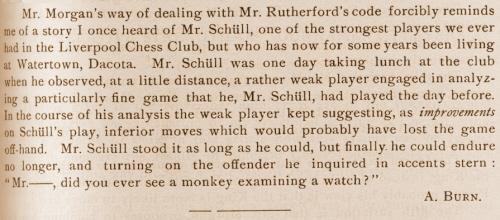
(6590)
From page 5 of Chess to Enjoy by A. Soltis (New York, 1978):
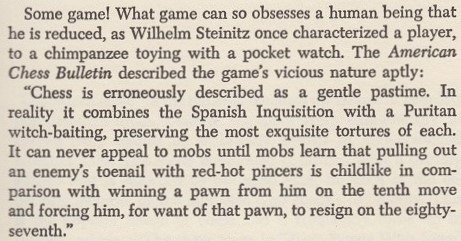
The Steinitz ‘once’ story was disposed of in C.N.s 1077 and 6590.
As regards the paragraph quoted, Soltis did not bother to state when during its long run (1904-63) the American Chess Bulletin published it.
(9138)
The answer is that the passage appeared on page 25 of the February 1935 American Chess Bulletin but was specifically headed as a feature merely reproduced from elsewhere (‘New York “Sun” Editorial’).
From page 57 of The Kings of Chess by William Hartston (London, 1985):
‘Steinitz defeated Dubois [in 1862], to begin the most impressive match record in the history of chess.’
(9445)
On the subject of Dubois v Steinitz, see Confusion.
Concerning The Moscow Challenge by Raymond Keene (London, 1985):
Page 9: we are told that it is ‘staggering’ that Steinitz’s tournament record during the period he was champion (1886-94) was ‘abysmal’. Should a writer not at least check his facts before so criticizing a great player? The truth is that Steinitz did not play in a single tournament during the period under consideration.
(976)
An addition in Cuttings:
Regarding the remark about Steinitz’s tournament record being ‘abysmal’, we drew attention to the error on page 200 of the May 1985 BCM. On page 256 of the June 1985 issue Mr Keene responded with the astounding claim that ‘in calling Steinitz’s tournament record “abysmal” he was criticising it on the grounds of lack of activity’. By that logic, we pointed out on page 305 of the July 1985 BCM, Fischer’s post-1970 tournament record could be labelled ‘abysmal’.
Mr Keene’s ignorance of Steinitz was also demonstrated on page 35 of his volume Duels of the Mind (London, 1991), where he stated that Steinitz published a book called Modern Chess Theory. No such work exists. (We pointed this out in a footnote on page 266 of Kings, Commoners and Knaves.)
On page 60 of the 2 November 1991 Spectator Raymond Keene stated that Steinitz died in 1901.
See also World Champion Combinations, which comments regarding page 9 of that book, by Raymond Keene and Eric Schiller:
The position from the second game of the 1896-97 world championship match between Lasker and Steinitz has the authors overlooking an elementary mate in two moves (i.e. Nb3+ rather than Re4+, as pointed out on page 366 of the December 1896 Deutsche Schachzeitung).
Raymond Keene’s mistake ‘his book Modern Chess Theory in 1889’ had also appeared earlier, on page 138 of his 1988 Pocket Book of Chess, and despite our above-mentioned correction in Kings, Commoners and Knaves, Mr Keene persisted with it in an online article dated 24 April 2021:
‘His ideas are published in his book Modern Chess Theory in 1889.’
That text remains online today [22 February 2024] even though it was specifically corrected by Tim Harding on the English Chess Forum in May 2021.
The September 1890 International Chess Magazine, pages 273-274, had a letter from Gunsberg to Steinitz explaining the details of ‘the first chess libel suit on record’. The Vienna paper Volksblatt was found guilty and fined for publishing a ‘libelous paragraph’ about the abortive Chigorin-Gunsberg match. According to Gunsberg, Chigorin suppressed the correct facts of the match negotiations and a false insinuation was taken up by the Austrian journal.
The following issue, pages 299-300, featured information on another chess legal case. Again Gunsberg was involved, although this time as the defendant. Francis Joseph Lee – and this is the only time we have ever seen his forenames in full in a contemporary source – sought leave to commence proceedings for libel against the editor and publisher of the Evening News and Post and its chess columnist, Gunsberg. The latter had allegedly ‘imputed or suggested a corrupt motive to Mr Lee in losing to Mr Mason a game in the Manchester Chess Tournament’. Gunsberg denied that he had imputed or suggested anything of the kind. ‘The learned Judge refused to make an order giving leave to prosecute.’
Steinitz commented:
‘In both cases Mr Gunsberg was successful, and we thoroughly sympathized with him in the first case, but cannot do so in the present instance. Mr Lee’s cause of complaint may not have been so strong as to warrant a legal prosecution, but it is to be regretted that even the slightest hint of professional dishonesty should have been given in a chess column, edited by a professional master, without the accusation being capable of absolute proof.’
(1078)
See too Chess in the Courts.
An extract from a letter dated 2 March 1886 written by Sam Loyd to Steinitz and published on pages 71-72 of the March 1886 issue of the International Chess Magazine:
‘In regard to the benefits and advantages of problem solving, I can only reply to the argument that so many good solvers are poor players, with the argument of Horace Greely, before he became a Democratic candidate, that, whereas he was “not prepared to assert that every Democrat was a horse-thief, he was willing to assert that every horse-thief was a Democrat”, just so, while I cannot say that solvers are good players, yet the best solvers I ever met were Morphy, Kolisch, Steinitz, Zukertort, Blackburne, Mackenzie and Mason, all of whom play a fair game.’
(1113)
George Brunton Fraser – Wilhelm Steinitz
Sixth match-game, Dundee, 1867
(Remove Black’s f-pawn.)
1 e4 e6 2 d4 Qe7 3 Bd3 Nc6 4 Nf3 b6 5 O-O Bb7 6 d5 Nd8 7 Bg5 Qf7 8 Ne5 Resigns.
Source: volume one of Bachmann’s Schachmeister Steinitz, page 182.
(1216)
Hayoung Wong (Bayside, NY, USA) writes regarding a game at the odds of pawn and move which Steinitz lost to Fraser in 1867. The score was given in C.N. 1216 (see page 56 of Chess Explorations), taken from page 182 of volume one of Schachmeister Steinitz by Ludwig Bachmann (second edition, Ansbach, 1925):
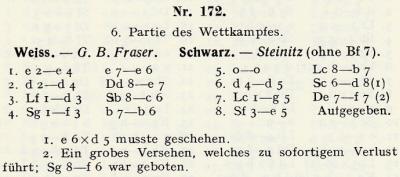
But did Steinitz resign at move eight? Mr Wong notes that when the score was published on page 107 of the Chess Player’s Magazine, April 1867 the conclusion was 8 Ne5 ‘and wins’:
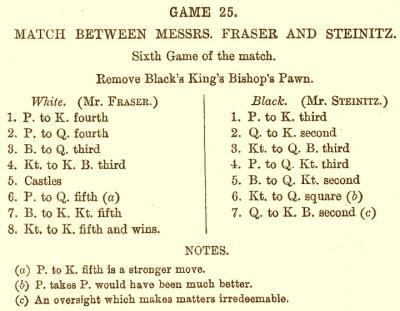
(8779)
From Tim Harding (Dublin):
‘The game was played on 29 January 1867 and was published on 31 January in the Dundee Advertiser, page 3. This was the earliest publication of the game.
After White’s eighth move the newspaper said, “and Mr Steinitz resigns, the queen being lost”.
In general, I have often found with Victorian games that a source may say “and wins” without it necessarily meaning that there were further moves. Sometimes, as here, another source explicitly says “resigns”.’
Our correspondent, it will be recalled, is the author of Eminent Victorian Chess Players (Jefferson, 2012).
(8784)
From page 276 of Ajedrez en Cuba by Carlos Palacio (Havana, 1960):
T. Marrero – F. Melgarejo
Placetas, 1932
Evans Gambit Accepted
1 e4 e5 2 Nf3 Nc6 3 Bc4 Bc5 4 b4 Bxb4 5 c3 Ba5 6 O-O Nf6 7 d4 O-O 8 dxe5 Nxe4 9 Re1 Nxc3 10 Nxc3 Bxc3 11 Ng5 Nxe5 12 Qh5 h6 13 Rxe5 Bxe5 14 Nxf7 Rxf7 15 Qxf7+ Kh8 16 Bg5 Bf6 17 Re1 Resigns.
This seems to have a familiar look to it. Can a reader quote the same moves from another source?
(1364)
Carl-Eric Erlandsson (Lund, Sweden) has come to the rescue: the game was Steinitz v H. Devidé, Manhattan Chess Club, 1890.
(1459)
See Duplication of Chess Games.
From Chess and Alcohol, concerning James Mason:
On page 237 of the August 1890 International Chess Magazine Steinitz described how in the New York tournament Mason ‘forfeited a game “by time” on the eighth move, and on several occasions, to speak in plain language, simply created disgraceful drunken disturbances’.
A further remark by Steinitz:
‘… Mr Mason when he descends from the heights of his obfuscated philosophy into the sober region of fact, has, so to speak, “no leg to stand upon”, which, of course, does not matter much to Mr Mason, who is notoriously rather unfamiliar with that sensation, outside of chess controversy.’
Source: International Chess Magazine, July 1885, page 208.
On page 138 of the May 1890 issue of his periodical Steinitz wrote: ‘Of course, Mr Mason’s manifesto must be taken cum grano whiskey.’ In the September 1885 number (page 265) a tournament reporter recorded being asked by a friend, ‘How is it that Mason has such a good chance of winning the first prize at Hamburg?’ The answer, with a reference to the tournament tail-ender, was, ‘Because he’s keeping Bier a long way off.’
These matters were originally discussed by us in Kingpin.
On the subject of Emanuel Lasker and money, C.N. 1189 gave two quotes, the first of them from a letter he contributed to page 260 of the June 1907 issue of the BCM:
‘The reviewer of the book [Struggle] comments on the lack of success of chess masters in practical life. He argues that the masters of strategy should be able to achieve success in business if my contention – that all contests follow the same strategic laws – is correct. I think that men like Zukertort and Steinitz would have been great in any enterprise if they would have ardently devoted themselves to it. They did achieve their purpose. Probably they never tried to gain wealth, or, at least, they did not try hard, and chessplayers – this reproach cannot be withheld – were content to buy their success as cheaply as they could. A starving man can, of course, not make a fair bargain. They were the victims of circumstance – like Mozart and Beethoven. Does it denote any great business qualities in Paderewski that he makes a hundred times more money than some of his predecessors no less distinguished in their day?’
The second Lasker quote comes from Der Schachwart No. 3, cited in the July 1913 BCM, page 294:
‘If Idealism means the thrusting of mediocrity into the foreground to the disparagement of perfection, and the failure to display any enthusiasm for the idea of chess-play, then Das Wochenschach bears away the palm for Idealism. If, on the other hand, Materialism implies the striving to raise the social position of the chess master, to extend a true understanding of the deep mentality of chess-play, to get the master treated with some recognition of his rights as a man, instead of being neglected in poverty like Morphy [sic], Harrwitz, Neumann, Steinitz, Pillsbury – then I am a Materialist.’
See Chess and Poverty.
Page 471 of the December 1897 BCM quotes from a speech made by Steinitz at New York on 16 October of that year. How we should love to have been there.
‘“Uneasy lies the head that wears a crown”, says the sublime analyst of human nature and character. Mine was not a golden crown, but it was not worthless. Perhaps it might be no more properly compared with a crown of roses, interwoven with all their natural thorns which made my rest uneasy for a greater part of the time. Whatever it was it is now transferred to Mr Lasker, and I can only express a hope that the crown will now be made in reality a golden and yet an easy one, for him or any one else to wear, who may hereafter honourably gain the title of champion. Taking this opportunity, I desire to thank Mr Lasker for having started a similar testimonial in England, and considering that I have ceased to be connected with chess in the old country for 15 years, the generosity of all other English subscribers cannot be too highly commended. To return to my subject, I may state that although I have received such high praise for my labours as an author on the game, I have never been satisfied with myself even in that respect, for this reason: Life has often been compared with a game of chess, and no doubt the comparison fits in many respects, notably in this – that life is now universally recognized among thinking men as a deep scientific study similar to our game, which most unquestionably is a splendid training of our mental powers that govern our thoughts and actions. However, it has been a source of disappointment and dissatisfaction to me for a long time that I myself have never been able yet to give such personal proof of the influence of chess on the reasoning faculties, like the great masters, Buckle and Staunton, who have made indelible marks in the researches of human thought outside of the chess board. The question of the influence of chess on morals has often been discussed, and I may therefore state that our noble game points in the first place to the following moral: Good nature is the first element of a really strong intellect, and there is no really sound human brain without a sound sympathetic heart. Furthermore, that purity of mind is essential to the preservation of intellectual health, not alone among women who recognize truth by instinct, as it may be called, but also among men. In other words, that the virtues as they have been preached by moralists in different ages are based on physical laws which operate at least in our visible existence.’
(Referring to the literary philosophic work Steinitz had in hand.) ‘Many strong reasons prompt me to endeavour to issue such a book as soon as possible, and if I had no other reason it would be this: Since the calamitous breakdown of the mental faculties of Paul Morphy, a prejudice has been created among a great portion of the public against chess as an intellectual exercise. This prejudice was no doubt increased in consequence of my unfortunate confinement at Moscow, and in the interests of chess, as well as in the cause of humanity and toleration, which I intend to advocate, I shall consider it necessary to devote a great part of my attention to literary pursuits of a character which, I feel satisfied, will meet with the approval of thinking men and women all over the world, and will tend to show that the training which I have received in the cultivation of chess has not been lost upon me. To the best of my ability I shall in future endeavour two great causes in a manner which I trust will demonstrate my desire to deserve the patronage of the promoters and supporters of the testimonial fund. Anyhow, your kind action will furnish an additional proof of the maxim that sound and strong minds are governed by kind and sympathetic hearts.’
(1413)
From our scrutiny of Warriors of the Mind by R. Keene and N. Divinsky (Brighton, 1989):
A quote from page 23 about Steinitz (died 1900) is irresistible: ‘One traditionally pictures Steinitz struggling in the trenches. His chess seems almost a symbolic portent of the conflict of the Great War 1914-1918.’ That’s a deep one.
George Stern (Canberra, Australia) writes:
‘When I came across the following passage about F.K. Young by Lawrence J. Fuller on page 503 of Volume I of The Best of Chess Life and Review, my eyebrows went up in disbelief:
“Mr Young was a contemporary of Steinitz, Zukertort and the American champions Mackenzie and Pillsbury, from all of whom he won games which he credited to his system.”
Can it really be that F.K.Y. defeated Steinitz, Zukertort, Mackenzie and Pillsbury? If he did, why is the fact not better known? Why, indeed, did Young himself not boast about it – as a success of his system – in the lattermost of his “Strategetics” series, Chess Strategetics? There are all sorts of other puffery in the “Introductory” to that book, but no mention of victories over world-class contemporaries. Incidentally, I notice that in that book Young made this claim:
“The synthetic method of chessplay ... early received the indorsement [sic] of Emmanuel [sic] Lasker, who, in a personal letter to Mr Edwin C. Howell, collaborator in Minor Tactics, stated that the new method of chess play ‘was replete with logic and common sense’.”
I wonder too whether Young’s claim about Lasker is true. Can you or your correspondents shed any light on either of these matters?’
Finding victories by Young is not easy, though his obituary on page 10 of the January 1932 American Chess Bulletin said that ‘in the middle ’80s, contemporary with George Hammond [sic – G.H. died in 1881], Preston Ware, C.F. Burrille [sic] and Charles B. Snow, he was one of the finest players in America’. In an off-hand queen’s knight odds game in Boston in April 1885 Young was defeated by Steinitz. The game appeared on pages 217-218 of the July 1885 issue of the International Chess Magazine. Steinitz described his opponent as ‘one of the strongest local players’ and believed that he ‘would be too strong for such odds in a serious contest’.
(1886)
On pages 443-444 of The Grand Tactics of Chess (Boston, 1905):
Wilhelm Steinitz – Franklin Knowles Young
Boston, 9 July 1886
King’s Gambit Accepted
1 e4 e5 2 f4 exf4 3 Nf3 g5 4 Bc4 g4 5 Ne5 Qh4+ 6 Kf1 Nh6 7 d4 f3 8 Nc3 fxg2+ 9 Kxg2 Qh3+ 10 Kg1 Nc6 11 Bf1 Qh4 12 Bf4 d6 13 Bg3 Qg5 14 Nc4 Bg7 15 Bf2 f5 16 Nd5 O-O 17 Nxc7 Rb8 18 c3
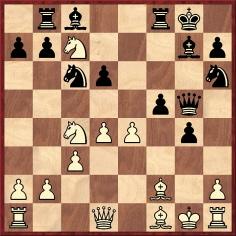
18...g3 19 hxg3 Ng4 20 Qd2 f4 21 gxf4 Qe7 22 Nd5 Qxe4 23 Bg2 Qg6 24 Re1 Be6 25 Nde3 Rxf4 26 Bg3
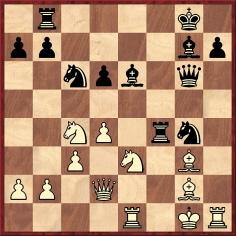
26...Rxd4 27 cxd4 Bxd4 28 Rh4 h5 29 Rxg4 Qxg4 30 Bf2 Qf4 31 Nd5 Qxf2+ 32 Qxf2 Bxf2+ 33 Kxf2 Rf8+ 34 Kg3 Nd4 35 Nxd6 Rd8 36 Ne4 Kg7 37 Nec3 b6 38 Nf4 Bf7 39 Kh4 Kh6 40 Re5 Rg8 41 Bd5 Rg4+ Drawn.
But on pages 138-139 of Field Book of Chess Generalship it is claimed that there was a much prettier finish and a different result:
26...Nge5 27 dxe5 Qxg3 28 Qe2 Rbf8 29 exd6 Bxc4 30 Nxc4 Nd4 31 cxd4 Bxd4+ 32 Ne3
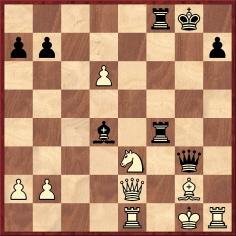
32...Rf1+ 33 Rxf1 Bxe3+ 34 Qxe3 Qxe3+ 35 Kh2 Qe5+ 36 Kh3 Rxf1 37 Rxf1 Qxd6 and Black won.
(1911)
On page 229 of the October 1911 American Chess Bulletin, Emanuel Lasker responded to a charge that he had written an article in bitterness:
‘... Possibly in writing the article, I thought of Morphy, Mackenzie, Steinitz and Pillsbury. The reflection upon their life is not an agreeable one to me. They were pathfinders, yet their lot was a hard one. They got flattering notice, but received no practical support. And their talents were never sufficiently utilized. A good use might have been made of these men as teachers. Morphy or Steinitz, explaining their theory as to the mode of thinking appropriately, would have been worthy the attention of philosophers. They remained silent, because they were never asked. The curiosity of the men around them was aroused by the question how strong they were and how many games they might be able to play simultaneously or blindfolded, and how they could perform this tour de force or that one. Their real excellence, which was the result their having discovered principles of wide application by no means restricted to chess, was probably not even guessed. At any rate, the chess world did not make the effort to make the two great thinkers speak, and the highly beneficial work which they naturally would have performed if they had been coaxed into action remained undone. The splendid soil of their inner consciousness was allowed to lie uncultivated and to yield far from enough fruit for others.
(1898)
Retirement from Chess includes the following:
As quoted in C.N. 1215, on page 359 of the December 1891 International Chess Magazine Steinitz wrote:
‘... I beg to state that I shall most probably adhere to my intention of retiring from active play altogether, but I do not wish to stand pledged either way.’
C.N. 4160 added a passage from page ix of The Games of the St Petersburg Tournament 1895-96 by J. Mason and W.H.K. Pollock (Leeds, 1896):
‘Steinitz himself, in the Figaro, so far back as 1878 – when he was contemplating retiring from chess – claims that his record was then better than Morphy’s, but left the question of genius an open one.’
Further details about these matters are still being sought.
‘Steinitz played Jack the Ripper’
The lurid headline above could, just possibly, be true. The Ripper & The Royals by Melvyn Fairclough (London, 1991) set out to demonstrate that Jack the Ripper was Winston Churchill’s father, Lord Randolph Churchill (1849-95). From page 89:
‘He further proved his ability to plot ahead when he became a first-class chess player. He once played against the chess champion of the world in a game described by Winston as ‘original, daring, and sometimes brilliant’.
The score is to be found on page 257 of part 1 of Schachmeister Steinitz by Ludwig Bachmann (Ansbach, 1910):
Wilhelm Steinitz (blindfold, simultaneous) – Lord Randolph
Churchill
Oxford, 17 May 1870
King’s Gambit Accepted
1 e4 e5 2 f4 exf4 3 Nf3 g5 4 h4 g4 5 Ne5 Qe7 6 d4 d6 7 Nxg4 Qxe4+ 8 Qe2 d5 9 Ne5 Nh6 l0 Nc3 Bb4 11 Qxe4 dxe4 12 8xf4 Nf5 13 O-O-O Bxc3 14 bxc3 Nd6 15 c4 f6 16 c5 fxe5 17 Bxe5 Nf7 18 Bxh8 Nxh8 19 Re1 b6 20 Rxe4+ Kd8 21 Bc4 Bb7 22 Rg4 Ng6 23 h5 Ne7 24 Re1 Nbc6 25 d5 Nb4 26 c6 Bc8 27 Rg7 Nbxc6 28 dxc6 Nxc6 29 Bb5 Bb7 30 Rd1+ Ke8 31Rxc7 Kf8 32 Rf1+ Kg8 33 Bc4+ and Black is mated in a few moves.
Bachmann also gives (pages 258-259) a drawn consultation game, played in Oxford in August 1870, between Steinitz and Anthony, Churchill and Ranken.
Steinitz himself wrote an admiring sketch of Lord Randolph Churchill (and another parliamentarian, Charles Bradlaugh) in the New York Tribune of 4 February 1891, a text subsequently reprinted on pages 4-6 of the January 1891 issue of the International Chess Magazine. The obituary of Lord Randolph Churchill on page 82 of the February 1895 BCM reported that from his early college days to the beginning of his political career the deceased was, in his own words, ‘an ardent chessplayer’. Further information, including details of Winston Churchill’s enthusiasm for chess, is given on pages 89-90 of King, Queen and Knight by Norman Knight and Will Guy (London, 1975).
This is hardly the place for a discussion of the claim that Lord Randolph Churchill perpetrated the Whitechapel murders of 1888. It need merely be stressed that countless Victorian notables have been accused of involvement by one ‘Ripperologist’ or another.
(Kingpin, 1993)
A footnote on page 314 of Kings, Commoners and Knaves:
Steinitz suggested ironically that the chessplayer and poet Wordsworth Donisthorpe could have been Jack the Ripper. See, in particular, the following issues of the International Chess Magazine: October 1889, page 298; November 1889, pages 333-334; December 1889, page 370; January 1890, page 11.
Another name that has been bandied about in connection with the Whitechapel murders is the heir presumptive to the British throne, the Duke of Clarence (1864-92). Page 64 of the February 1892 BCM contained a notice of his death, though with no chess connection made. Page 24 of the Chess Player’s Annual and Club Directory of 1893-94 reported the Prince’s death and added:
‘The sad event took place on 14 January. The congress of the Hibernian Chess Association, then being held, was immediately adjourned for a week, and the leading chess organs, in common with everyone of Her Majesty’s subjects, expressed profound regret and sympathy. The prince, like most members of the royal family, was a lover of chess, and patronized some of our chess associations.’
(Kingpin, 1999)
The comment below was given on page 387 of Kings, Commoners and Knaves:
‘Of my opponent I am oblivious. For all that I know or note, he might as well be an abstraction or an automaton.’
Steinitz, BCM, September 1894, page 366, from an interview in the St Louis Globe.
A feature on page 107 of the April 1885 issue of the International Chess Magazine:
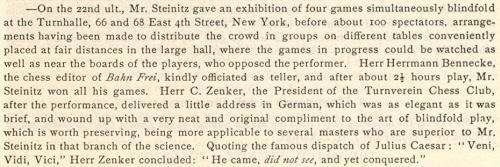
(6539)
With respect to the last sentence (and the claim of originality), we now note a report on page 154 of the Westminster Papers, 1 December 1873:
‘Mr Blackburne’s blindfold performance was on this, as on previous occasions, an unqualified success. Against ten opponents he won six games, drew three and lost but one, after a contest of over eight hours. He came, he did not see, but he conquered.’
(7616)
From Brad Thomson (Ottawa, Canada):
‘While preparing an article (published on pages 34-39 of the June 1994 En Passant) on the 100th anniversary of the Lasker v Steinitz match, which concluded in Montreal, I noticed that the three sources I was using did not agree at one point. In game 17, Steinitz’s last victory, the following position arose:
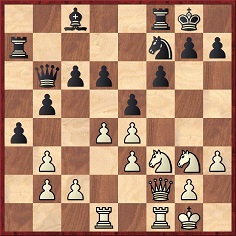
C. Devidé’s book on Steinitz gives Lasker playing 21 Ne1 c5 22 Qd2 Be6 23 b4 Qc7, and now 24 d5, at which point all sources agree again. But the move order given in The World Chess Championship: Steinitz to Alekhine by P. Morán and in the Weltgeschichte volume on Lasker is 21 b4 Qc7 22 Ne1 c5 23 Qd2 Be6 and now 24 d5, whereupon the transposition is complete.’
We add that the logical latter version is supported by such contemporary sources as the Deutsche Schachzeitung (July 1894, page 202), the BCM (July 1894, page 300) and the Chess Monthly (July 1894, pages 335-336).
(2071)
‘Signor C. Salvioli has reclaimed the birthright of chess literature for Italy. Without exception the first volume of his Teoria e Pratice [del giuoco] degli Scacchi as a collection of games alone is the most valuable chess book extant in any language’.
W. Steinitz, on page 83 of the March 1885 issue of the International Chess Magazine.
(2165)
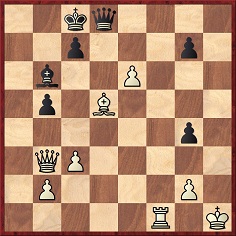
C. Golmayo-E. Hidalgo, Havana, 1885
White (who had given the odds of his queen’s knight) dealt with the mating threat by playing 1 c4 Qh8+ 2 Qh3 gxh3 3 e7 hxg2+ 4 Kxg2 ‘and wins’, according to the Brooklyn Chess Chronicle, which offered these variations:
a) If 1 Rf3, Black mates in five, beginning with 1…Qh4+.
b) 1 c4 Qh4+ 2 Qh3 gxh3 3 Rf8+ Qd8 4 e7, and White wins.
c) 1 c4 Qh8+ 2 Qh3 gxh3 3 e7 Bc5 4 Bc6 Bxe7 5 Ra1, and White wins.
Steinitz then reprinted the position in his International Chess Magazine, describing it as a ‘beautiful termination’. He added 1 g3 Qh8+ and mate next move, and wrote that Black should have answered 1 c4 with 1…c6, ‘whereupon White could not have saved the game’. However, subsequently (and, characteristically, at the first opportunity) he admitted correction by the Chronicle, which pointed out that 1…c6 allowed White to win by 2 Qg3. By then, though, the Chronicle had made a further discovery of its own, namely that in case of 1 c4 Qh8+ 2 Qh3 gxh3, the move 3 e7 would only draw after 3…Qh5. It nonetheless maintained that White had a win, with 3 Ra1 instead of 3 e7.
Sources: Brooklyn Chess Chronicle: 15 May 1885, page 120; 15 June 1885, page 133; 15 July 1885, page 151. The International Chess Magazine: June 1885, page 185; July 1885, page 222.
(2249)
The follow-up material [in the Brooklyn Chess Chronicle and the International Chess Magazine] was overlooked when the March 1908 Lasker’s Chess Magazine, page 227, published a full-page feature criticizing the 1885 analysis.
(4138)
Lasker’s criticism had appeared in his New York Evening Post column on 22 January 1908, page 12.
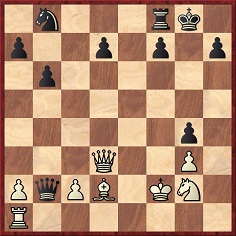
The above position is from a consultation game between Steinitz (White, to move) and Lyman and Richardson. Steinitz won with 1 Bc3 Qa3 2 Rh1 f5 3 Qc4+ Rf7 4 Rxh7 Qc5+ 5 Qxc5 bxc5 6 Rh8 mate.
It was later pointed out by three readers of the International Chess Magazine that a more elegant win would have been (1 Bc3 Qa3) 2 Qxh7+ Kxh7 3 Rh1+ Kg6 4 Nf4+ Kf5 5 Rh5+ Ke4 6 Re5 mate.
Sources: the International Chess Magazine, January 1885, page 27 and February 1885, page 57.
(2263)
‘Of course, such literary trickeries are nothing new to me, and I have been used to it for 20 years that according to the constructions in certain journalistic quarters everybody in turn was the champion during that period, excepting myself. The only consolation I had was that most of the defeats I suffered occurred in my own absence.’
Steinitz, writing in the International Chess Magazine, September 1887, page 265.
(2326)
From page vii of Part II of The Modern Chess Instructor by Steinitz:
‘One of the principles laid down in Part I of this work is that the Knight is stronger than the Bishop.’
The final page had an erratum:
‘On page vii of Preface top line read: The Bishop is stronger than the Knight.’
(2348)
An observation by R.C. Griffith on page 155 of the April 1932 BCM:
‘It is most unfortunate that there always seems to be bickering between reigning and past champions. This has been the case for many decades, and it is for this reason that we so strongly advocate that the arrangements for the championship should be in the hands of the FIDE. If the patrons of chess who help to put up the necessary finance would agree that they would only do so through the FIDE, it is possible that our suggestion may be practical politics earlier than we anticipate.’
Steinitz demonstrated his outstanding eloquence and debating skills on umpteen occasions, and was seldom in the wrong. (His writings indicate that he was one of the most intelligent and honest of all the world champions.) He regularly expressed the view that tournaments had much less significance than matches, and during an argument with G.H. Mackenzie about a possible match he wrote (on page 333 of the November 1887 International Chess Magazine):
‘For my part, I would have been satisfied if he had called himself the International tournament champion and had left me the International match championship until such time when he was prepared to contest it, or until I otherwise forfeited my claim.’
‘We have two champions!’, commented La Stratégie of 15 November 1894 (page 357) after quoting a letter dated 10 October 1894 which was signed by ‘W. Steinitz, Chess Champion of the World’. Steinitz was addressing Lasker, reclaiming from him the title he had just lost, on the grounds that Lasker was refusing the agreed rematch:
‘No doubt you could retain the champion title, and prevent your ever being beaten on the checkered board, if the precedent were to be established that the champion could quite alone choose his own time of playing again, and break a positive agreement for a match, first on the plea of “a tour round the world”, and next of “chess and other engagements”, which it was your pleasure to enter into subsequently, instead of making preparations to fulfil your previous promise. But the general public will probably allow that I, as well as my backers, may hold a different opinion on the subject, and I shall therefore take the fullest responsibility of retaining the champion title, which you have forfeited by your letter of 22 June, after the expiration of the time of grace which I gave you for reconsideration.’
(2407)
From Chess and Jews:
‘Dr Hermann Adler and Steinitz’, on page 367 of the Chess Amateur, September 1911:
‘Mr Sharp, chess editor of the Reading Observer, gives a very interesting account of the connection of the late Dr Hermann Adler (Chief Rabbi) with chess. In his younger days, in common with so many learned Jews, he was very fond of chess. Lasker, of course, it is well known, is a Jew, and that great man Steinitz was of the same persuasion. Wilhelm Steinitz once expressed the opinion that the reason why Jews are so clever at chess is because of their patience, pure breeding, and good nature. Having been the most persecuted race in the world, they have had the least power to do harm, and have become the best natured of all peoples. Their religion, also, is a factor which contributes in the same direction, because it is combined with persecution to preserve their morals and good nature. Then the purity of their breed, as Steinitz asserted, largely helps the Jews in every walk of life, and contributes to their remarkable success, even in the science of chess …’
More particulars are sought on the above statements by Steinitz.
It tends to be forgotten that in 1866 there was some criticism of Steinitz’s wish to play a match against Anderssen. For example, the following appeared on page 379 of the February 1866 issue of the Chess World:
‘… the error committed by Mr Steinitz in consenting to this match is as nothing compared to that which he is rumoured to have in contemplation, to wit, the challenging of Mr Anderssen to a contest, upon even terms, for £100 a side! We suspect, however, and hope that this absurd report will prove to be an idle hoax.’
‘This match’ was a reference to Steinitz’s encounter with De Vere, in which he gave the odds of pawn and move. De Vere won with a score of +7 –3 =2.
(2508)
From Luck in Chess:
W. Steinitz on page 236 of the August 1886 International Chess Magazine:
‘Anderssen once said to me: “To win a tournament, a competitor must in the first place play well, but he should also have a good amount of luck.” I quite agree with that, but it naturally follows that there must be also ill luck in tournaments, of which many instances could be cited, notably that of Winawer, who, after having tied for first and second prizes in Vienna, and just a few weeks before he came out chief victor in Nuremberg, did not win in London a single prize out of eight (to include the special one for the best score against the prize-holders). All this would tend to show that, at least, a single tournament, especially one consisting of one round only, cannot be regarded as a test.’
On page 37 of the Autumn 1993 Kingpin we commented that the Landsberger work was ‘often poorly written and edited’. From page 253 of the book:

Louis Blair (Knoxville, TN, USA) points out that four passages on page 36 of William Steinitz, Chess Champion by Kurt Landsberger (Jefferson, 1993) repeat, almost word for word, material in the Preface to Championship Chess by P.W. Sergeant (London, 1938). However, whereas Sergeant wrote that Steinitz ‘did not claim any title when he defeated Anderssen in a match in 1866’, Landsberger asserted, ‘When Steinitz defeated Anderssen he announced that he was the world champion’.
Page 123 of the American Chess Magazine, September 1899, quoted a remark by Steinitz in the Glasgow Weekly Herald:
‘No great player blundered oftener than I have done. I was champion of the world for 28 years because I was 20 ahead of my time. I played on certain principles, which neither Zukertort nor anyone else of his time understood. The players of today, such as Lasker, Tarrasch, Pillsbury, Schlechter and others have adopted my principles, and as is only natural they have improved upon what I began, and that is the whole secret of the matter.’
(Kingpin, 1995)
Steinitz wrote at length about Staunton on pages 210-213 of the July 1888 International Chess Magazine. Below is a digest of salient quotes:
‘… this very Mr Staunton had made himself notorious as the literary persecutor of Harrwitz, Löwenthal and Anderssen, whom he assailed with personal hostilities in his various writings including actually the annotations of games.’
After writing that Staunton had ‘tortured poor Morphy’ over the possibility of a match between them, and in particular Staunton’s suppression of a key paragraph in a Morphy letter, Steinitz referred to ‘my having received similar treatment at the hands of this Mr Staunton’.
‘This Mr Staunton was one of my first opponents in the Literary Steinitz Gambit and an editorial patient whom I had to cure … from his journalistic delusions …’
‘At that very time this Mr Staunton was again the almighty ruler of public opinion in the chess world and his performance against Morphy was remembered only by very few. In his usual manner he commenced attacking my play; a mode of warfare which, I can assure you, always left me indifferent. But finding that this did not draw sufficiently, he made during my match with Bird an assault on my private character by means of what I may call at least a combination of suppressio veri and suggestio falsi …’
‘… judging from the effect which the first shots from these journalistic batteries had on myself, I have always suspected, that Morphy’s subsequent apathy and hatred for chess, which was, I believe, not alone the first symptom but also the cause of decay of his powerful genius, must have originated from the treatment which he received from that Mr Staunton …’
Regarding his own grievance (the ‘falsifications in the Illustrated London News’) Steinitz contacted Staunton both publicly and privately:
‘My move turned out a very good one, I can assure you, for its first effect was that this very Mr Staunton, who had the audacity of mutilating one of Morphy’s letters and of refusing to publish the letter’s correction of false statements until a Right Honorable Lord interfered on his (Morphy’s) appeal; this very Staunton felt compelled to publish my letter in full the very next week, though with an alteration of the date in order to make it appear to some innocent people that I had used the “strong language” before writing the letter ...
The result of the publication of the letter was that though Staunton with his satellites and suckers tried with might and main to expel me [from the Westminster Chess Club], as I had of course anticipated, he soon discovered that he would not find the usual two-third quorum for such a purpose.
... This is my analysis of my first Club fight or contempt without silence gambit, which was a victory for me … Proof of my statement is that with the exception of two or three growling articles … I enjoyed complete literary peace for the rest of his life, about seven years long, from this very Mr Staunton, who had always fancied that he could aggrandize himself by assailing his rivals with the grossest falsehoods.’
(Kingpin, 1999)
See Attacks on Howard Staunton.
We have been unable to find game-scores which fit in with the following report, taken from page 315 of the Chess Amateur, July 1908:
‘Referring to “hallucinations that occur in match and tournament play”, Mr Bruno Siegheim mentions in the Johannesburg Sunday Times that in one of the games of the Blackburne-Steinitz match, a check which could have won a rook was left on for several moves. The possibility was seen by everyone present in the room except the two players. Mr Siegheim adds that a still more curious incident occurred at Breslau, in an Alapin-Blackburne game. Mr Blackburne checkmated his opponent, but assuming that Herr Alapin would see the mate, Mr Blackburne did not announce it. Herr Alapin looked at the position intently, trying to find a move, and the spectators smiled and whispered. At the end of five minutes Mr Blackburne relieved his opponent’s anxiety by informing him that he had been checkmated.’
(2557)
On 16 October 1897 Steinitz was the beneficiary of a testimonial concert in New York and had to endure an adulatory address by Edward Hymes. One sentence will be enough here:
‘Steinitz is to chess the man of all men, not of this generation nor of the past, but of all time.’
Source: American Chess Magazine, October 1897, page 265.
(3232)
From the entry on G.H.D. Gossip in The Oxford Companion to Chess:
‘He had an unusual talent for making enemies. In his later years Steinitz had the same problem but claimed at the end of his life that he had six chess friends. Gossip had none.’
The grounds for the statement about Gossip are unknown to us, but the other remark seems to be based on R.J. Buckley’s reminiscences about Steinitz referred to in our Chess with Violence article:
‘We never quarrelled. Colonel Showalter [at the London, 1899 tournament] said that he and I were the only exempts. To which Steinitz replied, “No, there are four more, six altogether. From any one of those six I would accept a cigar, and from none other”.’
(3249)
Concerning London, 1899 below is an excerpt from a description of London, 1899 on pages 210-213 of La Stratégie, 15 July 1899 (in our translation from the French). The writer is identified only as ‘André de M.’.
‘The admirers of the veteran Steinitz would have liked to see the old champion obtain a better result than the one he achieved. Even so, his lack of success seems not to have disturbed him too much. On his table Steinitz always had a carafe of pure water, from which he drank large glassfuls while smoking his cigar, which, absent-mindedly, he generally set down, still alight, on the green baize covering the table.’
Where Did They Live? gave these addresses for Steinitz:
2 Princes Street, St Giles without Cripplegate, London, England (1871 British census (C.N. 4756)).
11 Newton Street, Shoreditch, London, England (1881 British census (C.N. 4756)).
328 Classon Avenue, Brooklyn, USA (William Steinitz, Chess Champion by K. Landsberger, pages 173 and 198). Also page 51 of The Steinitz Papers by K. Landsberger, although 318 Classon Avenue was given on page 52.
986 Fulton Street, Brooklyn, USA (William Steinitz, Chess Champion by K. Landsberger, page 198 – see also pages 266-268).
505 26th St., Manhattan, New York, USA (1900 US Federal Census).
A position from page 41 of Les échecs dans le monde by Victor Kahn and Georges Renaud (Monaco, 1952):
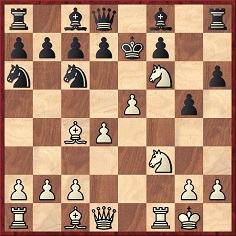
White to move
This is stated to be from a game between H.N. Pillsbury and E.F. Wendell in a simultaneous exhibition on 40 boards in Chicago, 1901, the finish being 12 Nxg5 hxg5 13 Qh5 Rxh5 14 Ng8+ Ke8 15 Bxf7 mate.
Did Pillsbury win such a game? The following score was given on pages 319-320 of volume one of the second edition of Schachmeister Steinitz by L. Bachmann (Ansbach, 1925):
Wilhelm Steinitz – N.N.
London, 1873
(Remove White’s rook at a1.)
1 e4 e5 2 f4 Nc6 3 Nf3 Nf6 4 fxe5 Nxe4 5 d3 Nc5 6 d4 Na6 7 Bc4 Qe7 8 Nc3 h6 9 O-O g5 10 Nd5 Qd8 11 Nf6+ Ke7 12 Nxg5 hxg5 13 Qh5 Rxh5 14 Ng8+ Ke8 15 Bxf7 mate.
(3288)
See too page 230 of the City of London Chess Magazine, October 1874, where the Steinitz game was annotated by Zukertort.
From page 65 of part one of Garry Kasparov on My Great Predecessors (London, 2003), concerning the 1886 world championship match (ten games up) between Steinitz and Zukertort:
‘There was an important nuance: with a score of 9-9 the match would be considered to have ended in a draw, since the players did not want the outcome of such an important duel to rest on the result of one game. Such a rule was to apply later in a number of unlimited matches for the world championship, and it became a stumbling-block in the years when Fischer was champion (as will be described in a later volume).’
It is indeed true that Steinitz and Zukertort’s contract (29 December 1885) stipulated:
‘The Score at Nine Games. Should the score stand at nine (9) games won to each of the players, then the match shall be declared drawn.’
Source: Chess Monthly, January 1886, pages 136-137.
However, on page 118 of the May 1886 International Chess Magazine Steinitz reported that this provision had been amended before the final series of games began in New Orleans on 26 February 1886:
‘Two of the conditions of the match [one of them omitted here, being a minor matter concerning playing hours] were altered by mutual consent of the players, who had agreed, in the first place, to reduce the score, which rendered the match a draw, to eight all, instead of nine all, as previously stipulated. There can be no doubt that both the principals acted bona fide and chiefly in the interest of their backers in agreeing to such a modification of the original terms of the match, for their main reason in adopting the alteration was to exclude all element of chance as much as possible and to avoid rispgg the issues at stake on the result of two games. But, on consideration and in order not to establish a questionable precedent, we feel bound to say that the opinions of some critics, who, without in the least impugning the motives of the two principals, have expressed doubts on the legality of such proceeding, now appear to us reasonable. For it is justly contended that the two players had no right to alter any of the main conditions of the match without consulting their backers, who had deposited their stakes after the chief terms had apparently been finally settled …’
(3324)
Item 264 (unnumbered page) from Napier’s Amenities and Background of Chess-Play (published in three ‘units’, the first two in 1934 and the third the following year)
‘I never see a King’s Bishop Opening without thinking of the first of several lessons I took, when a youngster, from Steinitz. He said, “No doubt you move your knight out on each side before the bishop? And do you know why?” I was stuck for an intelligent answer. He went on to say, “One good reason is that you know where the knight belongs before you know that much of your bishop; certainty is a far better friend than doubt.”’
Emanuel Lasker expressed the following view in an autobiographical article in Lasker’s Chess Magazine, May 1908, page 1:
‘The last tournament held there [in England] was in 1899. The continent has had more than a dozen meanwhile. England has not been the playing ground of a match for the championship of the world since Steinitz beat Anderssen, in 1866.’
The inescapable implication of Lasker’s references to England and to 1866 is that he considered a) that Steinitz’s matches against Zukertort (1872) and Blackburne (1876), both of which took place in London, were not for the world title and b) that, consequently, Steinitz held the world title for 20 years (1866-86) without defending it at all. It is hard to imagine, though, that this was the meaning that Lasker intended to convey.
(3325)
C.N. 3325 gave a series of quotes illustrating various contemporary writers’ views on when Steinitz became world champion. The clearest statement we have seen from Steinitz himself was quoted in his 14 August 1900 obituary in the New York Times, from a pamphlet entitled My advertisement to anti-Semites in Vienna and Elsewhere:
‘And since 1895 I have been obliged at an advanced age and while I was half crippled to export myself in order to import only a portion of my living for myself and family, and this portion did not amount to $250 per annum within the last two years when I deduct traveling expenses and increased cost for staying abroad, although I was chess champion of the world for 28 years!!!’
We also now add a paragraph from page 50 of the Chess Player’s Chronicle, 18 July 1883, i.e. shortly after Zukertort won the London, 1883 tournament, three points ahead of Steinitz:
‘The chess championship of the world is a subject which will form a topic of discussion in the chess press for some time to come. The last issue of the Bradford Observer contains some remarks on it. The writer argues that Zukertort may hold the title and yet be “quite right in refusing to enter into so hard an engagement” (the match recently proposed is referred to) “after the trial he had to go through in the International”. We disagree. It is very certain that Steinitz was, at one time, fairly entitled to the position of champion, and under such circumstances would hold it so long as he could defend himself against all comers. He has just taken an inferior place to Zukertort, in a tournament, and for the time being Zukertort, in the opinion of some, becomes champion, but if he desires to hold that title he must defend himself against all comers; so soon as he declines to play a match, unless under very exceptional circumstances, he loses his position, and this is more particularly the case when his would-be opponent happens to be the man who for years past has been recognized as the champion. A tournamental advantage is not considered of much moment as regards the chess championship, and unless it can be maintained by after play we should be inclined to dismiss it as one of the freaks of fortune. Steinitz has challenged the only man who has beaten him since he has been chess champion; if he will not play, then Steinitz will be right in resuming his old title.’
A noteworthy point is that the item made no mention of Morphy, who was still alive.
(3750)
Russell Miller (Chelan, WA, USA) quotes from page 169 of the Brooklyn Chess Chronicle, 15 July 1883:
‘The Glasgow Herald furnishes the following intelligence: “Some important results are likely to spring from the positions occupied in the International Tourney by the ultimate prize winners. We understand that Steinitz is about to challenge Zukertort to play a match for the sum of £300 to £500 and the championship of the world, and it is the opinion of some who are in a position to judge of the matter that the match will come off.”’
Noting that Zukertort was reported by the Brooklyn Chess Chronicle to have turned down the match because he intended ‘to make a year’s tour’, our correspondent asks if Steinitz called himself world champion at that time.
Steinitz’s proposal of a match was reported on page 323 of the July 1883 Chess Monthly (edited by Hoffer and Zukertort):
‘Mr Steinitz has authorized Mr Steel to communicate with Mr Minchin with reference to a match which he seems willing to play with Mr Zukertort. The conditions are £200 a side or more if agreeable; the match to consist of eight or ten games; three or four games to be played a week; £50 to be deposited as forfeit money; and play to commence between October and January. Mr Zukertort has authorized Mr Minchin to reply to Mr Steel that he cannot make arrangements for a match at such a remote future.’
This does not seem an altogether fair reflection of Robert Steel’s letter to Minchin (dated 24 June 1883, the day after the London, 1883 tournament ended), which was published on page 42 of the Chess Player’s Chronicle, 11 July 1883:
‘... The following are the conditions for the match suggested by Mr Steinitz. If they be approved by Mr Zukertort, any minor conditions may be easily arranged.
1. That the winner of the first eight or ten games be the victor.
2. That the games be played under a time-limit of 15 moves per hour.
3. That play shall be carried on either three days or four days per week, as Mr Zukertort prefers.
4. That Mr Steinitz will accept any suggestion of Mr Zukertort’s as to the hour of the day when play shall commence.
5. That the time for commencement of the match shall be fixed for any date between 1 October and 1 January, which may best suit Mr Zukertort.
6. That the stakes be for any sum not less than £200 a side which Mr Zukertort prefers.
7. That the games shall be the property of both players.Mr Steinitz is of opinion that the contest should, in the interest of both players, take place in a private room, and that admission should be allowed to friends of both parties.
Mr Steinitz is prepared to make an immediate deposit of £50, to bind a match on the basis herein suggested.’
Minchin’s reply to Steel, dated 27 June 1883, was given on the following page of the Chronicle:
‘... [Zukertort] begs me to point out to you that owing to his health and avocations he has always, as Mr Steinitz is aware, refused to bind himself down to play a match of chess at any future period. He cannot, therefore, now accept the conditions offered of binding himself to play at any time between October and January next. As a fact, I fear that Dr Zukertort will not be in England at that period, as I believe he purports starting almost immediately on a protracted tour round the world.
I have no doubt that on his return from this tour Dr Zukertort will be quite ready to make a match with Mr Steinitz on reasonable conditions, such as those offered, to promote which, when the time arrives, I shall be happy to use my good offices.’
It will be noted that no reference to the world championship occurred in these exchanges. However, it was evoked in a follow-up item in the next issue of the Chronicle (18 July 1883, page 50). We quoted it in full in C.N. 3750.
(4163)
From Chess and Music:
Steinitz related an encounter with Richard Wagner on page 213 of the International Chess Magazine, July 1887, page 213.
A further illustration of the ‘once’ school of narrative comes from page 24 of Curious Chess Facts by I. Chernev (New York, 1937):
‘Steinitz was once arrested as a spy. Police authorities assumed that the moves made by Steinitz in playing his correspondence games with Chigorin were part of a code by means of which important war secrets could be communicated.’
The identical paragraph appeared on page 31 of Chernev’s Wonders and Curiosities of Chess (New York, 1974), whereas on page 89 of The Fireside Book of Chess by I. Chernev and F. Reinfeld (New York, 1949) the wording was slightly different:
‘Steinitz was once misjudged to be a spy. Police authorities assumed that the moves made by him in playing his correspondence games with Chigorin were part of a code by means of which important war secrets could be transmitted.’
We have yet to find any such incident mentioned in contemporary reports on the two-game cable match in 1890-91 between Steinitz and Chigorin, about which, incidentally, the then world champion wrote on page 107 of the April 1891 International Chess Magazine:
‘Never before in the history of our pastime has a chess contest created such widespread and literally universal interest during its progress as the one just concluded between myself and Mr Chigorin.’
We would, though, draw attention to the following passage by Walter Penn Shipley in the Philadelphia Inquirer, as quoted on page 62 of the American Chess Bulletin, March 1918:
‘We note in the daily papers a curious break in the affairs of Lorenz Hansen, a Dane, but who has been in this country for many years and is a naturalized citizen. Lorenz Hansen has been for many years an enthusiastic chessplayer and an able problem composer. We have published many of his problems in this column, and some of exceptional merit. Lorenz Hansen was recently arrested on a technical charge, the Federal authorities believing that he had a secret code and was communicating with someone at Grand Rapids, Mich. On further examination the secret code appears merely to have been a harmless correspondence game of chess, the moves, as usual, being sent by postal card. It is unnecessary to state that when the true state of affairs became known Mr Hansen was promptly released.
This adventure recalls one of the late William Steinitz. When he played his second match with Lasker at St Petersburg, before leaving this country Steinitz arranged an elaborate code whereby at slight expense he could cable the moves in his match to a syndicate of New York newspapers. Steinitz received a liberal compensation for his work. The old man had spent a great deal of time on perfecting his code, but unfortunately on arriving in St Petersburg the authorities promptly confiscated the code, stating that it was impossible to believe that it was merely for the purpose of cabling chess moves and in reality was to give secret information to parties in America. Being thus deprived of his code, he was unable to cable the moves of his match, and thereby lost the fruit of many months’ hard labor. At the termination of the match the code was returned to Steinitz by the Russian authorities, stating they had found it to be as represented, but then, of course, it was too late to be of any use to the world’s master. Steinitz’ breakdown was unquestionably partially due to his great disappointment in this matter.’
What truth there is in any of the above we have no idea, and for now we merely point out that the second match between Steinitz and Lasker was held in Moscow, not St Petersburg.
(3345)
A paragraph from page 468 of the December 1896 BCM:
‘The long-expected return match between Messrs Lasker and Steinitz, for the championship of the world, began at Moscow, on 7 November, having been delayed a few days owing to a political difficulty. Mr Steinitz had arranged to telegraph the games to America in cypher, which cryptogram, however, had to be submitted first to the censorship of the Russian government, and it took some time to convince the authorities that there was nothing nihilistic in the mysterious messages to be sent.’
(6699)
From page 145 of Chessreading Treasure by Wilf Holloway (Nörten-Hardenberg, 1993):
‘In New York in 1893 [sic – 1894] Wilhelm Steinitz lost a game against Adolf Albin and this was not only unusual because Steinitz was generally the better player. That game also went down in history for another reason – it was the first ever recorded grandmaster time claim win. Despite a clear rule it was then still considered unsporting to claim a win, but with an otherwise lost position Albin stuck up for his rights when his opponent overstepped the limit. One must actually ask oneself what is more unsporting, deliberately taking more time than one is allowed or appealing against this sort of thing to avoid being disadvantaged? We see things more clearly perhaps these days but Albin was considered to be a cad that day. Aren’t people strange?’
Regarding the finish to this game, below is the account published on pages 107-108 of the December 1894 Chess Monthly, although caution is invariably required over the Monthly’s writings about Steinitz:
‘Practically, Steinitz only drew one game, against Hymes, whilst he lost one game by exceeding his time in the game with Albin. He ought to have lost this game on its merits, but in the end he had the best of it. An appeal was made to the committee by Steinitz against their decision of scoring the game against him, but the committee maintained their decision, and justly so. It is difficult to see why he should have protested at all; and, if we are not mistaken, Steinitz himself was not slow to avail himself of any infringement of the time-limit rule on former occasions. At the Vienna tournament, 1882, he claimed the game from Winawer when, to ascertain whether the hand of Winawer’s clock had passed the hour, the blade of a penknife had to be used. The eye, unaided by any instrument, could not detect that the hand had passed the figure upon the dial; further, in the same tournament, Bird, who did not take down the game, was under the impression that Mason had exceeded his time, and stopped the game. Upon remonstrance on the part of Mason, the game proceeded, and was won by Mason. Subsequently an agitation by interested competitors was got up (Steinitz amongst them), the matter was brought before the committee, and the game was scored against Mason. In the game with Albin, Steinitz had consumed his allotted two hours for 33 moves instead of 36. It is quite clear that he could not make three more moves in no time; his game was therefore forfeited by the rule governing the time-limit, and he should have resigned the game without protest.’
As noted on page 172 of the Vienna, 1882 tournament book (published by Olms in 1984), another casualty in that event was Noa, who overstepped the time-limit against Zukertort as early as move 15.
(3370)
In the Scientific American Supplement, 29 September 1877, page 1454 Sam Loyd had presented:
‘… a portrait of Mr Steinitz as we sketched the little giant half a score of years ago while he was working out a problem to draw with a bishop against knight and pawn.’
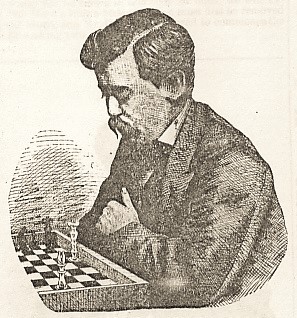
‘As we progress … with our proposed record of the important chess events of the past, it will be readily understood why, by common consent, Mr Steinitz has become to be looked upon as the recognized chess champion of Europe.
We have enjoyed the most friendly relations with Mr Steinitz and found him the very pink of honor, and the most jovial little fellow in the world, ready to fight you at chess, or die sooner than give up on some little etiquetical point that he considers correct and proper. His able management of the chess department of the London Field is gaining him a world-wide reputation as the analyst of the day.’
(3397)
Michael McDowell (Westcliff-on-sea, England) writes:
‘The woodcut of Steinitz also features a Loyd composition (number 16 in Sam Loyd and His Chess Problems). The incorrectly turned board is presumably Loyd having a little fun at Steinitz’s expense. The woodcut reminds me of a photograph of Steinitz playing Anderssen on page 104 of The World of Chess by A. Saidy and N. Lessing (New York, 1974).’
Below is the composition in question, which originally appeared on page 41 of the Chess Monthly, February 1860:
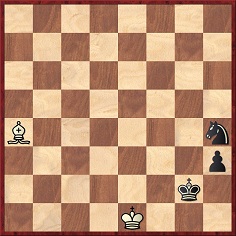
White to play and draw
1 Bd7 h2 2 Bc6+ Kg1 3 Bh1 Kxh1 4 Kf2.
(3400)
Michael Negele (Wuppertal, Germany) raises the subject of the following photograph in The Steinitz Papers by Kurt Landsberger (Jefferson, 2002):
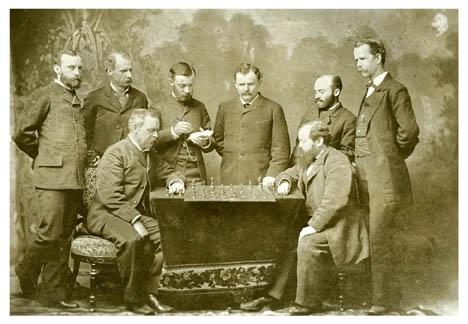
The caption in the book reads ‘Zukertort (third from left) taking notes as Steinitz (seated at right) plays an unidentified opponent, in a seemingly staged photograph, date unknown’. The picture comes from Mr Landsberger’s private collection and is reproduced here with his permission. We invite readers’ suggestions as to who is who.
For a larger version of the illustration, click here.
(3463)
Michael Negele has found an almost complete key in the Cleveland Public Library:
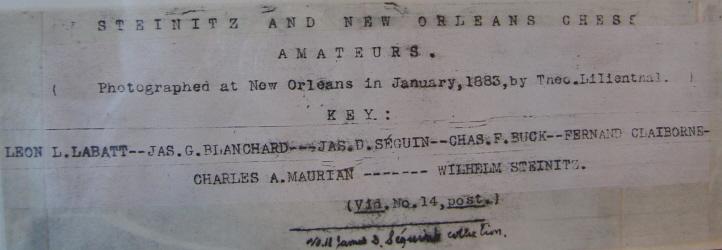
(5173)
Olimpiu G. Urcan (Singapore) points out that this photograph appeared on page 2 of the third part of the Daily Times-Picayune (New Orleans) of 9 March 1913 (see the pdf version). The earlier (Cleveland) key did not identify the man standing on the right, but now a name is provided: M.F. Dunn.
(7611)
The photographer was identified in C.N. 5173 as Theodore Lilienthal of New Orleans. From the same period (January 1883) the Cleveland Public Library has a portrait of Steinitz, reproduced below with permission, which also mentions Lilienthal:
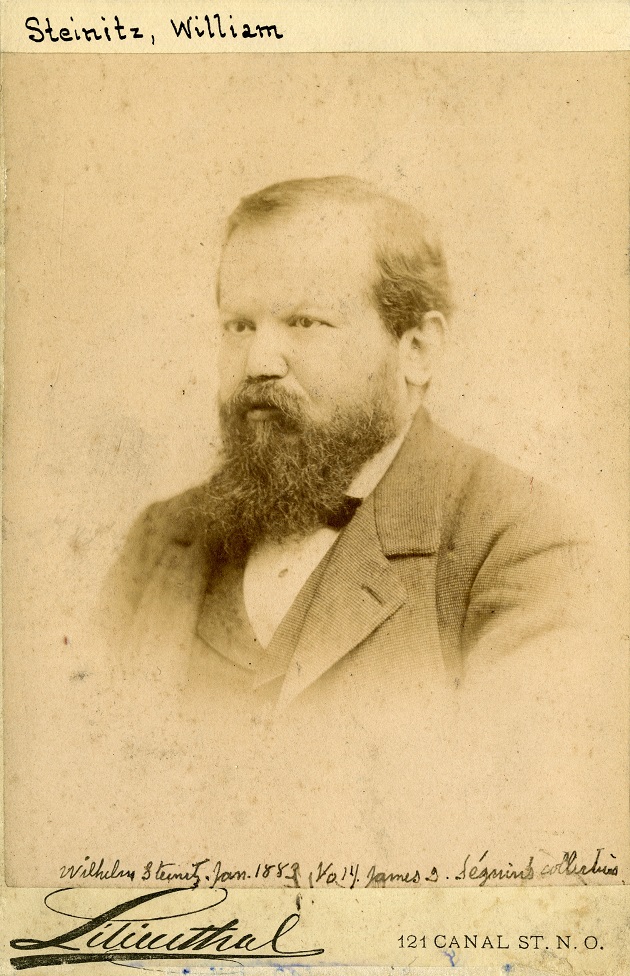
(11743)
On page 174 of CHESS, 8 January 1955 Steinitz was said to have declared:
‘Let me establish an unassailable knight on K6 and I can go to sleep for the rest of the game.’
(3514)
From Mark N. Taylor, who is Assistant Professor of English at Berry College, Mt Berry, GA, USA:
‘“Chess and Chessic Motifs in English Prose Narrative Since 1700: An Annotated Bibliography” aims to be a comprehensive listing of narratives which include chess in substantial or significant ways. Each entry will be annotated, summarizing the chess content. The project currently lists over 1,000 titles. The finished list will probably number between 1,500 and 2,000 titles. I welcome any assistance, particularly in identifying the less obvious books and short narratives, especially for the period 1945 to about 1985, including short stories published in chess periodicals. Anyone wishing to contribute relevant information should contact Mark N. Taylor at mtaylor@berry.edu, or at the Department of English, Box 350, Berry College, Mt Berry, GA 30149-0350, USA.’
Our correspondent has provided the following sample entry from his project:
‘Brunner, John. The Squares of the City. New York: Ballantine, 1965. 319 pp. Pbk. Intro. by Edward Lasker. (GENRE: Fantasy thriller novel by a noted science-fiction author. SUMMARY OF CHESS CONTENT: The story is not about chess but about two South American political antagonists and their followers. The main plot, however, is precisely structured according to the moves of the 16th Steinitz-Chigorin world championship match game, Havana, 1892, explained in the author’s end note. Brunner returns to this theme in his 1980 novel, Players at the Game of People, but without explicit chess references. MOTIF: life is like a chess game.)’
(3616)
On page 130 of the May 1951 Chess Review a reader, E. Gram-Larsen of Solar, Norway, wrote regarding a Lasker v Steinitz ending:
‘In the 14th game of the second world championship match, the following position occurred after Black’s 52nd move:
There followed 53 Rc2?? Rxc2+ 54 Kxc2 and Black resigned after White’s 78th move. But if Black had played 53...Ra1+ White might have resigned as his rook on d1 is lost. It could have been Emanuel Lasker’s greatest blunder.
I have the game from Ludwig Bachmann’s book Schachmeister Steinitz, Vol. 4, Ed. 1921. It was played on 29 December 1896. I thought there might be errors in the score – there are many in other places in the book – but, so far as I can see, the moves leading to the above position are in order.’
We believe, however, that Bachmann erred by putting as White’s 50th move Rd6-d1, rather than Rd6-d8, and that there was thus no blunder by Lasker at move 53.
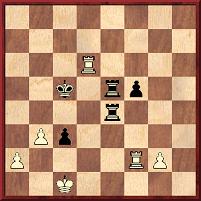
Position after 49...Kd4-c5
Although 50 Rd1 was also given in the Weltgeschichte des Schachs volume on Steinitz by David Hooper (Hamburg, 1968) and the two editions of Chess World Championships by James H. Gelo (Jefferson, 1988 and 1999), all contemporary magazines verified by us so far have 50 Rd8. Examples are Deutsches Wochenschach, 10 January 1897, pages 6-7 and Deutsche Schachzeitung, February 1897, pages 38-40.
(3847)
From page 166 of Why You Lose at Chess by Fred Reinfeld (New York, 1956):
‘Wilhelm Steinitz was one of the three greatest chess masters of all time. (I rank him with Lasker and Alekhine.)’
(5907)
‘The strongest of all the chess-playing reverends in Britain in the nineteenth century’ was Harry Golombek’s description of George Alcock MacDonnell on page 188 of The Encyclopedia of Chess (London, 1977). However, on page 231 he called John Owen ‘probably the strongest of all the chess-playing reverends of the nineteenth century’, a contradiction pointed out by W.H. Cozens on page 400 of the September 1978 BCM which Golombek resolved in the 1981 Penguin edition of his Encyclopedia by demoting Owen to ‘one of the strongest of all the chess-playing reverends of the nineteenth century’. Steinitz, for his part, called MacDonnell ‘the shady irreverend fou’ on page 147 of the May 1891 International Chess Magazine.
Golombek’s Encyclopedia, which gave more space to G.A. MacDonnell than to A. McDonnell and G.H. Mackenzie combined, also observed regarding MacDonnell:
‘He was a lively, entertaining but far from accurate writer on chess, and many of the unauthenticated and even groundless anecdotes about the great players of the nineteenth century stem from his inventive pen. He was “Mars” in the Illustrated Sporting and Dramatic News and wrote two entertaining books: Chess Life-Pictures, London, 1883, and The Knights and Kings of Chess, London, 1894.’
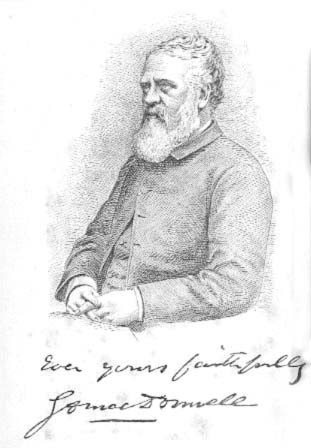
George Alcock MacDonnell
On pages 146-147 of the May 1891 International Chess Magazine Steinitz labelled MacDonnell ‘one of my bitterest and most untruthful persecutors while I was defenseless and powerless to answer’ and stated that MacDonnell ‘has an unconquerable inclination to associate himself with any kind of deception or imposition practiced in the English chess press’.
A notable assertion by MacDonnell was that a negative book review by Steinitz led to the closure of the City of London Chess Magazine. On pages 39-40 of The Knights and Kings of Chess MacDonnell wrote of Steinitz:
‘Years ago he said to me, “Nothing would induce me to take charge of a chess column”; and when I asked why he replied, “Because I should be so fair in dispensing blame as well as praise that I should be sure to give offence and make enemies.” However, when offered a column in the Field, he accepted it, and conducted it for some time with fairness and decorum. His first false move was his attack on Wormald’s book on the openings. When he showed me the proof of his review, I at once condemned its tone, and advised him to omit personalities. But he declined to do so and, the Field rejecting the article, he was fain to publish it in the City of London [Chess] Magazine, where its appearance caused much confusion, and led ultimately to the extinction of that journal. Of the article, suffice it here to say that it filled eight octavo pages, took Steinitz eight months to write, and took his friends eight years to forget.’
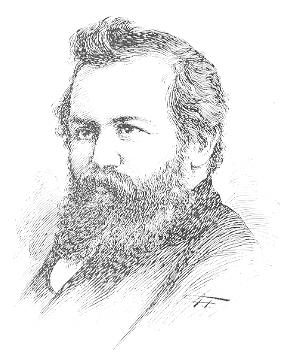
Wilhelm Steinitz
When The Chess Openings by Robert B. Wormald, a 317-page volume, appeared in early 1875 it was warmly welcomed by the reviewers. On pages 44-45 of the March 1875 issue of the City of London Chess Magazine John Wisker wrote that ‘the high praise which has been bestowed upon this work in different quarters seems, on careful examination, to be well deserved’ and he added regarding Wormald:
‘He has executed his task with remarkable accuracy, and has yet limited his pages to the time and memory of every amateur. It is certainly the best book on the openings that exists in English; nor does it appear at all likely that a more convenient or trustworthy guide will be produced just now.’
On page 253 of the Chess Player’s Chronicle, April 1875 William Wayte wrote similarly:
‘We shall not follow our contemporaries in discussing Mr Wormald’s treatment of the openings in detail, but we gladly endorse their opinion that we have here the best book on the chess openings in the English language.’
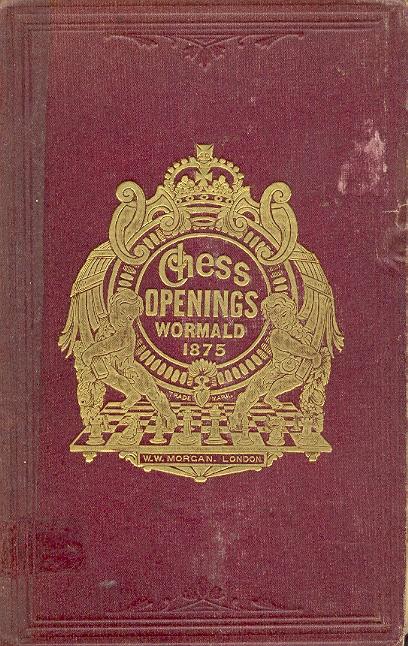
Steinitz’s review of The Chess Openings did not appear in the City of London Chess Magazine until the end of the year, in two parts (November 1875, pages 297-304 and December 1875, pages 331-336). It was thus considerably longer than the eight pages referred to by MacDonnell. Steinitz’s first two and a half pages were an introduction which firstly set out the responsibilities incumbent on chess writers:
‘A chess author is under the obligation of producing in his examinations of each form of play a complete chain of combinations, every link of which is required to be perfect; for if there be the slightest flaw in any of the propositions whereby he supports his conclusions, the whole structure of his analysis tumbles down, like a house made of cards, at the slightest touch. The combined gifts of accuracy, sound originality, correct judgment, and faithful patience – in a word, the chess genius necessary to the fulfilment of such an object – are no common properties, and cannot be accredited to every one who professes to have discovered his own great qualifications for such a purpose by a process similar to the one which enabled the German philosopher to evolve a camel from the depths of his inner consciousness.’
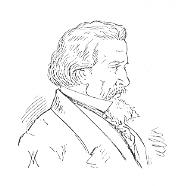
Robert Bownas Wormald
Steinitz then brought in Wormald’s name:
‘Mr Wormald is certainly a problem composer of high merits (of which we shall speak more anon), though we believe he has never succeeded in gaining a prize in any problem competition, and might, therefore, be regarded as scarcely tip-top even in that respect. But, assuming that he ranked highest in the region of chess fiction, it would not give him any title of prominency in the realities of the game, where a multitude of the deepest problems are presented for immediate solution at every stage. No reciprocity has ever been alleged to exist between the qualities requisite for the composition of fine problems and the capacities that command success in the struggles over the board.’
Steinitz commented that ‘we must confess our total ignorance of any achievement on the part of Mr Wormald which would place him on a level even with second-rate players’ and added:
‘Nor have we ever heard of a single good game played by Mr Wormald, against a strong opponent, wherein he might have shown any such marked ability as usually distinguishes the skirmishes of strong masters which appear in the periodical chess publications of the day. So far Mr Wormald has given little indication of his having learned anything before he attempted to teach, and his chess pugnacity seems to have been reserved for the semi-controversial book under our notice, which abounds with attempted exposures of alleged errors that occur in other chess works.’
The next accusation by Steinitz was that Wormald had been too critical of most of the established authorities, with one exception:
‘... we felt, even before investigating the truth of his charges, that some of his long-winded and elaborate demonstrations of the peccadilloes alleged against other writers were doing violence to our toleration. ... Heydebrandt [sic], Jaenisch, Max Lange, Neumann, Suhle – nay, even the combined efforts of Morphy and de Rivière, do not pass the author’s scrutiny unscathed; but we could not find a single instance where he expressly ventured to differ from any recommendations made by the late Mr Staunton in his numerous chess works.’
Nor did Steinitz consider that Wormald had exercised sufficient care ...
‘... on the correction of his proofs, and the expunging of clerical blunders and bewildering misprints, which occur in his book in a larger proportion than in any other existing chess work worthy of the name. This sort of carelessness is in itself quite unpardonable when often recurring; but when we find it also combined with a complete failure of establishing the immense majority of the derogations attempted against contemporaries and previous chess teachers, we are led strongly to suspect that Mr Wormald’s conscience cannot be of a very exact description. ... We have no hesitation in terming Mr Wormald’s Chess Openings a slovenly work, to the contents of which Lessing’s celebrated verdict might be applied, “What is new is not true, and what is true is not new”.’
Steinitz then undertook a detailed spot-check of the book’s analysis. Examples are given below, and we have added in square brackets the relevant opening moves, as well as two diagrams.
‘In the Petroff’s Defence the author gives, in page 14, [1 e4 e5 2 Nf3 Nf6] 3 d4 exd4 best, which the German Handbook justly considers much inferior to 3...Nxe4, on account of the continuation 4 e5 Ne4 5 Qe2 Bb4+ 6 Kd1, etc. On the same page, fifth line from the bottom, a piece of carelessness occurs which would be most vexatious and perplexing to the beginner, who would rack his brains to find any reason for the suggestion in the book, without thinking it possible that the author only committed a simple blunder by recommending [after 1 e4 e5 2 Nf3 Nf6 3 d4 exd4 4 e5 Ne4 5 Bd3] as “better still” 5...Qe7, whereby a piece is left en prise without rhyme or reason.’
‘On page 19, fourth line from the top, we are puzzled to find the author’s meaning when he urges [after 1 e4 e5 2 Nf3 Nc6 3 Bc4 Bc5 4 c3 Nf6 4 d4 exd4 6 e5 d5 7 Bb3] 7...Bb4+ as Black’s best rejoinder. The check is simply impossible, but as a set-off two pieces are left en prise by the move.’
‘Towards the middle of page 25 an addendum is made to a variation which Theorie und Praxis left off without further comment. Had Messrs Neumann and Suhle known how they would be supplemented, perhaps they would have taken a little further trouble; but of course it could not occur to them that any later writer could be so totally devoid of chess instinct as to recommend [after 1 e4 e5 2 Nf3 Nc6 3 Bc4 Bc5 4 O-O Nf6 5 d4 exd4 6 e5 d5 7 exf6 dxc4 8 Re1+ Kf8 9 fxg7+ Kxg7 10 Ne5 Re8 11 Bh6+ Kg8 12 Nxc6 bxc6 13 Rxe8+ Qxe8 14 Nd2 Qe6 15 Qh5 Qf5 16 Qh4 Be6 17 Ne4] 17...Bb6
and then dismiss the position with the short remark, “and White still has some attack, but Black has a pawn more, [and] a strong position”. It requires little experience to see that Black’s best course consists in securing the draw by 17...Be7, with some chance of winning; for in the position where the author leaves his variation White might still continue 18 Nf6+ Kh8 19 g4 Qg6 best 20 Bf4, threatening 21 Be5 with a strong attack.’
‘... It struck us that in common fairness we ought to take a glance into the author’s treatment of the QBP opening, which has been much commended elsewhere. We have to look no further than to Black’s sixth move, in the first main variation in order to discover a state of hopeless confusion in the author’s remarks, at the top of page 42. He there thinks fit to condemn a move which would strike us as the best at first sight – viz. [after 1 e4 e5 2 Nf3 Nc6 3 c3 f5 4 d4 d6 5 dxe5 fxe4 6 Ng5] 6...Nxe5. In support of his view he gives a sub-variation wherein the queen checks backwards and forwards [6...Nxe5 7 Nxe4 d5 “best” (Wormald) 8 Qh5+ Ng6 9 Ng5 Nf6 10 Qe2+ Be7 11 Ne6 Bxe6 12 Qxe6 Qd7], which only seems to help the defence to develop and consolidate all his forces in a manner totally opposed to the spirit of an open game.
On the 11th move he overlooks the decisively superior 11...Qd6, whereupon White dare not take the g-pawn ch, on account of the reply 12...Kf7, followed by 13...Bg4; and he innocently concludes his sub-variation with the observation “and Black has the better game”, though he evidently meant to prove at starting that the indicated line of play should turn out to the disadvantage of the defence. Proceeding, however, with the main variation, containing the alleged better line of defence, we would (at the fifth line from the top) much prefer [after 1 e4 e5 2 Nf3 Nc6 3 c3 f5 4 d4 d6 5 dxe5 fxe4 6 Ng5 d5] 7 Bb5, threatening 8 Qa4, either before or after capturing the knight, according to circumstances, while the author’s 7 e6 is no doubt premature.’
‘... We have reached page 72, where we expected to find a maiden sheet, as the two pages before us only profess to enumerate some of the unimportant variations of the Evans Gambit before the ninth move, which is, after all, the bone of contention between different authorities and players. But we are sadly disappointed. By a singular process of reasoning, the author lets Black play the defence (eighth line from the top) 7...Bb4+ [after 1 e4 e5 2 Nf3 Nc6 3 Bc4 Bc5 4 b4 Bxb4 5 c3 Be7 6 d4 exd4 7 cxd4] instead of the obviously better 7...Nf6 and, having brought about the same position by a transposition of moves as in the defence 5...Bc5 6 d4 exd4 7 cxd4 Bb4+, he afterwards concludes the variation much in White’s favour. Yet a few lines further he refers us for the treatment of the latter defence to Game VII, which we discover at last at page 101. Of course the positions are identical but, to our utter bewilderment, the author this time carries out the variation in favour of Black, and the reader can take his choice between the two versions.’
With respect to the difference between his assessment of The Chess Openings and that other critics, Steinitz wrote:
‘As will have been perceived by chess students, we have as much as possible confined ourselves to errors to which attention had not been directed by other critics, whose competency is above dispute but who nevertheless seem to us to have delivered their judgment in praise of the book with undue haste. ... For our part, we found it impossible to endeavour to do justice at the same time to the public, to the new advents and to old authorities without bestowing the most minute attention before committing ourselves to a final opinion.
In fairness to the other critics who have pronounced views opposite to our own in reference to Mr Wormald’s book, we frankly confess that at first we were much prepossessed in its favour, having been taken in by the remarkable garrulity of the author, which we trusted would be at least supported by common care and ordinary judgment, until on closer research we found the most hollow propositions spread out over pages.’
In the final paragraph of his review Steinitz turned ‘with real pleasure to the last 50 pages of the book, which contain a collection of one hundred of the author’s problems’, which Steinitz praised highly, though not unreservedly.
On pages 292-293 of the November 1875 City of London Chess Magazine the editor, W.N. Potter, wrote regarding Steinitz’s review, ‘we shall be very happy to give Mr Wormald an opportunity of defending his work in our pages’, but no such defence appeared.
As noted above, the review was published in the November and December 1875 issues, and the latter (page 352) announced that the January 1876 number would be the magazine’s last:
‘The reason of its fairly prosperous career being brought to a close is that it has become impossible for us any longer to spare the time which hitherto we have willingly devoted to the service of Caissa.’
The magazine’s death was a lingering one, as page 379 of the January 1876 issue held out the prospect of continuation under a new editor, and one last number did appear. On page 642 of the December 1980 BCM G.H. Diggle affirmed that MacDonnell’s remark about Steinitz’s book review being to blame for the demise of the magazine was ‘not true’. P.W. Sergeant discussed the matter on pages 129-130 of A Century of British Chess (London, 1934), but without giving sources for various key statements.
MacDonnell wrote glowingly about Wormald on pages 45-48 of Chess Life-Pictures (from which our sketch of him above was taken). A further illustration (below), by Sam Loyd, was published on page 1614 of the Scientific American Supplement, 8 December 1877, and Loyd wrote in that column that he had drawn it after meeting Wormald at the Paris Exhibition in 1867.
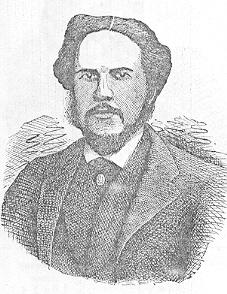
Robert Bownas Wormald
Wormald died in his early forties on 4 December 1876, a year after Steinitz published his review of The Chess Openings. Because it was a densely-packed article which gave only the page references from the book, without the moves leading up to the positions discussed and also without diagrams, it may be wondered whether many readers at the time, or later, looked at the critique closely. If instances can be identified of Steinitz being wrong in his denunciation of Wormald, we should like to be informed.(3974)
Stefan Bücker (Nordwalde, Germany) writes:
‘Steinitz was very critical of Wormald’s The Chess Openings (1875). Presenting the following example, he even classified Wormald as a [writer] “so totally devoid of chess instinct as to recommend” [after 1 e4 e5 2 Nf3 Nc6 3 Bc4 Bc5 4 O-O Nf6 5 d4 exd4 6 e5 d5 7 exf6 dxc4 8 Re1+ Kf8 9 fxg7+ Kxg7 10 Ne5 Re8 11 Bh6+ Kg8 12 Nxc6 bxc6 13 Rxe8+ Qxe8 14 Nd2 Qe6 15 Qh5 Qf5
16 Qh4 Be6 17 Ne4] 17…Bb6. Here the usual move was 17…Be7. Steinitz tried to prove that Wormald’s suggestion 17…Bb6 was a mistake: “White might still continue 18 Nf6+ Kh8 19 g4 Qg6 best 20 Bf4, threatening 21 Be5 with a strong attack.” This is optimistic, since Black has 20…Kg7 21 Be5 h6, followed by 22...Kf8, which seems to be equal. If White tries 19 Bf4 (instead of Steinitz’s 19 g4), Black still has 19…c3 20 Be5 cxb2 21 Re1 Kg7.
Perhaps there are better ways to attack 17…Bb6, but I see nothing sufficiently convincing to justify Steinitz’s strong words quoted above.
Even if Steinitz were right concerning 17...Bb6, that would not mean that his own chess instinct was any better than Wormald’s. In the diagram above both Wormald and Steinitz overlooked a clear refutation: 16 Re1 (threatening 17 Re8+ with mate to follow.) 16…Be6 (what else?) 17 Qxf5 Bxf5 18 Re5, attacking both bishops.
Robert B. Wormald was not in the same class as Steinitz as a player, but his book did not deserve such harsh treatment. Besides, the whole variation today has lost much of its earlier importance. Comparing the sequence with a detailed article by Lev Gutman on the Max Lange Attack in issue 22 of Kaissiber (2005), we find that:
(a) The main line 8 Re1+ is weaker than 8 fxg7, according to Gutman. The latter move gives White an advantage, but Gutman’s analysis fills 15 pages.
(b) The reply 8…Kf8 is correct (8…Be6 would allow 9 fxg7, transposing into Gutman’s main line).
(c) 9 fxg7+ (Max Lange, 1854) is weaker than two “modern” options, 9 Bg5 (Steinitz, 1889) and 9 Ng5 (Abels and Zemsch, 1911).
(d) 10…Re8 is less precise than 10…Qf6, according to Gutman.
(e) Instead of 13 Rxe8+, 13 Nd2 would be playable.
(f) Rather than 14…Qe6 Black should play 14…Bf5 15 Qh5 Qe6 (analysis by Zemsch, 1902).
So from a modern perspective Steinitz and Wormald were discussing an irrelevant line. But are modern opening books so much better? The main line usually consists of three mistakes in a row: 8 Re1+ Be6 9 Ng5. According to the article in Kaissiber, Steinitz and Wormald at least had the second move right: 8...Kf8.’
(4460)
C.N.s 3974 and 4460 discussed at length Steinitz’s assault on The Chess Openings by Robert B. Wormald (London, 1875) in the City of London Chess Magazine, November 1875, pages 297-304, and December 1875, pages 331-336. That periodical was edited by W.N. Potter, and it is worth adding that on pages 240-245 of the July 1883 BCM he reviewed Chess Life-Pictures by G.A. MacDonnell (London, 1883) and commented:
‘What is said about Wormald is brief, but attractive. I have always regretted allowing Mr Steinitz’s attack upon Mr Wormald to appear in the City of London Chess Magazine. I had habitually accorded to my co-operators an independent expression of their views; but there is little doubt that in this particular instance I ought to have refused to insert the review in question.’
(4843)
Marek Lada (Warsaw) notes that our feature article on chess figures’ addresses has no entry for Anderssen, who is recorded as having lived in Breslau (Wrocław) throughout his life. What details can be found?
On the subject of Anderssen, page 385 of Kings, Commoners and Knaves quoted a remark by Bird in an article on pages 148-155 of the April 1887 BCM that he was the ‘king of all chess players’. Here we add that on page 403 of the December 1916 BCM H.J.R. Murray quoted Steinitz as stating:
‘Anderssen was the greatest master of all times; nor had he his peer as regards brilliancy of style, beauty of conception, and depth of design.’
Where did Steinitz make that remark?
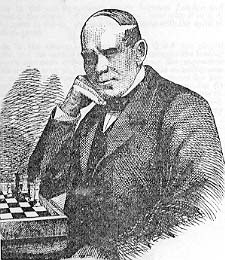
Adolf Anderssen (by Sam Loyd)
On page 207 of the July 1888 International Chess Magazine Steinitz wrote:
‘... I have frequently expressed my doubts whether I was really stronger than Anderssen (the only other player [i.e. apart from Mongrédien] with whom both Morphy and I crossed swords in a match) when I defeated him, it is true, by the small majority of two games only, and I have often thought and still think that probably the German professor who stood no chance against Morphy could at the time have beaten me in a longer match.’
Steinitz won that 1866 contest against Anderssen with a score of +8 –6 =0.
(3983)
It is widely accepted that the description of Paul Morphy as ‘The Pride and Sorrow of Chess’ was coined by Sheriff Walter Cook Spens (1842-1900), but chess literature is full of matters which, while widely accepted, are untrue. A number of C.N. items have tried to established the facts about the sobriquet, without success so far.
On page 113 of the April 1885 International Chess Magazine Steinitz wrote:
‘... the fearful misfortune which ultimately befell “the pride and sorrow of chess”, as Sheriff Spens justly calls Morphy, can only evoke the warmest sympathy in every human breast.’
(4053)
As shown in The Pride and Sorrow of Chess, the origins of the phrase have yet to be established.
On page 3 of the January 1885 issue of his magazine Steinitz had mentioned the phrase with a second definite article but no reference to Spens:
‘The pride and the sorrow of chess, as Morphy has been called, is gone for ever.’
(6469)
C.N. 12001 appealed again for further citations.
Pages 185-186 of the February 1908 issue of Lasker’s Chess Magazine quoted R.J. Buckley in the Manchester City News:
‘Where is the chessplayer who has not had his fit of chess blindness? Did not William Steinitz print a new defence to the King’s Gambit, backed by two columns of analysis, when in the early stages the defence was smashable by a mate in two? Did not Dr Tarrasch announce a deep, deep mate in five, when the mate could have been made on the move? ... Did not the 16 judges of an international problem tourney throw out the great three-er of Kohtz and Kockelkorn on an alleged cook, when in reality there was no cook at all? Did not the Hastings International Committee award first prize to Professor Benyon’s three-er, which was promptly cooked by a small boy? And did not the [Gazzetta Letteraria] award first prize to a two-er which had no solution at all?’
Particulars will be welcomed on all the above questions.
(4162)
C.N. 4162 quoted R.J. Buckley as writing, ‘Did not William Steinitz print a new defence to the King’s Gambit, backed by two columns of analysis, when in the early stages the defence was smashable by a mate in two?’
Michael Alderson (Derby, England) now draws attention to the following broadly similar story (albeit about a different opening) by Irving Chernev on page 322 of the July 1976 CHESS:
‘Back in the days when William Steinitz was Champion of the World, he published a lengthy analysis of a defence which he considered to be a refutation of the Evans Gambit. It took up pages of print in his publication The International Chess Magazine, and impressed layman and expert alike. Steinitz was interviewed by the press and referred to by them as the destroyer of the gambit.
The line he advocated ran as follows: 1 e4 e5 2 Nf3 Nc6 3 Bc4 Bc5 4 b4 Bxb4 5 c3 Ba5 6 d4 exd4 7 O-O Nf6 8 Ba3 Nxe4 9 Qb3 Ng5.
This position is reached:
Steinitz’s adopted daughter glanced at the position, and smashed the whole line by asking why White should not play 10 Bxf7+ Nxf7 11 Re1+, winning the queen.
This two-move win almost broke Steinitz’s heart, as he was subjected afterwards to a great deal of disparaging comment.’
But how much truth is there in all that? We quote from pages 297-298 of the July 1895 BCM an item reproduced from the New Orleans Times-Democrat:
‘A Discovery in Chess. About as amusing an event as has marked chess history for some time past has recently occurred in New York, and our esteemed contemporary, the New York Sun, was, in one sense at least, the victim involved. In its issue of the second instant (2 June) appeared an article nearly a column in length, introduced with the startling headlines, “Great Discovery in Chess”, “Steinitz finds the Death Blow for the Evans Gambit”, “Like Many Great Discoveries, It Comes by Accident from an Unexpected Source”, etc., etc., with the portentous announcement, “Copyright by W. Steinitz”. Nor was a perusal of the article calculated to diminish the excitement. The main portion thereof, introduced with a delightfully playful exuberance by the chess editor of the Sun, was as follows:
Now comes Champion Steinitz again with the statement that at last he has found the key, and that he has discovered the move that will make all Evans Gambit players bite the dust. He regards it as the most sensational discovery in chess since that of Capt. Evans himself, and greater than that inasmuch as it proves to be the latter’s master.
The discovery was accidental by Mr Steinitz’s adopted daughter. How it was made is here told by the champion.
“My niece and adopted daughter, Miss Hedwig Steinitz”, said Mr Steinitz, “was trying to play over from memory the well-known Suhle attack in the Evans Gambit and arrived correctly, after the moves 1 e4 e5 2 Nf3 Nc6 3 Bc4 Bc5 4 b4 Bxb4 5 c3 Ba5 6 d4 exd4 7 O-O Nf6 8 Ba3 Nxe4 9 Qb3, at the position marked on the diagram below.
‘Papa’, she said, ‘is this the move now?’ and she pointed to ...Ng5 for Black.
No doubt my daughter saw no more than that she defended the twice-attacked f-pawn, and she even overlooked that the protection only lasted for one move, as White could capture the knight. But what an analytical revelation opened itself before my eyes. And, of course, any modern expert will see at a glance that this is the right move, which has been overlooked by all analysts and practioners [sic] for about 35 years.
‘The previous question’ will have to be moved in regard to the soundness of the Evans Gambit, and we have to fall back to find another answer to 7...Nf6.”
But singular to relate, “analysts all over the world” did not “move the previous question” in regard to the soundness of the Evans, nor did they “start for the discovery of new lines of play” in the gambit. They simply took hold of the particularly extraordinary variation propounded by Steinitz and they suggested that he had actually overlooked a deep two-move combination continuing 9...Ng5 10 Bxf7+ Nxf7 11 Re1+ and wins in a canter. And the ex-champion himself writes a letter to the Sun of 5 June acknowledging his “great discovery” to be no discovery at all; that his analysis was unsound. And the Sun (in its sub-editorial columns) sagely remarks: “So the Evans Gambit holds its ground. This delusion of Steinitz shows how genius can often be inferior to the dispassionate calmness of understanding comparatively common-place.’
We should firstly like to be reassured that the above account from the New Orleans Times-Democrat (whose chess editor was a foe of Steinitz, James Séguin) accurately reflects what appeared in the New York Sun. At any rate, it is certainly a far cry from Chernev’s account.
(4171)
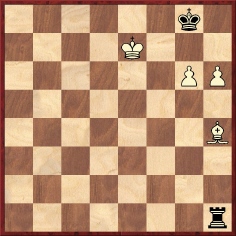
This well-known position (White to move) is often presented as a composition by Steinitz and misdated. For example, on page 130 of American Chess Art (New York and London, 1975) Walter Korn gave the source as ‘The Pawn March 1910’ and ‘First published in Nuova Rivista degli Scacchi 1880’.
We note, however, that the position appeared on page 247 of the July-August 1862 Deutsche Schachzeitung, as an over-the-board victory against an unnamed opponent (‘Aus einer Partie von Steinitz’).
The magazine reverted to the ending on page 53 of its February 1863 issue, stating that White can force mate in, at most, ten moves (1 h7+ Kg7 2 h8(Q)+ Kxh8 3 Kf7 Rf1+ 4 Bf6+ Rxf6+ 5 Kxf6 Kg8 6 g7 Kh7 7 Kf7 Kh6 8 g8(Q) Kh5 9 Qg3 Kh6 10 Qh4) but not indicating how much of this happened over the board.
(4338)
Pages 59-60 of Curious Chess Facts by Irving Chernev (New York, 1937) featured a familiar tale in the ‘once’ category:
‘Steinitz and Zukertort were once present at a dinner where a toast was given to the “Chess Champion of the world”. Both players stood up.’
The same story was presented on page 76 of his book Wonders and Curiosities of Chess (New York, 1974) and on page 104 of The Fireside Book of Chess (New York, 1949), which he co-authored with Fred Reinfeld.
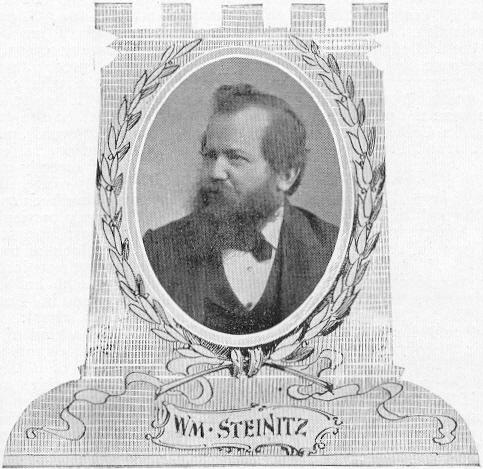
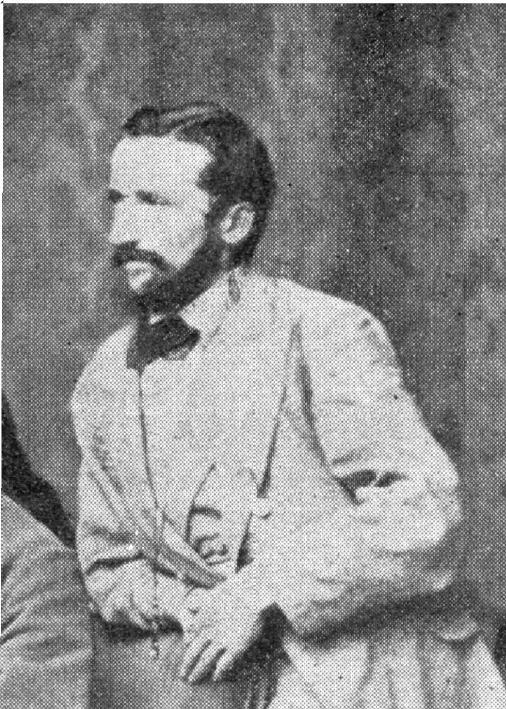
Wilhelm/William Steinitz and Johannes Hermann Zukertort
In The Great Chess Tournaments and Their Stories (Radnor, 1975) A. Soltis wrote an entire chapter on London, 1883 under the title ‘Will the Real World Champion Please Stand Up?’ (pages 21-49). The opening paragraph reads:
‘As a matter of fact there was a banquet at which a toast to the World Champion was raised, and both Wilhelm Steinitz and Johannes Zukertort stood up. But that was after London 1883, and that’s getting ahead of the story.’
Nothing else of relevance was provided, and, as so often, William Steinitz, Chess Champion by Kurt Landsberger (Jefferson, 1993) is also of little help. Page 137 states regarding London, 1883:
‘The evening when the prizes were distributed, the main speaker raised his glass to toast the best chessplayer of the world. Steinitz blushed modestly, but on the other end of the table Zukertort had already stood up, bowed dramatically in front of the whole assembly and with a self-confident smile indicated that the toast was meant for him. Steinitz lost his color and the guests murmured in embarrassment. (Supposedly a similar incident happened a few years later in New York, again with these two players.) To save the situation one of the guests present suggested that Steinitz and Zukertort must sing a duet together. But both refused. “You can see how I am being treated”, Steinitz whispered to someone sitting near him. “No recognition, no recognition.” In the meantime Zukertort twittered loudly, “Yes, gentlemen, even as a small boy I was already a mathematical gen--.” He wanted to say “genius” but by that time the audience had dispersed.’
For the above account Landsberger merely supplied as his source an even gossipier book, Heiteres aus der Welt des Schachs by V. Houška and K. Opočenský (Prague, 1961). See page 73. It might at least have been pointed out that a nineteenth-century work, though not one of the most reliable, covered similar ground. Below is an extract from pages 21-22 of The Knights and Kings of Chess by G.A. MacDonnell (London, 1894):
‘Prior to his [1886] match with Steinitz the following amusing incident occurred at a dinner given by the Manhattan Club at Philadelphia [sic] to Messrs. Steinitz and Zukertort. After several toasts, Mr Eugene Delmar rose and cried out, “Here’s to the champion chessplayer of the world. Let him respond.” Immediately the company waxed hilarious. Zukertort got red in the face, and Steinitz husky in the throat; but “the boldest held his breath”; hereupon someone rose and said, “Gentlemen, I think I see a way out of this difficulty, let Messrs. Steinitz and Zukertort sing a duet in response.” The champions would not sing; but some horrid creature now calls it the due-yet song. As the company were leaving the room, Steinitz was whispering lugubriously to a neighbour, “You see how I am treated and receive no recogni--;” whilst Zukertort was gaily twittering forth: “Yes, sir, even when I was a boy I was a great mathematical geni--” “us” he would have said; but ere the word was out the guests were fled.’
All this is a far cry from the London, 1883 story which has entered chess lore, and an even farther cry from what George Koltanowski proclaimed on page 22 of his 1968 book TV Chess:
‘All chess players are egotists. At a banquet the speaker introduced the champion of the world, and three grandmasters stood up at the same time.’
(4360)
From John Hilbert (Amherst, NY, USA):
‘C.N. 4360 refers to several versions of the old “once upon a time” story of a toast being offered at a chess banquet “to the world chess champion”, after which both Steinitz and Zukertort stood up. The C.N. item mentions versions of the tale by Chernev, Reinfeld, Soltis, Houška and Opočenský (the last two by way of Landsberger) and MacDonnell. The MacDonnell version offers the most detail and appeared on pages 21-22 of The Knights and Kings of Chess (London, 1894).
The less than fully reliable MacDonnell often, if not invariably, filled his books with material originally in his chess column in the Illustrated Sporting and Dramatic News. The chess toast story is no exception, and can be found in that publication on 10 April 1884. Of interest here is how MacDonnell prefaced the story in his chess column (material that was left out of his book):
“The Chess Monthly, just issued, is very amusing and interesting. From it I cull the following story, but take the liberty of telling it in my own words.”
MacDonnell’s “own words” included some poor reading. He changed the dinner’s location from New York to Philadelphia, despite having the Manhattan Chess Club host it, and in retelling the story left out particulars that might have made finding its origin much easier, including the reference to the Chess Monthly.
The tale had appeared on page 232 of the April 1884 Chess Monthly. Under the sub-heading “New York”, mention was made of the annual Manhattan Chess Club dinner on 1 March 1884, with over 60 members and guests present. These included Steinitz, Zukertort, Mackenzie, Lipschütz and, importantly for the story’s purpose, Eugene Delmar and David S. Thompson, the latter of Philadelphia. The Manhattan Chess Club’s annual dinner not only offered members and guests an entertaining evening but also provided an opportunity for tournament prizes to be distributed, and for special presentations to be made. In this instance, prizes for the recent handicap tournament, won by George Mackenzie, were given, and the Club’s directors “presented to the Club a life-like portrait of Paul Morphy, by a distinguished American artist – Mr Elliott. The Chairman accepted the valuable gift on behalf of the Club …”
Leopold Hoffer, the joint editor of the Chess Monthly with Zukertort, then printed the toast story, but introduced it with the following words: “Mr D.S. Thompson, in a letter addressed to us, inclosed the following cutting from the Philadelphia Times, with the request of its being published in the Chess Monthly.” Published it was, beginning under the sub-heading “Delmar’s Joke”, continuing through “What Thompson Proposed” and concluding under “They Wouldn’t Sing a Duet”. Hoffer made no comment regarding the cutting from the Philadelphia Times and did not vouch for its truthfulness. The report in the Chess Monthly then shifted to chess news from St Louis.
The chess toast story originally appeared in the Philadelphia Times on 16 March 1884 as follows:
“Delmar’s Joke.
A little incident happened at the recent Manhattan Chess Club dinner which is too good to be lost. It was noticed that Mr Eugene Delmar, who was present at that feast, was constantly endeavoring to get off a toast that he had on his mind, but that his friends – who evidently knew the subject-matter of what he was about to say – were as constantly endeavoring to keep him quiet. About every five minutes, Mr Delmar would rise with, ‘Gentleman, I’m about to off-’ ‘Come, come, Delmar’, his friends would whisper, ‘let up’, and they would pull him down to his seat and smother the thing over. This happened several times and each time the company paused in wonder – Steinitz would cease for a minute in relating his ‘wrongs’ to a neighbor and even Zukertort would forget what a genius he was, in the excitement of the moment.
Finally, however, Delmar could no longer be restrained and he shouted, ‘Here’s to the champion chess player of the world! Let him respond.’ The company immediately ‘caught on’ and the highest kind of hilarity was exhibited by all but two. Zukertort got red and Steinitz began portentously clearing his throat, but no one responded to the toast.
What Thompson Proposed.
The situation began to grow a little embarrassing for at least two of the gentlemen, when Mr D.S. Thompson, of Philadelphia, rose to his feet, saying: ‘Gentlemen, I think I can see a way out of this difficulty. Let Messrs Steinitz and Zukertort sing a duet in response.’
They Wouldn’t Sing a Duet.
But, alas, they wouldn’t sing a duet, and as we were about leaving Mr Steinitz was resuming the thread of his discourse with ‘You see how I’m treated and receive no recogni-’ and Mr Zukertort was again leading off with ‘Yes, sir, even when I was a boy I was a great mathematical geni-’ and then we left.”
Just who is repeating this story is unclear. David S. Thompson is reported in multiple sources as having come from Philadelphia expressly for the Manhattan Chess Club’s dinner. There is no mention of Gustavus Reichhelm, the chess editor of the Philadelphia Times, being present. One would think that Thompson told Reichhelm of the incident on his return from New York, but Thompson is reported in the third person in the narration and the “we” of the final section remains unidentified. Of course, the words attributed to Steinitz and Zukertort are verbal caricatures of the two: Steinitz even then had a reputation for easily taking offense, and Zukertort’s more than healthy ego was well known. That the “we” at the end of the story just happens to hear both chess professionals resuming their stereotypical remarks suggests that the whole story is a jest, the product of an active imagination bent on embarrassing two foreign master players who refused to delight the locals by contesting a match while then in the United States.
The larger context in which the story appeared further suggests that the yarn is simply that – a yarn that Reichhelm, with or without the assistance of Thompson, composed as a dig at both chess professionals. The Manhattan Chess Club’s banquet table was as close as Steinitz and Zukertort came to playing chess while in the United States in 1883-84. Their refusal to play one another probably contributed to the atmosphere in which the chess toast story appeared, as American players in general were disappointed that Steinitz and Zukertort did not take advantage of their proximity to play.
Of interest, too, and decidedly a factor in favor of the chess toast story being nothing more than a yarn, is the absence of mention of it in other contemporary reports covering the dinner. Here is what Henry Clay Allen, then the chess editor of Turf, Field and Farm and a much more reliable source than Reichhelm, wrote in his 7 March 1884 column, page 185, regarding the Manhattan Chess Club dinner:
“The annual dinner of the Manhattan Chess Club came off on Saturday evening last at Martinelli’s Fifth Avenue restaurant, and under the able management of President Green was a successful and enjoyable event. Over 50 gentlemen sat down to a repast prepared and served in Martinelli’s best style. Among those present were George T. Green, President of the Club, who presided, Messrs. Steinitz, Zukertort, Mackenzie, Gilberg, McKay, Delmar, Frere, Baird, Cohn, Lipschurtz [sic], and Thompson, of Philadelphia, the last named having come from that city for the purpose. As is usual at the annual dinners of this Club, the prizes in the handicap tournament were distributed, the recipients making brief acknowledgements. We report the speech of Capt. Mackenzie in full; on receiving the envelope containing his prize, he arose in response to loud cheers and repeated calls, and drawing the paper from its inclosure, said: ‘Mr President and Gentlemen: It is a good plan to follow the maxim of so many chessplayers – Never “miss a check.”’ And sat down. Speeches were made by Mr Steinitz, Mr Zukertort, Mr Frere and others. Mr Frere presented to the Club a fine oil painting of Paul Morphy, which the Directory had purchased; he stated that the portrait was painted by Elliott about 25 years since, and was recently discovered hidden among the long forgotten inutilia of a picture dealer’s establishment.”
Allen does not mention Delmar proposing a toast, or suggest that Steinitz and Zukertort were singled out for any special recognition, let alone embarrassment. He mentions both men giving speeches. He also refers to Mackenzie’s quip at receiving the check for first prize in the Club’s handicap tournament ($50), which is all the more reason to suspect that Allen would have reported such a toast had it been offered by Delmar or anyone else.
Page 81 of the Brooklyn Chess Chronicle, 15 March 1884 expressed general disappointment that Steinitz and Zukertort had not seen fit to contest even a single game in the United States. The two masters undoubtedly had little opportunity to test their strength on this side of the Atlantic, the magazine reported:
“... and for this reason it is the more to be lamented that, having such a tempting field on this neutral ground, for a fair encounter between themselves, which would be regarded as a compliment by the people of this country, the earnest desire on the one side to meet his rival cannot be responded to with an equal disposition on the part of the other. This has been the cause of much disappointment among our chess amateurs, and has certainly dispelled our own expectation of seeing some of the most remarkable games ever played, which a match between these chess giants would undoubtedly produce.”
Two pages later, the Manhattan dinner was discussed in some detail, with no mention of Delmar or anyone else making a toast to the world’s chess champion(s).
Other sources mentioned the Manhattan dinner, and with less reverence than shown by Allen in Turf, Field and Farm or the editors of the Brooklyn Chess Chronicle. The Cincinnati Commercial, 8 March 1884, for instance, repeated Mackenzie’s “never miss a check” joke and then roughly deflated the significance of Frere’s presentation of the Elliott picture of Morphy to the Manhattan Chess Club, describing the painting as one “which the Directors recently rescued from a neglected corner in a picture dealer’s establishment in New York”. Yet this source too, one clearly not enamored with the New York chess scene or Steinitz or Zukertort, did not mention the chess toast story.
I have been unable to find a single additional contemporary source, either from the New York metropolitan area or elsewhere in the United States, that mentions the chess toast story. In an age when chess columnists borrowed heavily from one another, and often did so to joke at the expense of others, whether clubs, players or whole countries, it seems almost inconceivable that the chess toast story, if true, would not have been reported and commented upon. I have found no evidence that any of the principals in the story, including Steinitz, Zukertort, Delmar and Thompson, ever mentioned the toast having taken place.
Finally, Reichhelm often peppered his chess columns with stories whose truth was hardly to be believed. For instance, his Philadelphia Times column for 6 November 1881 ran the following under the title “A New Anecdote About Morphy”:
“One morning at the breakfast table the celebrated Paul Morphy was observed to be deeply cogitating and earnestly gazing at the dishes. Time passed and still he made no sign or movement. Finally a member of his family gently reminded him that his breakfast was becoming cold, when the great master, waking as if from a trance, said ‘Pardon me; but, somehow or other, I was trying to mate the butter dish with the sugar bowl.’”
While the chess toast story regarding Steinitz and Zukertort is a colorful item at the expense of two difficult personalities, I suggest that it holds no more truth than the story about Morphy’s breakfast table.’
(9094)
From Alan O’Brien (Mitcham, England):
‘You have mentioned in the past some books which have been badly updated. A volume which I think was updated extremely well is Charles Devidé’s A Memorial to William Steinitz, originally published in 1901. Dover reissued it in 1974 as William Steinitz Selected Games, with a new preface by David Hooper and six additional games annotated by him.
Those extra games were added with great care. An attempt was clearly made to match the typeface of Devidé’s original, quaint notation such as “Castles” was kept and the notes appeared in (a), (b), (c) style at the end of the game.
Hooper occasionally made changes to Devidé’s annotations. One example is on page 57, Steinitz v Labatt. The last note, in slightly darker print, adds “26 BxR, ch K to B1 27 B to Kt 7, mate”.
One change which Hooper did not make is on page 6, line 11, where the famous remark about Steinitz “This little man has taught us all how to play chess” was ascribed to Adolph “Schway” (at the Vienna, 1882 tournament), instead of Adolph Schwarz.’
Regarding that quotation, we add that on page 3 of his 1968 book on Steinitz in the Wildhagen series Hooper noted that the description of Steinitz (‘Der kleine Mann, der uns alle lehrte, wie man Schach spielen muß’ was attributed to Schwarz (‘A. Schwarz, 1882 zugeschr.’).
The Dover edition was entitled William Steinitz Selected Chess Games on the front cover, but the title-page omitted the word ‘Chess’.
About Charles Devidé little factual information seems currently available. Gaige’s Chess Personalia stated that he was born in Vienna on 22 February 1856 and died, possibly in New York, circa 1940. This means that he was nearly 80 when he wrote the last material we recall seeing from his pen: a brief article on the quantity of draws in world championship matches on page 168 of the November 1935 American Chess Bulletin. Devidé’s exacting conclusion was:
‘To make championship matches less tedious, let the contenders take matters less easy. There’s no reason why they should not play seven or eight hours a day, six play-days a week. They would have to do so in a tournament.’
(4375)
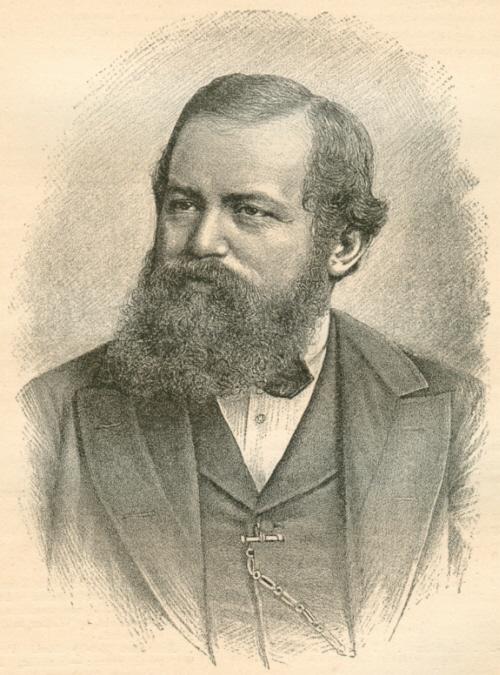
W. Steinitz. Source: Chess Monthly, March 1891, page 193
‘This little man has taught us all how to play chess’ is a famous remark about Steinitz by Adolf Schwarz, as discussed in C.N. 4375. Here we add a nineteenth-century citation, from page 165 of the August 1897 American Chess Magazine:
‘The chess world owes a debt of gratitude to the past-master, and here is an opportunity to partly repay it. At the Vienna tournament of 1882 the noted chess master Adolph Schwartz [sic], pointing to Steinitz, said, “This little man has taught us all to play chess”, and no truer word was ever spoken. He is the father of modern play, and Lasker, Pillsbury, Tarrasch, in fact all who rank high in chess, willingly acknowledge in him their teacher. Paraphrasing a well-known saying, one can stick a pin at random in any handbook and one will find an innovation by Steinitz and adopted since by the chess world. Moreover, he was the pioneer of scientific annotation, and the best analysts of the day are his pupils.’
An alternative version of the remark under discussion:
‘... Dr Emanuel Lasker said, “This little man taught us all we know”.’
Source: page 17 of Ray Keene’s Good Move Guide by R. Keene and A. Whiteley (Oxford, 1982).
(6505)
For a touched-up version of the above picture of Steinitz, see C.N. 10147.
‘Fischer Talks Chess’ was the title of a column which began in the June 1963 Chess Life. As noted on page 166 of A Chess Omnibus, some of the material was subsequently used, in revised form, in My 60 Memorable Games. On pages 302-303 of the December 1963 issue Fischer wrote up his win over Bisguier at that year’s New York State Open Championship (game 45 in the book). Thus his famous remark about 1 e4 (‘Best by test’) appeared in print in 1963.
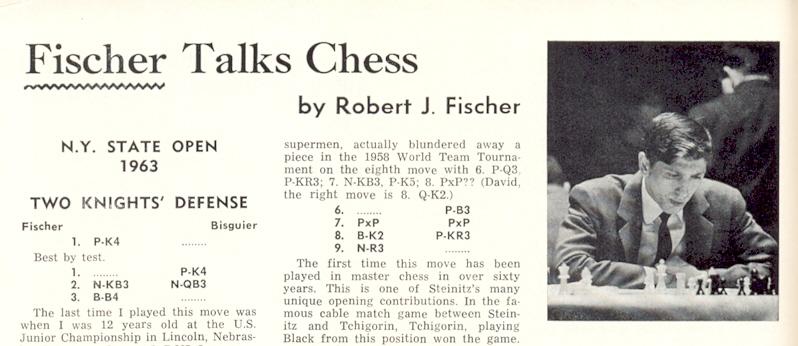
That was also the game in which Fischer discussed and corrected analysis of a Steinitz v Chigorin game which had been given on page 77 of the March 1892 Deutsche Schachzeitung, and for readers who wish to compare the two sets of comments (as well as what appeared in My 60 Memorable Games) we reproduce below the relevant passage from page 302 of the December 1963 Chess Life and the note in the Deutsche Schachzeitung:
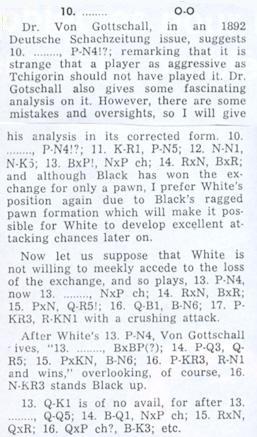
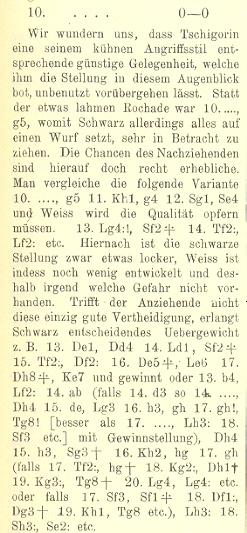
It may be noted that in the penultimate paragraph in Chess Life the pawn exchange given by von Gottschall was omitted, so that Fischer had ...Rg8 at move 16, instead of move 17. Those moves were, however, given accurately in My 60 Memorable Games.
(4423)
On page 7 of The Kipping Chess Club Year Book 1943-1944 Mieses referred to his draw against Steinitz at Hastings, 1895:
‘At the conclusion of the game he congratulated me upon the quality of my play and I feel bound to say flattery was by no means his weakness, and I was very proud of having impressed the world’s greatest chess connoisseur by my play.
It is no way “a game for the gallery” but rather one in which the expert will discover the “ghosts slumbering under the cover” …’
(A Chess Omnibus, page 395)
John Hilbert submits a passage from the New York Times of 12 January 1886, the day after the first game of the Steinitz v Zukertort match was played in New York:
‘Nobody has such a commercial interest in a “chess boom” as the makers of billiard tables have in a “billiard boom”. It is unlikely that the match between Steinitz and Zukertort will result in any popular revival of chess. There was such a revival following upon the victories of Morphy, and for a few years thereafter chess was much more actively and generally pursued than it has been since. The interest in Morphy’s success was patriotic, but that interest does not attach to a series of games between two Germans, one of whom happens to be a naturalized citizen of the United States. Of course, confirmed chessplayers will follow these matches with the interest that properly attaches to a contest between two players, either of whom is doubtless superior to any other than his present antagonist.’
(4709)
The passage from the New York Times of 12 January 1886 in C.N. 4709 suggested that Steinitz was ‘a naturalized citizen of the United States’, but Robert John McCrary (Columbia, SC, USA) quotes from page 364 of the December 1888 International Chess Magazine to show that naturalization came later:
‘On the 23d ult. Mr Steinitz was sworn in as a citizen of the United States. The veteran Mr F. Perrin was his sponsor to testify to Mr Steinitz having resided for five years in the State of New York.’
Another point raised by our correspondent is whether Zukertort was a naturalized British citizen. We are not sure. His obituary on pages 307-309 of the July 1888 BCM stated, ‘... he settled in London, becoming naturalized in 1878’. However, page 24 of Johannes Zukertort Artist of the Chessboard by Jimmy Adams (Yorklyn, 1989) referred to that obituary and added, ‘... the Home Office, Nationality Department, has no record of this’.
(4714)
Joost van Winsen (Silvolde, the Netherlands) offers details regarding Blackburne, Gunsberg, Hoffer and Steinitz from the records in British censuses. On Steinitz:
1871 census: William Steinitz. Age: 33. Born in Prague, Bohemia, Austria. Address: 2 Princes Street, St Giles without Cripplegate, London. Occupation: Professor of chess. Married to Caroline Steinitz (age 25). Child: Flora Steinitz (daughter, age 4). The address was shared by several households.
1881 census: Wm. Steinitz. Age: 44. Born in Austria. Address: 11 Newton Street, Shoreditch, London. Occupation: Journalist. Married to Caroline Steinitz (age 35). Child: Flora Steinitz (daughter, age 14).
(4756)
It is de rigueur for the subject of a spoof to profess himself ‘vastly amused by it’ and to appear, at least, a good sport who will take it all in good part. Steinitz, though, took public offence when parodied by Tarrasch, and the consequences were unexpected.
On pages 276-278 of the September 1890 International Chess Magazine he wrote at length about Tarrasch and followed up with some notably critical remarks about him on page 308 of the October 1890 issue. Subsequently, on pages 60-63 of the February 1891 Deutsche Schachzeitung, ‘Dr T.’ annotated a game Vier – v. Dreizehn, Magdeburg, 20 July 1920, which went 1 Nf3 Nf6 2 Nc3 Nc6 3 Ng1 Ng8 4 Nb1 Nb8 5 Nh3 Na6 6 Na3 Nh6 7 Ng1 Ng8 8 Nb1 Drawn. Steinitz reacted as follows on page 45 of the February 1891 issue of the International Chess Magazine:
‘A certain Dr ---sch was some time ago mildly taken to task in this column, page 308, October 1890, International Chess Magazine, for what would have deserved to be called an exhibition of ill-breeding. In the last number of the Deutsche Schachzeitung somebody, disguised under the predicate and initial of Dr T., takes a terrible literary revenge on page 307 of this magazine for the sin committed on page 308. The targets for the chess critical retribution are my remarks on my 13th move in the Two Knights’ Defence, Kt-Kt sq, and especially my comments on the circumstance that six of the pawns on my side were unmoved. On this theme Dr T. constructs a game which it is supposed will be played in 1920 at some chess congress in Germany, and in which both parties move their knights backwards and forwards to B3, Kt sq, and R3, etc. Before framing the notes to this “game of the future”, the wonderdoctor of Nuremberg has probably performed a surgical operation on his own cranium during the leisure hours which his “ärtzliche Praxis” allows him, in order that he might be able to see the joke or wit of his remarks. On my mind it leaves no other impression than that a man who, instead of turning over a new leaf, say to page 308, and making some kind of apology for his ill-mannered behaviour, aggravates his first offence by such a performance of a “dummer Junge” in his “Flegeljahre”, cannot be a genius like Morphy or Anderssen, who, like all true men of supreme eminence, always behaved like gentlemen.’
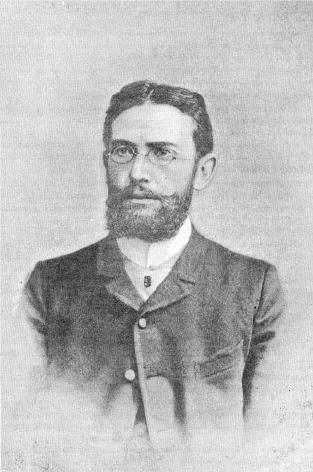
Siegbert Tarrasch
But then came a memorable article by Tarrasch entitled ‘Bemerkungen zu dem Wettkampf Gunsberg-Steinitz’ on pages 88-91 of the March 1891 Deutsche Schachzeitung which eulogized Steinitz as a genius. Below is part of Steinitz’s response, from pages 80-82 of the March 1891 International Chess Magazine:
‘To return to Dr Tarrasch, his answer to the mild rebuke which I administered more to his “Post Official” president than to himself came in the shape of the grossest satire that has ever been written on my theories and my practical play. It turns out to be a mere joke, not a good one – I must say nor in good season. The target for his caustic missiles was apparently my play in the cable match, and considering the responsibility which rested on my shoulders and that I had staked on that contest at least a great part of my reputation in the eyes of the general public, I could hardly be expected to take in very good part such an interference from one who had already seriously trodden on my toes. So much as an explanation of my own action in the quarrel, which was not of a very serious character, though it seemed to degenerate into one of those sanguine literary warfares which have caused me much unhappiness in the course of my life. As usual, however, I was not the aggressor, and the matter was not a mere personal squabble, but was one which in the exercise of my editorial duty could be fairly criticized before the public.
Dr Tarrasch has now made more than honorable amends for his “Zukunftsschach”, or chess of the future, with a research into chess of the past which for boldness of thought and expression, inspired by thorough honesty and magnanimous feeling, has not had its equal in chess criticism of first-class experts within my recollection. It is the handsomest recognition that has ever been accorded to my work and aims as a player and analyst, and its promulgation by a master of a new generation at a time when probably, and to all appearance, my old powers are on the wane, leads me to hope that at least the flagrant injustice to which I have been constantly subjected during the greater part of my career may go out of fashion during my lifetime. Dr Tarrasch’s remarks are really too flattering to me to be quoted in this journal, and I shall only cite one item which has never been mentioned in public. Speaking of myself he says: “He has learned of the game only as much as a second-class player – the rest he has done from his own means. The whole of the modern conduct of the game, or at least by far the greatest part of it, is his work.” The first sentence of the above, which can be easily verified from my games, shows at any rate that Dr Tarrasch has made himself well acquainted with the progress of my play. Unlike some shallow critics who have given me credit for book knowledge or practically credited others with my own new ideas, the Doctor lays most stress on the originality of my play, and I may only take this opportunity to affirm that only just now, while writing my own book, I am going through the openings systematically for the first time in my life. But when Dr Tarrasch denies the genius of Morphy on the ground that the great master did not create anything new in the opening or in the general conduct of the game I must, in common justice, strongly express my dissent from such a conclusion. In my opinion any player of first rank must possess a certain amount of genius at least, including that of some originality, for no learning will be sufficient for mastering the complications of the middle-game. Any extraordinary performance, whether it be the result of the excess of one excellent quality or a rare combination of fine qualities, may be taken as an absolute sign of genius, and in the case of Morphy his youth cannot be ignored in estimating his standard of eminence.’
These substantial texts by Tarrasch and Steinitz about the latter’s place in chess history have received insufficient attention, whereas the eight-move-game parody is well known. Among the places it has appeared in English are pages 121-123 of the March 1891 BCM, pages 151-152 of Checkmate, April 1903 and pages 154-156 of The Treasury of Chess Lore by Fred Reinfeld (New York, 1951).
Finally, the note at Black’s seventh move takes us back to C.N. 2323 (see page 344 of A Chess Omnibus), which discussed the phrase ‘the father of modern chess’. Those words appeared, with reference to Steinitz, in the BCM version of the parody, which was credited to the New York Herald. However, the relevant phrase in the Deutsche Schachzeitung original was ‘der Vorläufer unserer modernen Schachstrategie’.
(4773)
From Robert John McCrary:
‘Page 57 of my publication The Hall-of-Fame History of US Chess (1998) has an article tracing the scale of powers that were given in Amusements in Chess and in Staunton to an earlier source: an 1817 edition of Philidor’s analysis, apparently done by Peter Pratt. In that edition, Pratt devoted 40 pages to mathematical analysis of various factors, leading to his concluding scale of Q=9.94, R=5.48, B=3.5, N=3.05, P=1. He suggested rounding off the scale, but Staunton and Steinitz printed it with full decimal places.
I have subsequently found that Pratt, as early as 1805 and probably earlier, gave two different scales, based on different lines of reasoning. The first scale had P=2, N=12, B=14, R=15, Q=28, K=9, whereas his second scale was P=2, N=9.25, B=9.75, R=15, Q=23.75, no K value. Apparently Pratt later developed the mathematical analysis printed in 1817. The same figures were used not only by Staunton in his Handbook but also by Steinitz (on page xxxiii of The Modern Chess Instructor), and ultimately became our modern scale.’
(4902)
See The Value of the Chess Pieces.
Marc Hébert (Charny, Canada) draws attention to a news item in the chess column on page 4 of the Morning Chronicle (Quebec), 24 May 1888:
‘In a match of five games, at the odds of a Kt, with Herr Steinitz, Señor S. Lopez, of Havana, aged 14, succeeded in winning four games. The champion pronounces the youth a promising player.’
We give below the account that had appeared in Steinitz’s International Chess Magazine, April 1888, page 79. The reference to the 14-year-old boy, together with his actual score against Steinitz, begins nine lines from the end.
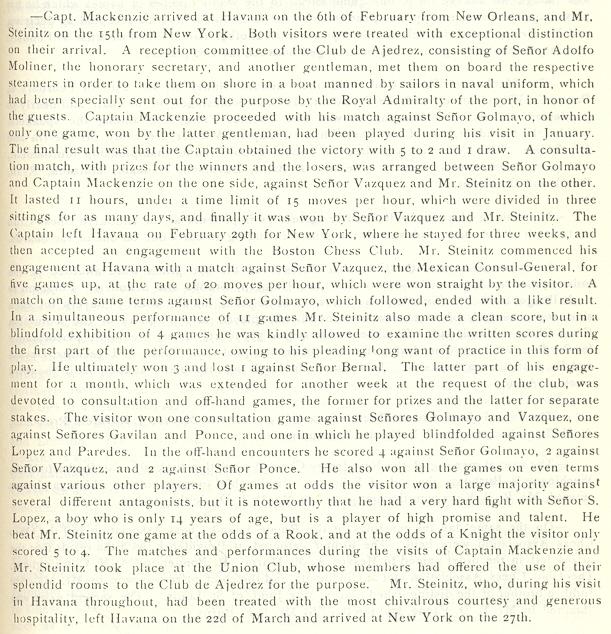
(4910)
For Steinitz in connection with other young players, see Chess Prodigies.
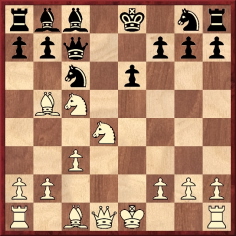
White to move (W. Steinitz v Voigt, Philadelphia, 1885)
12 O-O Qxh2 mate. This may be regarded as the ultimate case of ‘castling into it’.
(4976)
We gave the full game-score in Kingpin in 2000 and on page 313 of A Chess Omnibus. See too Black Plays ...Qh2 mate.
From John Roycroft (London):
‘Do any photographs or good drawings exist, possibly in contemporary Russian sources, of the chessmen used in the 1896-97 world title match in Moscow between Lasker and Steinitz? Moreover, are there any illustrations of the match sponsors and the “playing committee”? My particular interest is in establishing whether or not reports are correct that a chess set was made in Russia to the order of Steinitz.’
(5020)
This question was also asked without success in C.N. 6027.
Joost van Winsen submits an interview with Gunsberg which was published in the Bradford Observer Budget of 28 July 1888.
‘Questioned as to his relations with Steinitz, Mr Gunsberg said he had played one game against Steinitz when the latter was giving a simultaneous performance in 1877, and that he (Gunsberg) lost. He added that he considered Mr Steinitz undoubtedly the strongest living exponent of the game. He should very much like to play him a match, but not until his play got a little more mature. Gunsberg frankly admits that his weakness as a chessplayer is impetuosity in attack, and he observed that when he did undertake to play the champion he should stand a good chance, the natural inference from that statement being that he means to prepare himself for the encounter. Steinitz is not exactly notorious for friendliness of feeling toward other noted chessplayers. Regarding this point Gunsberg says he met Steinitz frequently for years, and was on friendly terms with him, but he doubts whether the champion would still feel inclined to be very amiable to him, though his own feelings towards him are unaltered.’
(5136)
For the complete text of the interview (material not directly concerning Steinitz), see our feature article on Isidor Gunsberg.
Pages 171-172 of the 30 July 1893 issue of Emanuel Lasker’s magazine the London Chess Fortnightly quoted some remarks about Gunsberg by Steinitz in the New York Tribune. The context was a dispute over whether Lasker had a right to issue a world championship challenge to Steinitz, and we give merely the start of the latter’s salvo (which Lasker quoted approvingly):
‘Mr Gunsberg is not alone a chess professor, but he also professes to be a philosopher of the so-called “individualistic school”, and he has lectured and written on doctrines which, if I may quote myself, are based on the theory that “one man has rights, but two men have none”. When, however, he applies his egoistic principles to chess affairs, he finds that though he may be unique in the chess world he is not alone in it. For instance, he seems to be possessed of the idea that the championship of the world can only be at stake when he himself is a party in a contest. Thus he played a match with Chigorin for “the championship of the world”, and the whole chess world laughed. He fought another for the title against myself in which he virtually received the odds of the draw and played to take advantage of the odds. The whole chess world might have laughed if – he had won it ...’
(5137)
Our translation of an article by J.R. Capablanca published on pages 1-4 of the Uruguayan chess magazine Mundial, May 1927 includes the following:
‘... Steinitz was a better stylist at the beginning of his career than in his final period. He began as a brilliant player of open games and finished as a prototype of the extremely closed style. At some point he must have passed, however fleetingly, through the stage representing a happy medium, the perfect type of play.
He was the first person to establish the basic principles of the real general strategy of the game. He was also a pioneer as well as one of the most profound investigators of the hidden truths of chess. At a certain time he played the openings well, but later he converted his principles into caprices, thereby lessening his winning chances in serious battles against some of his most formidable opponents. His combinative power was very great. He was also a very fine endgame player, and it is in fact essential to be a strong endgame player to become world champion. He was very tenacious and in his youth, when he was playing at the top of his form, he was almost invincible.’
For the full article, see Capablanca on his Predecessors.
From page 190 of Modern Chess Strategy by Edward Lasker (London, 1951):
‘I recall a remark which Emanuel Lasker made one day as we were discussing the characteristic differences between the older and the younger generation of chess masters. He said modern tournaments were much harder because the young masters played much more exact chess than was encountered in tournaments up to the great meeting in New York in 1924. He felt that the old masters – Steinitz, Schlechter, Tarrasch, Teichmann, Bernstein, etc. – had played just as deep chess as can be found in any modern game, perhaps even deeper because they played more slowly, but that they lacked the accuracy with which present-day masters took advantage of the slightest positional superiority.’
(5189)
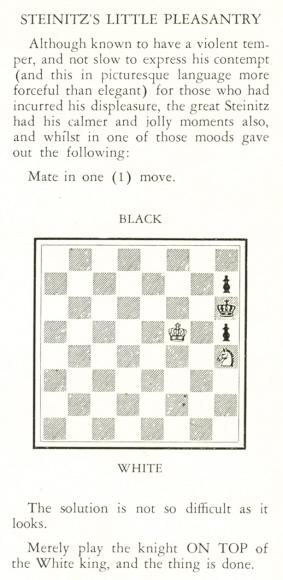
The above comes from page 39 of Chess Potpourri by Alfred C. Klahre (Middletown, 1931). What more is known about the ‘composition’?
(5270)
‘In the success of Tarrasch, Steinitz’s method of play has achieved its greatest triumph. But the scholar is acting more faithfully on the precepts of the teacher than the master himself, who will often forget his own teachings and adhere to crotchety lines of play in the openings, a thing which Tarrasch never does.’
Gunsberg, in the Evening News, quoted on page 410 of the October 1890 BCM.
Kings, Commoners and Knaves, page 387
An extract from The Facts about Larry Evans:
In his December 1999 column, an item about the age factor in chess masters, Evans was asked a question which included a reference to a match (against Steinitz) which Zukertort was said to have played, at the age of 44, in 1892. As we pointed out in the February 2000 issue (page 8), this was unlikely, given that Zukertort had died in 1888. That could have been the end of the matter, but Evans’ response on the same page was as emphatic as it was false:
‘Edward Winter has an exaggerated notion of his own importance and, as usual, makes mountains out of molehills (obviously 1892 was a typo instead of 1872).’
He continued to construct his own mountain in the July 2001 column:
‘Does Mr Winter truly believe it [i.e. the date 1892] was anything more than a typographical error? I think not.’
An interesting question. The date 1892 that appeared in the December 1999 issue was obviously wrong, but was it, as Evans assured his readers, an obvious typo for 1872? Definitely not, for the simple reason that 1872 is also wrong. Since the Steinitz-Zukertort match under discussion was specified as having been played when Steinitz was 50 and Zukertort was 44 (although their actual ages were 49 and 43 respectively), the event was ‘obviously’ their world championship match of 1886. A normal writer would be embarrassed to discover that in endeavouring to correct one wrong date (1892) he had categorically and disparagingly put forward another one (1872) which in reality was even further from the right one (1886).
Page 3 of Chess Lyrics by Alain C. White (New York, 1905) quoted from A.F. Mackenzie’s memoir of Steinitz in the Jamaica Gleaner, 1900:
‘One interesting trait in Steinitz’s chess character was his warm admiration for and strong advocacy of problems, the “Poetry of Chess”. He was no composer himself, but a very expert solver; and on one occasion signalized his interest in the art by taking part in a problem solution tournament. This fact is worthy of passing notice, because there are those who affect “to see no good” in problems, and depreciate their study on the hypothesis that it has a prejudicial effect on the power for play over the board. This is a most mistaken notion; for the very contrary is the fact, and the study of problems is bound to improve one’s practical play. It will be generally found, however, and it is a rather curious coincidence, that those who preach that fallacious doctrine know nothing whatever of problems. They have never journeyed through the fairyland of problem lore; nor, indeed, have they the capacity to understand or appreciate its delights. They are, in fact, so many chessical gradgrinds. With souls that cannot soar into the infinite of chess, they are dead to the spirit of its poésie. The homely aphorism “you cannot make a silken purse out of a sow’s ear” aptly fits their case; and when he who held the sceptre of the chess world for over a quarter of a century paid such high tribute to the charm and worth of problems, the apostles of that other faith may well be allowed to revel in the luxury of their own benighted belief.’
The happy term ‘chessical gradgrinds’ takes a place in our Chessy Words list. It antecedes the entry ‘… we are much mistaken if affairs chessical do not enjoy a notable enlivenment so long as he remains in our midst’ (W.E. Napier writing about Eisenberg in the Pittsburgh Dispatch, 4 August 1904).
(5347)
From page 293 of the Chess Player’s Chronicle, 13 December 1890:
‘This game is a further illustration that, as Steinitz says, “the most difficult part of chess is to win a won game”.’
Can other early instances of the remark be found, in the writings of Steinitz or anyone else?
(5349)
See Chess: Winning a Won Game.
From our feature article Master Roberts:
One of three consultation games played simultaneously by Steinitz:
John Drew Roberts and C. Tuthill – Wilhelm Steinitz
Dublin, 12 January 1881
Two Knights’ Defence1 e4 e5 2 Nf3 Nc6 3 Bc4 Nf6 4 Ng5 Nxe4 (Very seldom seen, although Steinitz himself had successfully faced it in an informal game against Wilson in London in 1862.) 5 Bxf7+ Ke7 6 d3 Nf6 7 Bb3 d5 8 f4 Bg4 9 Qd2 h6 10 fxe5 hxg5 11 Qxg5 Nxe5 12 Qxe5+ Kd7 13 Nc3 Bd6 14 Qg5 Qe7+ 15 Qe3
15…Qf8 16 Bd2 Re8 17 Ne4 Nxe4 18 dxe4 Rxe4 19 Bxd5
Black gave mate in two moves.
This game is absent from the various collections of Steinitz’s games, and its finish was confused. A number of publications (e.g. the Philadelphia Times and Cincinnati Commercial of 1881) gave Steinitz’s 18th move as ‘18…RxRP’. So did the Chess Player’s Chronicle of 25 January 1881 (pages 38-39), but it printed a correction in the following issue (1 February 1881, page 57).
From Ray Johnstone (Nedlands, WA, Australia):
‘Did Steinitz really lose on time in game six of his return match (1896-97) with Lasker, a loss rejected by Lasker? After 48 Kb2 Alex Dunne wrote on page 111 of 2010 Chess Oddities (Davenport, 2003):
“Steinitz exceeded the time limit at this point, but Lasker refused to win in this fashion and allowed Steinitz to play on.”’
Readers’ assistance in building up a digest of contemporary accounts will be appreciated. Here are two reports, the first of which corroborates the above quote:
‘48 Kc1-b2. Hier überschritt Steinitz die Bedenkzeit, Lasker proponirte aber Fortsetzung der Partie, und so wurde sie unter Zustimmung des Comités am nächsten Tage in folgender Weise zu Ende geführt.’
Source: Deutsche Schachzeitung, January 1897, page 10.
In contrast, page 8 of the 15 January 1897 issue of La Stratégie stated that the game was adjourned after 47...Rc8 and that the following day Steinitz was indisposed and did not appear. Instead of forfeiting Steinitz, the Committee allowed him to continue play the next day but one:
‘La partie a été ajournée ici et le lendemain M. Steinitz, malade, ne s’est pas présenté pour la continuer. Le Comité au lieu de lui compter la partie perdue l’a autorisé à la finir le surlendemain ...’
(5687)
From Michael Clapham (Ipswich, England):
‘I have a typescript of a book on the second world championship match between Lasker and Steinitz, although no book was ever published on this match. The title page states that the games were taken from Deutsches Wochenschach with annotations by Siegbert Tarrasch. I do not know who compiled the typescript, but there are the occasional “Translator’s Notes” which may provide some clues.’
Our correspondent has provided sample pages.
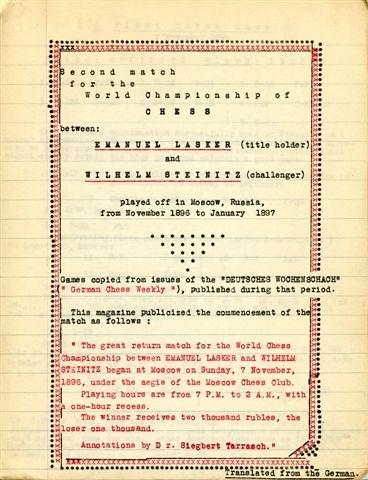
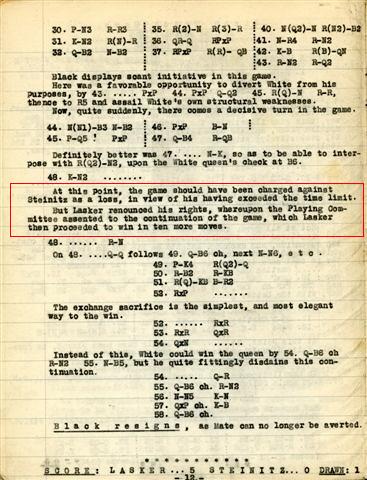
(5691)
Olimpiu G. Urcan submits three sketches featuring Lasker, Chigorin, Pillsbury and Steinitz (the participants at St Petersburg, 1895-96). The illustrations are taken from the New York Tribune chess column of, respectively, 8 December 1895, 5 January 1896 and 12 January 1896.
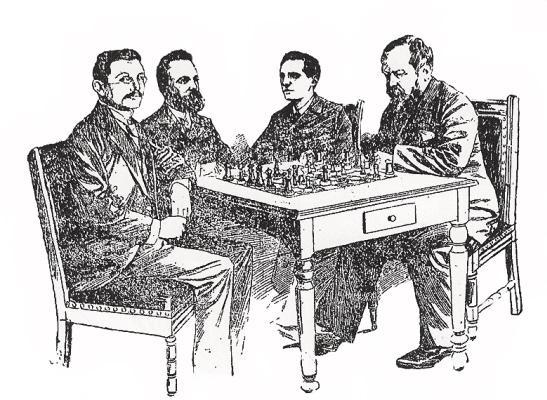
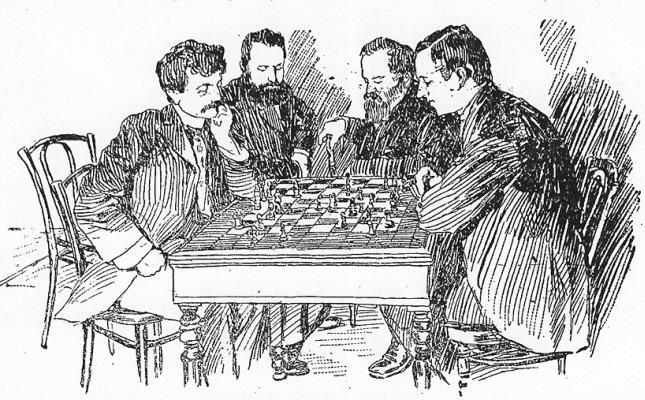
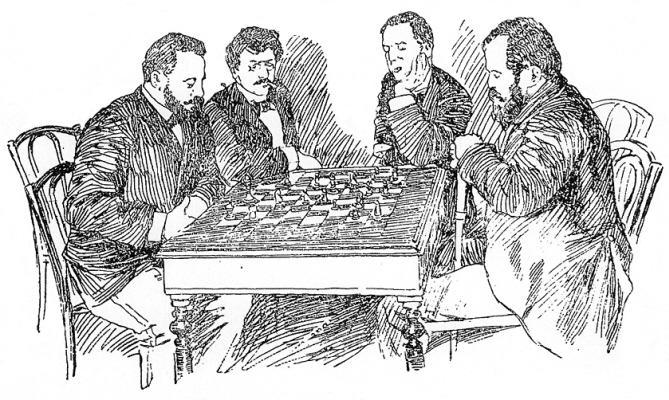
(5713)
From our feature article on The Batsford Chess Encyclopedia by Nathan Divinsky (London, 1990):
‘Page 81 reports that Steinitz used the term hanging pawns, but page 144 states that Nimzowitsch introduced it.’
If the page references are replaced by 135 and 213, the comment of ours also applies to The Encyclopedia of Chess by Harry Golombek (London, 1977). That is no great surprise, given that so much of Golombek’s book was repeated by Divinsky, without acknowledgement or care.
(5725)
From The Smothered Mate:
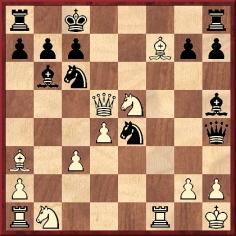
W. Steinitz – R. Stein, New York, 27 November 1884 (simultaneous exhibition against 22 players). White to move.
Steinitz announced mate in five moves by 16 Qe6+ Kb8 17 Nd7+ Kc8 18 Nxb6+ Kb8 19 Qc8+ Rxc8 20 Nd7 mate. In his annotations (International Chess Magazine, January 1885, pages 24-25) he described this as ‘an ordinary version of the smothered mate’, and it had indeed already been known for many centuries.
Owen J. Clarkin (Ottawa, Canada) quotes from The Modern Chess Instructor by W. Steinitz (New York, 1889):
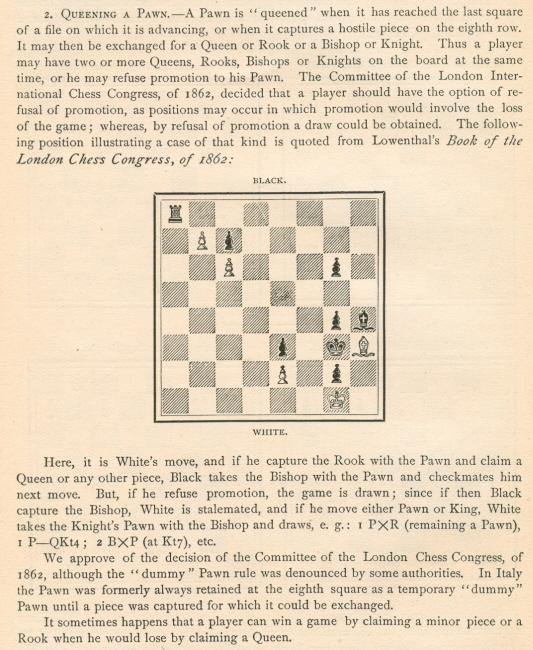
Mr Clarkin asks the following:
‘(1) Was “non-promotion” generally allowed in the mid- to late-1800s, i.e. to what extent were the Code of Laws of the British Chess Association of 1862 adopted? On page xx of his book Steinitz claimed that they were applied “... in many Chess Congresses”.
(2) What more is known about the bishop and pawn ending presented by Steinitz on page xxiv, which was given in the entry on promotion in The Oxford Companion to Chess as a composition by Kling?
(3) Are there any known instances of a pawn retaining its identity on the eighth rank in over-the-board play?
(4) Is it known whether Steinitz always supported rules allowing non-promotion?
(5) Under what circumstances was it generally decided that a pawn reaching the eighth rank must be promoted?’
We hope to revert to these matters in due course, and readers’ contributions will, as ever, be appreciated. Firstly here, it may be noted that the position given by Steinitz had appeared, attributed to Kling, on page lxxii of Löwenthal’s book on London, 1862, introduced as follows:
‘Mr Staunton maintained that to allow a pawn at its eighth square to remain a pawn was a serious innovation, a gross absurdity and a violation of the fundamental laws of the game. In reply, it was pointed out that a pawn remaining a pawn at its eighth was no novelty, Mr Staunton himself giving in the Praxis a game from Ponziani in which an example occurs; that the law relative to the point had been altered several times; that as to the reproach of innovation, the game itself was nothing but the result of a series of innovations on its original form; and that Mr Staunton had admitted in the Praxis that the tendency of modern legislation was to consider the queening a pawn as the highest feat which a player can accomplish, and to reward it with the greatest possible advantage. It was urged that to compel a player to choose a superior piece without the option of refusing promotion would not in all cases confer the greatest possible advantage, there being positions in which a player compelled to take a superior piece would be subjected to a fatal penalty, the following being an instance adduced by Mr Kling ...’
In the Kling position The Companion had a white pawn, not bishop, on h3.
As regards the game given by Ponziani, the following score appeared on pages 41-42 of Staunton’s Chess Praxis (London, 1860):
1 e4 e5 2 f4 exf4 3 Nf3 Be7 4 Bc4 Bh4+ 5 g3 fxg3 6 O-O (Kh1, Rf1) d5 7 Bxd5 Bh3 8 Bxb7 g2+ 9 Kg1 gxf1
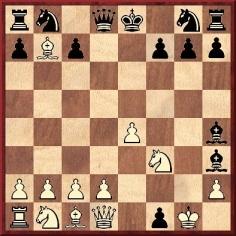
10 Bxa8 Bf2 mate.
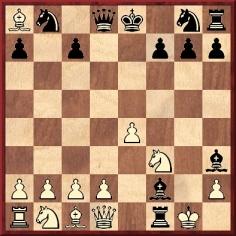
The unit on f1 had to remain a pawn until it could be replaced by a captured black piece.
Staunton wrote:
‘There is so much of the absurd about such a finale as this that no-one will consider it worthy of serious examination, and it is only mentioned as a matter of curiosity.’
Pages 219-221 of the Chess World, 1865 had a letter from W.S. Pavitt of Chelmsford on the dummy pawn (‘that exquisite stroke of chess legislation’) in the context of chess problems, and the following item was published on page 311 of the American Chess Journal, April 1879:
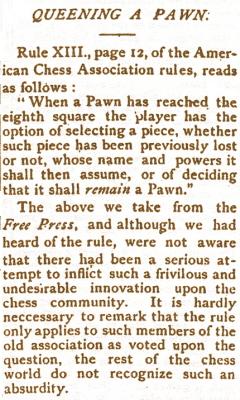
(5791)
See also Chess Variants and Rule Changes.
Michael Clapham sends an extract from the chess column by J.H. Sweet in the American Chronicle, 12 March 1868:
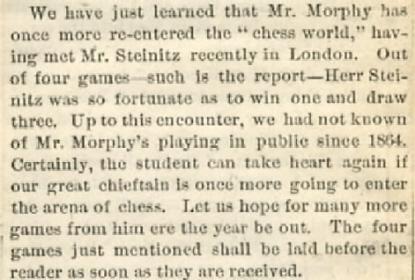
Our correspondent adds:
‘I have every column from its inception on 7 November 1867 up to the last, dated 30 July 1868, but I can find no further mention of these games, or a retraction.’
David Lawson discussed the matter on pages 288-289 of his 1976 biography of Morphy. After quoting Wilkes’ Spirit of the Times from early 1868 (‘Rumor says that he [Morphy] has played four games with Mr Steinitz, losing one and drawing three’), Lawson wrote:
‘Unfortunately for the chess world, they had not met, nor did they until 1883 during Steinitz’s visit to New Orleans. About this time, 1863 [sic], Steinitz had had several games with a Mr Murphy of London, and evidently someone, finding Steinitz’s opponent rather vaguely described, thought it was Morphy. This mistake was made even though Steinitz was conceding odds of pawn and move to his opponent, which should have canceled the possibility that the opponent was Morphy. Some of these games were published in 1863 in the Chess Player’s Magazine.’
(5844)
Page 141 of Kotov’s Think Like a Grandmaster professed to quote Steinitz:
‘A chess master has no more right to be ill than a general on the battle field.’
No source was given, and the closest remark that we can find is a ‘once’ version on page 195 of the Chess Monthly, March 1891:
‘It was alleged, and justly so, for that we can vouch, that Zukertort’s health was failing; but we agree with Steinitz in the remark he made once: “A first-class player has no right to be ill.”’
(5890)
Pablo S. Domínguez (Madrid) reverts to the alleged remark by Steinitz, ‘a chess master has no more right to be ill than a general on the battle field’. He notes the following passage, written in the context of the 1896-97 Lasker v Steinitz world championship match, on pages 21-22 of Los campeonatos del mundo. De Steinitz a Alekhine by Pablo Morán (Barcelona, 1974):
‘Esta segunda derrota frente a Lasker fue un duro golpe para Steinitz, pero siempre deportivo, poco después escribía en un diario de Nueva York: “¿Por qué he sido derrotado en forma tan lamentable? En primer lugar, porque Lasker es el más grande jugador que he encontrado; posiblemente el más grande que jamás haya existido. Al afirmar expresamente esto, parecerá que quiero disculparme, rebajando, al mismo tiempo, a otros rivales; pero soy incapaz de hacer tal cosa refiriéndome a maestros de primer orden. Alguna vez he dicho estas o parecidas palabras, que un maestro tiene tan poco derecho a sentirse enfermo en una prueba, como un general en un campo de batalla. Y permanezco fiel a este pensamiento.”’
Our correspondent supplies the following translation:
‘This second defeat against Lasker was a heavy blow for Steinitz, but, always the sportsman, he wrote soon afterwards in a New York newspaper: “Why have I been beaten in such lamentable fashion? Firstly, because Lasker is the greatest player I have met, and possibly the greatest that has ever existed. In stating this expressly, it will seem that I wish to make excuses, while at the same time putting down other rivals, but I am incapable of doing such a thing with regard to first-rate masters. I once said these or similar words: a master has as little right to feel sick in a contest as a general on a battle field. And I remain faithful to that idea.”’
Mr Domínguez comments:
‘It seems likely to me that there is a gap in Pablo Morán’s version of Steinitz’s article, as the closing sentence (“I once said”) does not follow on logically from his previous statements.’
A translation also appeared on pages 15-16 of the 1986 English edition of Morán’s book, The World Chess Championship: Steinitz to Alekhine.
Notwithstanding Morán’s remark about the timing of the statement, we now note that according to page 337 of William Steinitz, Chess Champion by Kurt Landsberger (Jefferson, 1993) it came in a letter from Steinitz dated 17 December 1896 which was published in the New York Sun on 3 January 1897. The relevant sentence, as quoted by Landsberger, is:
‘A chess master has the same right to be sick as a general on the battlefield, this or something similar is that [sic] I had written and I stick to this.’
(6058)
Robert John McCrary quotes from Steinitz’s ‘Personal and General’ column on pages 369-370 of the International Chess Magazine, December 1887:
‘No doubt, the great mental exertion which proficiency in the game imposes on its foremost practitioners taxes brain and nerve to an extent which makes chess masters liable to more or less troublesome disorders during a heavy contest. But usually this sort of sickness, or chess fever, does not last long, and it ought to be made a rule that a great chess practitioner has no more right to be ill than an athlete or a soldier on the battlefield; and if he is, it should only be taken as a sign of weakness and unfitness for chess mastery. The world is sick enough of maladies, and knows very well that it is more easy to become ill than to preserve, or eventually to recover, that serene balance of mind which is essentially necessary for the exercise of healthy mental action. On that subject, and on the relations between body and mind, I think “the art of human reason”, as chess has been termed, is destined to throw some light, just like bodily gymnastics have greatly contributed toward the knowledge of our structure and of the conditions under which physical strength can be acquired and maintained.’
Our correspondent also notes the early use of the term ‘chess fever’.
(6065)
Jerry Spinrad (Nashville, TN, USA) quotes from page 7 of part two of the New York Daily Tribune, 3 January 1897 (a letter dated 17 December 1896 just received from Steinitz in Moscow):
‘Why am I so badly beaten? In the first place, because Lasker is the greatest player I ever met, perhaps the greatest that ever lived; to say so positively would be like making excuses for myself and disparaging other rivals at a time when I myself am incapable to compete in the first rank. “A chess master has no more right to be ill than a general on the battle-field”, or words to that effect, I once wrote in the International Chess Magazine, and I adhere to that.’
We cannot explain why this wording is different from what appears on page 337 of William Steinitz, Chess Champion by Kurt Landsberger, where Steinitz’s letter was quoted as stating, for example, ‘A chess master has the same right to be sick as a general on the battlefield’. It may be recalled from C.N. 6058 that Mr Landsberger said that he was citing Steinitz’s letter as published in the New York Sun, also of 3 January 1897.
(6117)
Our feature article Early Uses of ‘World Chess Champion’ has remarks by Steinitz on whether he became the title-holder by defeating Anderssen in 1866. Now we add a quote from an article ‘Steinitz’s Career Reviewed’ reproduced on pages 105-106 of the July 1905 issue of Lasker’s Chess Magazine:
‘In 1865 I won the chief prize in Dublin, and it was then that a match was arranged for the championship of the world with Anderssen. One of the committee who arranged that match was the present Lord Chief Justice of England. I won it by 8 to 6, and became champion chess player of the world.’
The Lord Chief Justice (from 1894 to 1900) was Lord Russell of Killowen, whose obituary on page 367 of the September 1900 BCM mentioned that ‘he was a supporter of Steinitz in some of his early matches’.
Lasker’s Chess Magazine merely stated that the article had appeared in ‘a recent issue of the Jewish Chronicle’, but we can add that it came from a feature entitled ‘A Chat with Steinitz’ on pages 12-13 of the newspaper’s 4 August 1899 issue.
(5893)
Thomas Niessen (Aachen, Germany) adds a reference on page 286 of the Dubuque Chess Journal, June 1875: ‘William Steinitz, the present chess champion of the world.’
(9233)
Below is a section from the above-mentioned feature article:
On page 86 of the International Chess Magazine, April 1888 Steinitz asserted ‘for once’ that he had been world chess champion since 1866:
‘And I mean to devote to the task [i.e. exposing the alleged dishonesty of James Séguin], if necessary, the space of this column for the next 12 months, or for as many years, in case of further literary highway robberies perpetrated by the same individual, and provided that I and this journal survive, in order to statuate for all times, or as long as chess shall live, an example that the only true champion of the world for the last 22 years (I may say so for once), who has always defended his chess prestige against all-comers, has also a true regard for true public opinion, and that he can defy single-handed all the lying manufactories of press combinations to show any real stain on his honor; and that he can convict and severely punish any foul-mouthed editor who, like the shystering journalistic advocate of New Orleans, attempts to rob him of his good name outside of the chess board.’
From page 176 of the July 1888 International Chess Magazine:
‘Difficult as the task was, for I have had sometimes as many as half-a-dozen such editorial lunatics under treatment simultaneously, I have undertaken it empowered by my conscience and the right of natural selection, or, as Carlyle calls it, “the divine right of the strongest”, which, either by merit or accident, as you like to judge, has chosen me as the only true champion of the world for the last 22 years.’
C.N. 1780 quoted from the closing paragraph of the BCM’s obituary of Steinitz (September 1900, page 370):
‘As an analyst, the service which Mr Steinitz rendered to chess has never been equalled. He had a ready pen and incisive style – though he too often dipped that pen in gall. His work in the Modern Chess Instructor and his analysis of games in the International Chess Magazine was of a high order, but his base, scurrilous and filthy abuse of Mr James Séguin, the honourable and gentlemanly chess editor of the New Orleans Times Democrat, caused many issues of the magazine to be more suitable for consumption in the furnace than for preservation in the library of the chessplayer.’
Would a reader be prepared to go more deeply into this aspect of Steinitz’s writing, with regard to either Séguin or, perhaps, Hoffer? The main purpose would be to reach a clearer idea of the validity or otherwise of Steinitz’s reasoning and thus gain a better understanding of his character. To start with a brutally frank question: was James Séguin ‘honourable and gentlemanly’?
From C.N. 11989:
Has there been a trustworthy investigation of Steinitz’s objections concerning Séguin?
From the (unnumbered) page regarding a Steinitz v Chigorin game in Solitaire Chess by I.A. Horowitz (New York, 1962):

(6255)
Flemming Larsen (Copenhagen) asks about the existence of pictures from St Petersburg, 1895-96, and particularly shots of Lasker and Pillsbury.
Two come to mind, the first being on page 9 of the Russian edition of the St Petersburg, 1909 tournament book:
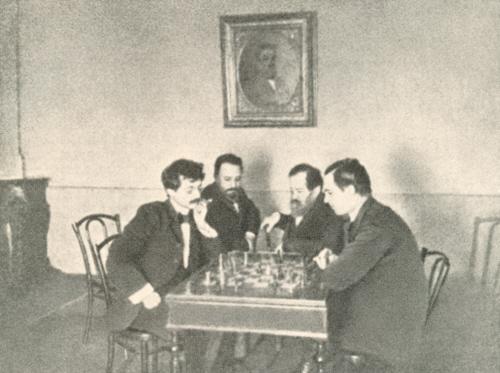
Secondly, and also with Chigorin and Steinitz, there is a picture on page 79 of 120 izbrannykh partiy M.I. Chigorina by N.I. Grekov (Moscow, 1952):
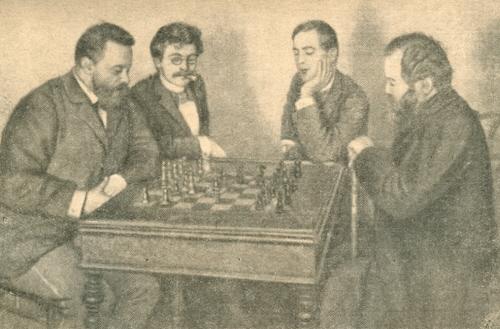
Page 69 of Chess An Illustrated History by Raymond Keene (London, 1990) had a photograph whose caption begins, ‘Under the remote gaze of a picture of Steinitz, Emanuel Lasker faces Harry Nelson Pillsbury in a game in 1896 in St Petersburg’. However, the photograph (which also shows a picture of G.H. Mackenzie on the wall) was taken at the Manhattan Chess Club. For purposes of comparison, see the illustrations in the February 1898 American Chess Magazine, as well as the photograph of Pillsbury at the Club on page 52 of A Picture History of Chess by Fred Wilson (New York, 1981).
(6434)
An item in Copying:
From the 1974 book The World of Chess by Anthony Saidy and Norman Lessing (page 115):
From the 1990 book Chess An Illustrated History by Raymond Keene (page 80):
As regards the origins of the ‘evergreen’ label for Anderssen v Dufresne, Irving Chernev wrote on page 549 of 1000 Best Short Games of Chess (New York, 1955):
‘Steinitz in poetic mood called this game “the blossom in Anderssen’s wreath of laurel” and named it “the evergreen partie”.’
The same text was attributed to Steinitz by Chernev on page 230 of The Chess Companion (New York, 1968).
But when was the description ‘Evergreen’ first used? And, in particular, was it ever seen during Anderssen’s lifetime? In The Field of 29 March 1879, page 362, Steinitz paid tribute to the late master by annotating his two celebrated games against Kieseritzky and Dufresne. Both sets of detailed notes were reproduced on pages 102-105 of the 1 May 1879 issue of the Chess Player’s Chronicle, and below we give Anderssen v Dufresne:
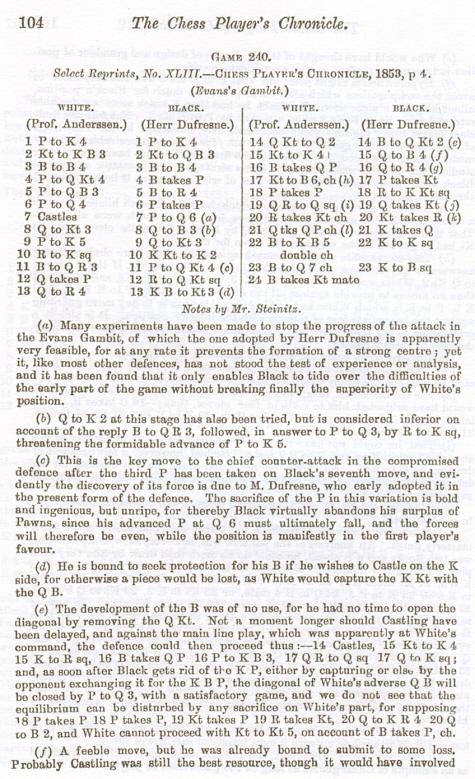
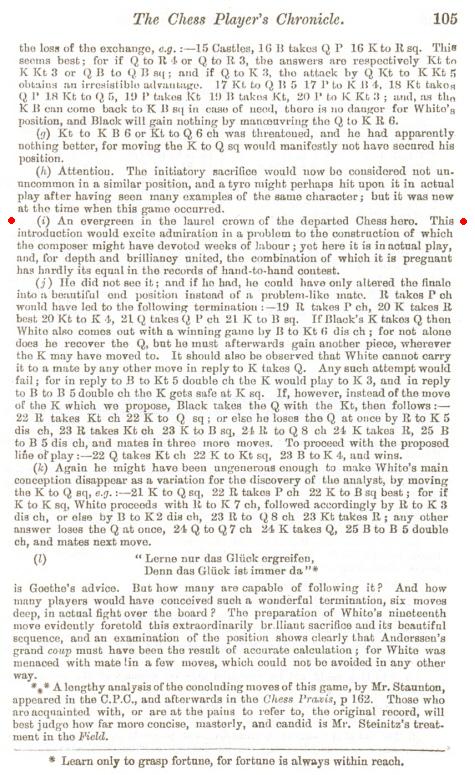
As marked, Steinitz’s note to 19 Rad1 began:
‘An evergreen in the laurel crown of the departed Chess hero.’
On page 72 of the March 1885 International Chess Magazine Steinitz simply referred to:
‘...Anderssen’s immortal game with Kieseritzky, and his no less famous Evans Gambit against Dufresne ...’
On the other hand, page 147 of Dictionary of Modern Chess by Byrne J. Horton (New York, 1959) affirmed:
‘Steinitz spoke of the “Immergrün Partie” meaning the “Evergreen game” ...’
What more can be found in Steinitz’s writings? In particular, what details can be traced further to Chernev’s statement that Steinitz used the specific term ‘evergreen partie’?
See too pages 157-158 of The Steinitz Papers by Kurt Landsberger (Jefferson, 2002).
C.N. 9444 quoted from a tribute to Anderssen by Steinitz on page 362 of The Field, 29 March 1879 which included the following:
‘... no living player can boast of such a grand record of numerous triumphant victories in tournaments as have been achieved by Anderssen. Nor had he his peer as regards elegance and brilliancy of style; and some of his games, like those published below [the Immortal Game and the Evergreen Game], will ever be regarded as amongst the finest specimens of bold and surprising chess tactics, combining beauty of conception with depth of design.’
Our item added that Steinitz’s notes to the Immortal Game included the following after 18 Bd6:
‘This and the rest of Anderssen’s conduct of the attack mark the limit of ingenuity and brilliancy exhibited in the actual contest up to our time.’
The concluding observation by Steinitz on the Anderssen v Kieseritzky game:
‘In memoriam of Anderssen, the present masterpiece will be treasured as an example of chess genius as long as the game shall be played.’
C.N. 3189 (see pages 194-195 of Chess Facts and Fables) quoted Steinitz’s words on page 42 of the February 1888 International Chess Magazine, in his ‘Personal and General’ feature:
‘This is not a private column, but I beg leave to announce that my most cherished hopes are dead and buried in the grave of my daughter, an only child who, on the 13th ult., died at the age of 21 years from rheumatism of the heart after an illness of nearly four months.’
After commenting that no photograph of Steinitz’s daughter was known to us in any chess book, we asked whether a reader could find a Cuban item referred to on page 79 of the Columbia Chess Chronicle, 17 March 1888:
‘El Sport, of Havana, devotes the entire first page to a portrait of the late Flora Steinitz.’
Now, Christian Sánchez (Rosario, Argentina) points out that a text from El Sport, entitled ‘Heure de nuit’, was reproduced on pages 220-222 of En el ocaso by A.C. Vázquez (Havana, 1898). The tribute to Flora Steinitz stressed the extensive assistance which she had given her father (‘Ella era quien llevaba los libros mercantiles, la correspondencia epistolar, la dirección de todos los negocios del Sr. Steinitz’) and stated that the master always carried a portrait of her (‘retrato del que no se separa ni un solo instante’).
However, no picture was given by En el ocaso, and although the article also stated ‘Al dar hoy El Sport el retrato de la señorita Steinitz ...’ we wonder whether, in that passage, the word ‘retrato’ does indeed refer to a picture, as opposed to a verbal portrait. The same question arises from the above-quoted use by the Columbia Chess Chronicle of the similarly ambiguous English equivalent of ‘retrato’: ‘portrait’.
En el ocaso specified that the tribute to Flora Steinitz appeared in El Sport (Havana) on 1 March 1888. Can that original publication be found?
In the meantime, Christian Sánchez mentions that the complete 352-page work En el ocaso has been digitized by Google Books.
(6545)
Hans Renette (Bierbeek, Belgium) notes that the feature on Flora Steinitz in the Cuban publication El Sport, 1 March 1888 can be viewed online courtesy of the University of Miami Libraries. Page one gave a large portrait, and Andrés Clemente Vázquez published a eulogy to her on page 2.
(9776)
[Link broken.]
Page 166 of The Most Instructive Games of Chess Ever Played by I. Chernev (New York, 1965) gave a famous quote ascribed to Bird, regarding Steinitz:
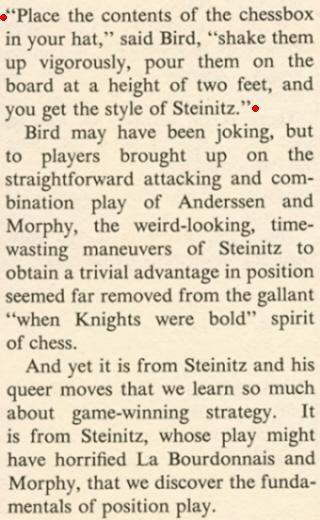
We do not recall the remark in Bird’s books, but the following appeared on page 177 of the Chess Amateur, March 1913, in an article about Steinitz by R.J. Buckley:
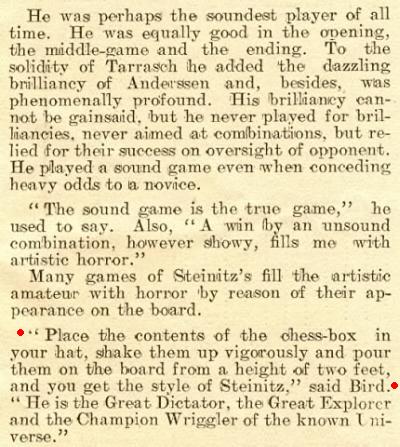
The article was reproduced on pages 132-135 of the June 1913 American Chess Bulletin.
However, in the April 1982 Newsflash (see C.N. 4554) G.H. Diggle wrote regarding W.N. Potter:
‘But his eccentric opening play fascinated Steinitz, on whose own style (Dr Lasker tells us) Potter had a great influence. “Put all the pieces into a hat”, said Steinitz, “and shake them out on to the board, and you have Potter’s style exactly.”’
This discrepancy was mentioned on page 44 of William Steinitz, Chess Champion by Kurt Landsberger (Jefferson, 1993). Can it be explained?
(6554)
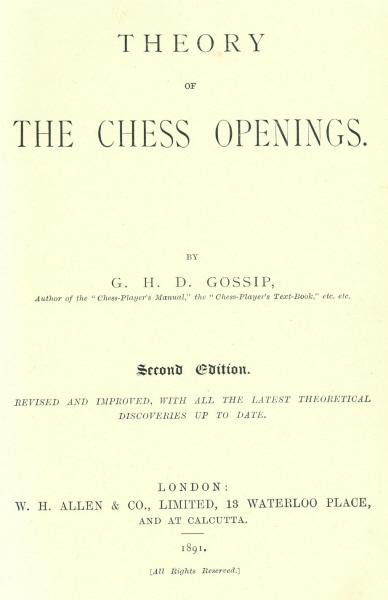
From page 143 of the May 1891 International Chess Magazine:
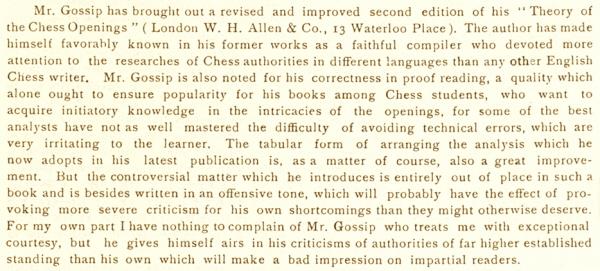
(6602)
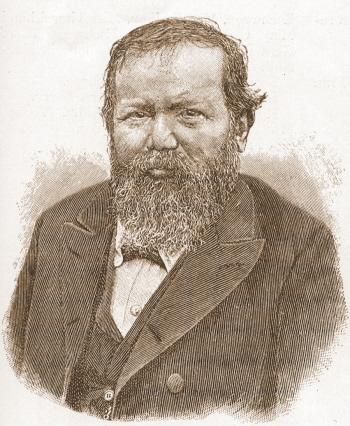
W. Steinitz
Graeme Cree (Austin, TX, USA) asks about various aspects of the world championship rules for matches involving Steinitz.
There are complications aplenty, but in an attempt to set out the basic facts we have put together a feature article World Chess Championship Rules.
(6647)
On pages 366-367 of the December 1886 International Chess Magazine Steinitz wrote about a question which he had been asked ...
‘... many years ago in London by an habitué of a public chess resort, who in polite terms requested me to show him the best moves of the Two Knights Defense. “There has been”, I answered, “a whole book written by Bilguer on that opening in German. Which particular variation do you refer to?” He did not know how to describe it. “Well”, I said, “perhaps you will recognize it if I show you one or two of the main lines of play.” “Thank you very much.” Whereupon I rattled off the well-known variation in which the knight is sacrificed for the KBP, on the sixth move. My interlocutor looked on attentively for some time, but at last he said: “That is not the Two Knights Defense I meant. What I want to know is this: Mr Blackburne always gives me the odds of two knights, and I never know how to defend myself.”’
The story was also related on pages 8-9 of The Bright Side of Chess by Irving Chernev (Philadelphia, 1948).
(6779)
Jason Childress (Cambridge, MA, USA) asks about the 11th match-game between Zukertort and Steinitz, 1886 and, in particular, whether no ‘threefold repetition rule’ was in effect.
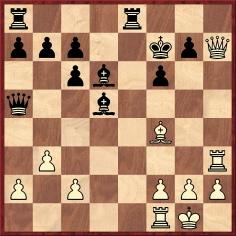
This position arose after Black’s 20th move, and play continued 21 Qh5+ Kf8 22 Qh8+ Kf7 23 Qh5+ Kf8 24 Qh8+ Kf7 25 Qh5+ Kf8 26 Qh8+ Kf7 27 Qh5+ Kf8 28 Qh8+ Kf7 29 Qh5+ Kf8 30 Qh8+ Kf7 31 Qh5+. Only now did Steinitz deviate, with 31...Ke7. White resigned in under a dozen moves.
The match rules appeared on pages 136-137 of the January 1886 Chess Monthly, and point 13 stated:
‘The games of the match shall be governed by the code of laws published in the last edition of the German Handbuch, with this exception, that, if both players repeat the same series of moves six times in succession, then either party may claim a draw.’
For the full text see World Chess Championship Rules.
On page 205 of the March 1886 Chess Monthly (co-edited by Hoffer and Zukertort) this note was appended to 21...Kf8:
‘Five full repetitions: gaining 10(!) moves. Keeping the letter but not the spirit of the law.’
Steinitz’s International Chess Magazine (May 1886, pages 121-122) gave this explanation:
‘[Zukertort] initiated a series of checks with the object of drawing by perpetual check. A repetition of moves was then resorted to by both parties, with different objects, although neither of them was absolutely confined to the tactics which he adopted. The same series of two moves were, however, made on each side by a sort of tacit agreement; for Zukertort, according to the rules, was entitled after six repetitions to claim a draw, which was all he could play for with a piece behind, while Steinitz, though he had some time to spare, wished to get over the 30th move in order that he should not be harassed by the time-limit in his deliberations for the purpose of working out a combination whereby he could secure winning the game without any danger. It was an extremely difficult task, as will be seen from the game and the appended analysis. But in reply to Zukertort’s sixth repetition of checks, Steinitz altered his course in a manner which, in a few moves, enabled him to slip out of all danger with his king, and to remain with a piece ahead.’
(6859)
Repetition of Position or Moves in Chess also mentions that the rules for the 1886 Steinitz v Zukertort match specified:
‘The games of the match shall be governed by the code of laws published in the last edition of the German Handbuch, with this exception, that, if both players repeat the same series of moves six times in succession, then either party may claim a draw.’
Source: Chess Monthly, January 1886, page 137.
Jonathan Hinton (East Horsley, England) notes the provision became relevant in the sixth match-game, as discussed, for instance, by L. Pachman on pages 18-19 of Pachman’s Decisive Games (London, 1975).
See, furthermore, the references to Steinitz in Chess: the 50-move Rule.
Under the heading ‘Incorrigible’ the following item appeared in C.N. 3216 (see also page 249 of Chess Facts and Fables):
‘Wilhelm Steinitz did not become World Champion until he was over 58 years old, on May 26, 1894.’
That is what Eric Schiller persistently claims. We drew attention to it in C.N. 2241 (i.e. on page 89 of the 1/1999 New in Chess). Far from correcting his spectacular gaffe, Schiller subsequently posted it at a second website, as we noted in C.N. 2302 – see page 98 of the 5/1999 New in Chess. Yet even then Schiller refused to make a correction, so in C.N. 2468 (page 105 of the 1/2001 New in Chess) we mentioned the matter a third time.
What, then, is the situation today, all these years later? It will surprise no-one to learn that Schiller’s website still affirms:
‘Wilhelm Steinitz did not become World Champion until he was over 58 years old, on May 26, 1894.’
See too C.N. 6890.
Christian Sánchez mentions this report in the New York Times of 22 February 1897:
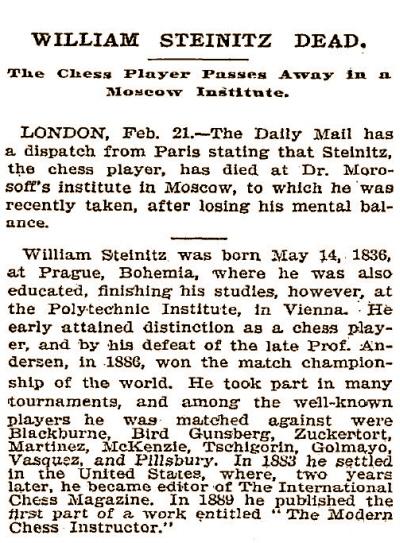
We recall that Tarrasch mentioned the premature news reports about Steinitz in the essay ‘Der Fall Pillsbury’ in his book Die Moderne Schachpartie (page numbers vary according to the edition):
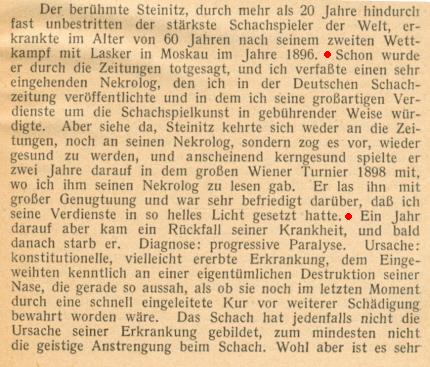
In fact, there was no ‘obituary’ of Steinitz in the Deutsche Schachzeitung of 1897, a magazine then edited by Tarrasch. See, however, the extensive selection of Steinitz’s best games on pages 70-85 of the March 1897 issue. The feature began with a note stating that reports of the former world champion’s death were untrue.
(6901)
C.N. 9830 showed material written by Gunsberg in the Pall Mall Gazette in 1897 concerning Steinitz’s supposed death.
See also Chess and Untimely Death Notices.
‘... Miss Foot has challenged Mr Steinitz to a game by correspondence, and the contest is now proceeding.’
Drawing attention to this report on page 7 of the South Australian Register, 11 October 1893, Graham Clayton (South Windsor, NSW, Australia) asks whether the game-score has survived.
We do not recall seeing it, although Eliza Campbell Foot’s obituary on pages 253-254 of the December 1914 American Chess Bulletin stated:
‘Miss Foot took special pride in referring to a victory she achieved in years gone by over William Steinitz. The score was printed at the time.’
See also Kurt Landsberger’s books William Steinitz, Chess Champion (Jefferson, 1993) and The Steinitz Papers (Jefferson, 2002). On, respectively, pages 277 and 159 Landsberger quoted a letter dated 4 November 1896 from F.J. Lee to Frideswilde Rowland which was given in the Spring 1911 issue of Four Leaved Shamrock with the following addition by Mrs Rowland:
‘During the seclusion at Upper Montclair, Steinitz was playing a correspondence game with his cousin, Miss Eliza Foot, President of the Women’s Chess Association, New York. She sent me a copy of her game with Steinitz wherein he resigned, but Dr Pollock told me afterwards that Steinitz played the game without looking at the board.’
On page 286 of The Steinitz Papers Landsberger wrote concerning Miss Foot:
‘She was not related to Steinitz, but was a good friend.’
This photograph was published on page 102 of the June 1906 American Chess Bulletin:
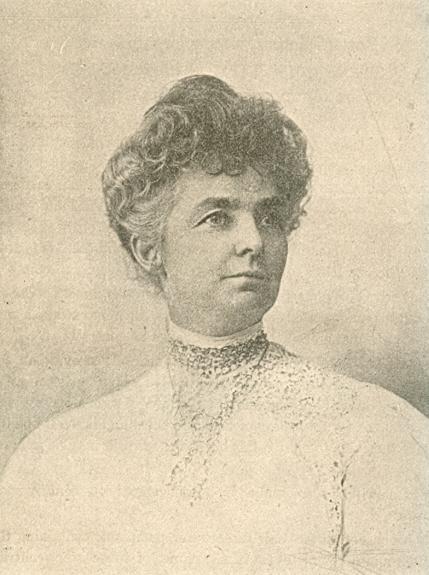
Her above-mentioned obituary reported that she died near the Manhattan Chess Club on 6 December 1914:
‘It was a very stormy evening and, carrying an umbrella, Miss Foot evidently was at a great disadvantage with respect to any vehicles that might be passing. One suddenly bore around the corner at high speed, killing her outright. The fact that the driver of the machine made his escape placed the tragedy on the same plane as a wanton, cold-blooded murder.’
(7158)
John Blackstone (Las Vegas, NV, USA) has found the Foot v Steinitz game on page 9 of the Brooklyn Daily Eagle, 14 November 1909:
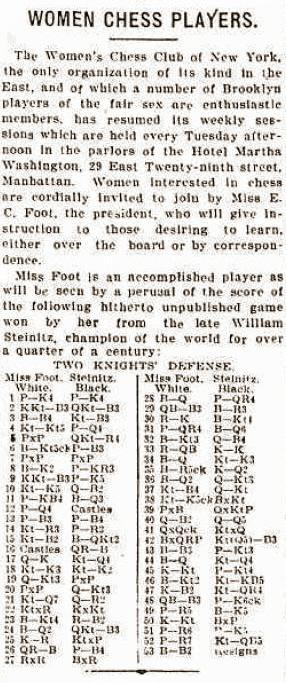
1 e4 e5 2 Nf3 Nc6 3 Bc4 Nf6 4 Ng5 d5 5 exd5 Na5 6 Bb5+ c6 7 dxc6 bxc6 8 Be2 h6 9 Nf3 e4 10 Ne5 Qc7 11 f4 Bd6 12 d4 O-O 13 c3 c5 14 Na3 a6 15 Nc2 Bb7 16 O-O Rac8 17 Qe1 Nd5 18 Ne3 Ne7 19 Qg3 cxd4 20 cxd4 Qb6 21 Nd7 Qa7 22 Nxf8 Kxf8 23 Bg4 Rc7 24 Bd2 Nac6 25 Kh1 Nxd4 26 Rac1 f5 27 Rxc7 Bxc7 28 Bd1 a5 29 Bc3 Ba6 30 Re1 Bb5 31 a4 Bd3
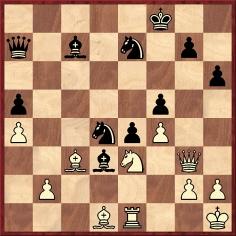
32 Bb3 Qc5 33 Rc1 Ke8 34 Bd1 Ne6 35 Bh5+ Kd7 36 Bd2 Qb6 37 Nc4 Qb8 38 Ne5+ Bxe5 39 fxe5 Qxb2 40 Qf2 Qd4 41 Qxd4+ Nxd4 42 Bxa5 Ndc6 43 Bc3 g6 44 Bd1 Nd5 45 Kg1 g5 46 Bb2 Nf4 47 Kf2 Na5 48 Bc3 Nc4 (The move order given by the newspaper for the remainder of the game was garbled.) 49 a5 e3+ 50 Kg1 Be4 51 a6 Bxg2 52 a7 Be4 53 Bc2 Resigns.
(7163)
Further information about Eliza Campbell Foot is provided in an article (with a group photograph) by Harriet A. Ver Planck on pages 65-67 of the American Chess Bulletin, May-June 1949. Her surname was spelled ‘Foote’ throughout, a variant also found in some other sources.
(7562)
Below is the photograph mentioned in C.N. 7562, from page 66 of the May-June 1949 American Chess Bulletin:
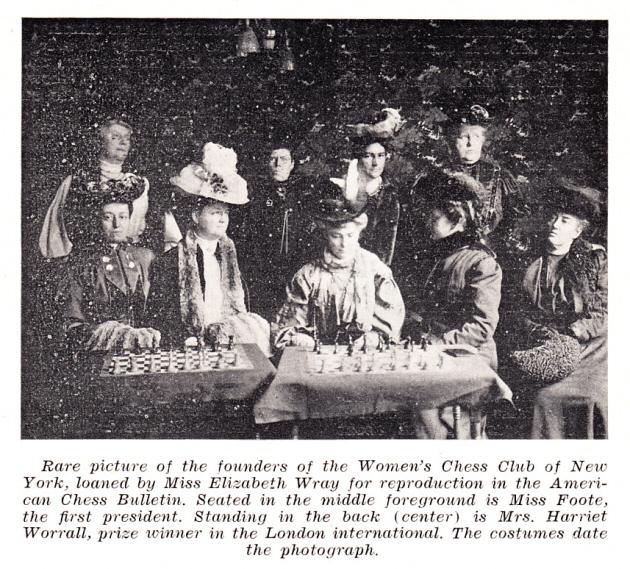
(7592)
Wanted: information about a quote ascribed to Fischer on page 57 of Bobby Fischer heute by Yves Kraushaar (Schwanden, 1977) and given in C.N. 932:
‘Es gibt nur zwei wahre Schachgenies – das andere war Wilhelm Steinitz, der Weltmeister von 1872 bis 1894.’
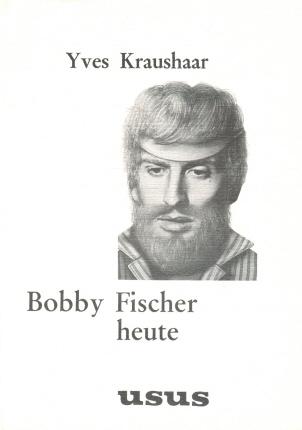
(7186)
Is information available on Steinitz’s children William and Julia (or Juliett), both of whom were born in the 1890s? A lead is provided by the 1910 US census (see the FamilySearch.org website), which lists them as the stepchildren of Peter Baust, the address being Queens Ward 2, Queens, New York:

(7189)
Russell Miller (Vancouver, WA, USA) notes that William Steinitz (‘Hardware Own Business’) and Juliet Steinitz (‘Stenographer for Bank’) were also listed in the 1920 US Federal Census. They were living with Peter and Elizabeth Baust at Queens Assembly District 6, Queens, New York.
(7199)
From page xxxi of The Modern Chess Instructor by W. Steinitz (New York, 1889):
‘In fact it is now conceded by all experts that by proper play on both sides the legitimate issue of a game ought to be a draw, and that the right of making the first move might secure that issue, but is not worth the value of a pawn.’
(7306
See Chess Draws.
From page 45 of All About Chess by I.A. Horowitz (New York, 1971):
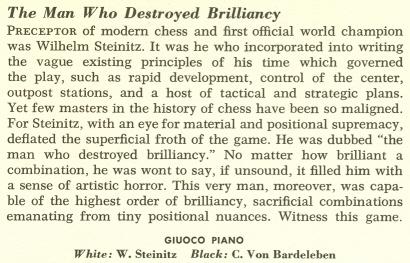
What evidence is there that Steinitz was dubbed ‘the man who destroyed brilliancy’?
The subsequent remark above is more familiar. For example, the following is on the dust-jacket of Chess Traps, Pitfalls, and Swindles by I.A. Horowitz and F. Reinfeld (New York, 1954):
‘The great Steinitz once wrote: “A win by an unsound combination, however showy, fills me with artistic horror.”’
We do not recall seeing that ‘once’ observation in Steinitz’s writings, but this comes from the article ‘Wilhelm Steinitz, Genius’ by Robert J. Buckley on pages 176-177 of the March 1913 Chess Amateur:
‘“The sound game is the true game”, he used to say. Also, “A win by an unsound combination, however showy, fills me with artistic horror”.’
Buckley’s article began with the statement ‘Wilhelm Steinitz, whom I knew intimately for 20 years ...’ The full text has been added to Who Was R.J. Buckley?
(7308)
After criticizing Steinitz’s prose style, G.A. MacDonnell deployed on page 39 of The Knights and Kings of Chess (London, 1894) a word which we have not seen elsewhere:
‘He is a terrible poluphloisboioist.’
(7328)
This article by G.H. Diggle was originally published in the March 1986 Newsflash and appeared on page 37 of volume two of Chess Characters (Geneva, 1987):
‘One hundred years ago a famous World Championship Match of ten games up excluding draws was played in three sections at New York, St Louis and New Orleans. No American nationalist pride was involved as Steinitz was an Austrian Jew and Zukertort’s antecedents were “shrouded in mystery”. Yet the contest convulsed the American public, partly because it brought back the memory of their own World Champion, whose death only 18 months earlier after years of obscurity had suddenly blazoned forth his name once more in countless nostalgic Obituaries. Thus when the match began at the Manhattan Chess Club, “the same chessboard was employed upon which Morphy fought his famous battles a quarter of a century ago”, with “the veteran Mr Patterson, who called off the moves for Morphy [at New York, 1857] again acting as teller upon the present occasion”. There was a great gathering of “eminent divines, members of the legal profession, and men of letters”, who well remembered Morphy’s brilliant début, and there were many hearty handshakes between players who had not met since then, but were again attracted by the fame of the present masters. [BCM, February 1886, page 54.] In fact, throughout the contest, Morphy’s shade seemed to hover in the background, and in the final section of the match, at New Orleans, Zukertort expressly selected for his second Morphy’s lifelong friend and opponent C.A. Maurian.
The contrast between the two masters is well portrayed by a Reporter in The Republican: “[Steinitz is] a fat phlegmatic little man, with a fine forehead and mussed hair and clothes. His legs are very short, although his circumference around the equator is rather large, and it was a peculiar sight to watch the great chessplayer seated upon an ordinary chair and feeling unsuccessfully for the continent of North America with his feet. Both men are hirsute, but Zukertort is better groomed than Steinitz. Both have fine heads. Steinitz is all curves, Zukertort all angles. ... Steinitz is all solidity and adipose tissue, Zukertort all brilliancy and nerves.” [See pages 161-162 of the February 1886 Chess Monthly.]
The course of the match is well known – Zukertort’s brilliant start at New York (+4 –1 =0), Steinitz’s recovery at St Louis, levelling the score to +4 -4 =1, and then forging ahead at New Orleans to +7 –5 =4. Then came the crucial 17th game, which in its general course bears a striking resemblance to Anderssen’s sixth game against Morphy. Like Anderssen, Zukertort was two games behind. In both cases, they made a supreme effort to reduce the lead, and obtained a clear win, only to fritter it away tragically in the final stages. Zukertort did indeed draw whereas Anderssen lost, but (says P.W. Sergeant in Championship Chess) the game “contributed not a little to his breakdown; or perhaps it should be said that his play in it was symptomatic of the coming breakdown”. For the last three games of the match the exhausted master lost off the reel without a struggle – a strange repetition of his three losses at the end of his great London Tournament of 1883, though there he was so far ahead of the whole field that it did not matter.
It was afterwards suggested that had the whole match been played at New York Zukertort might have won. But Dr Lasker in his Manual had no doubt as to which was the greater player. Zukertort “simply puts his pieces on squares where they enjoy mobility and hopes for complications in which to exercise his talent for combination”. Steinitz “follows a plan”.’
(7613)
From page 320 of the October 1866 Chess Player’s Magazine:
‘Not having been furnished till recently with the names of the seconds and umpire in the late match between Anderssen and Steinitz, we were unable to state that Messrs Staunton and Hewitt acted as seconds for the former, and Messrs Strode and Boden for the latter. Earl Dartry [sic – Dartrey] was the umpire.’
(7637)
See Chess Seconds.
A question from Olimpiu G. Urcan is thrown open to readers:
‘Is it possible to establish, with reliable historical sources, the first known occasion when Steinitz played 1 d4?’
(7639)
Roland Kensdale (Aberdeen, Scotland) notes the move in Steinitz’s tenth match-game against Zukertort (London, 31 August 1872). The opening 1 d4 f5 2 g3 recurred in the twelfth game. (Westminster Papers, 1 October 1872, page 85.)
Our correspondent also points out Steinitz v Jeney, Vienna, 4 September 1860, which opened 1 c4 e6 2 Nc3 d5 3 e3 Nf6 4 Nf3 Nc6 5 d4. See, for instance, page 383 of volume one of Schachmeister Steinitz by L. Bachmann (Ansbach, 1925).
Finally, Mr Kensdale remarks, a game between Steinitz and Healey (London, 1864), played at king’s knight’s odds, began 1 d4 d5 2 c4 c6. It is on page 88 of the Bachmann book.
(7653)
Below are two photographs which appeared, courtesy of David Lawson, on pages 31 and 82 respectively of the Weltgeschichte des Schachs volume on Steinitz by D. Hooper (Hamburg, 1968):

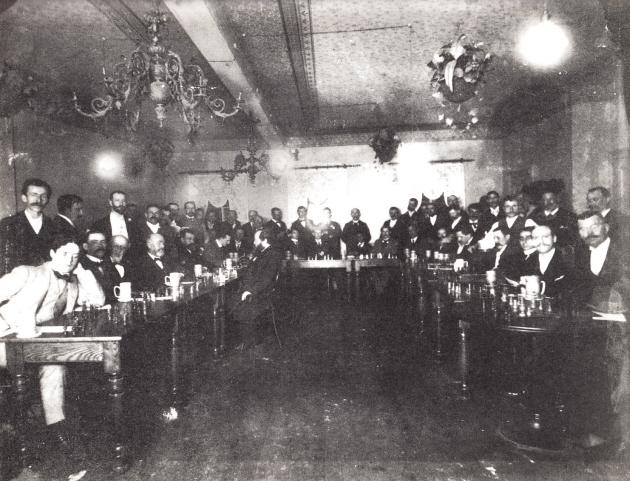
‘Steinitz beim Simultan-Spiel mit 18 Teilnehmern (Hamburg, 1896?)’
(7654)
From page 213 of the Westminster Papers, 1 March 1876:
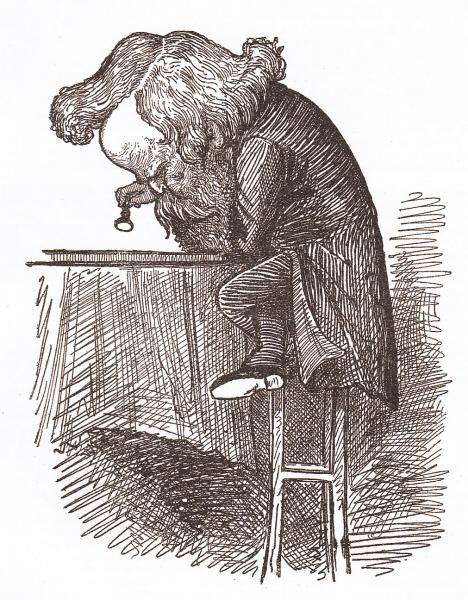
The caricature was mentioned by ‘A Looker-on’ in the 15 March 1876 issue of the Chess Player’s Chronicle, page 53:
‘Have you seen the charming portrait of “Herr Wilhelm Steinitz”, and accompanying letterpress, which appear in the Westminster Papers for the current month? The likeness, though somewhat flattering, is, in my humble opinion, admirable, and has given rise to an incredible amount of fun among chessplayers hereabouts, though I hear that the original somewhat objects to it. On dit, though, of course, I do not vouch for the fact, two actions for libel – or, I suppose, two threats of actions – have been brought against the Papers during the past week. But threatened people, they say, live long.’
(7695)
John Blackstone draws attention to Pillsbury’s account of Hastings, 1895 in an interview on page 6 of the New York Times, 29 September 1895:
‘The competing masters received me very kindly at Hastings ... especially Chigorin, Tarrasch and Steinitz, and their attitude toward me did not change at all after I had won the championship. When I had beaten Gunsberg in the final round I was applauded, and Tarrasch, Chigorin and Steinitz left their tables and congratulated me on my victory. I appreciated the honor greatly.
...
Lasker has greater analytical knowledge, but his body is too feeble to stand the strain of a long tournament. If advancing years have impaired Steinitz’s powers of crossboard play he is still as keen an analyst as ever. My game with him was the hardest I had to play in the tournament, but Tarrasch gave me a good deal of trouble. So did Tinsley.
I feel Chigorin to be the strongest player alive, so far as match playing is concerned. I should not feel at all troubled if I had to meet either Steinitz, Lasker or Tarrasch in a set match. I fancy my chess is as good as theirs, and if I should not beat either of them I feel pretty certain of not being disgraced. Neither would I fear Chigorin, as I have a good deal of confidence in myself.
...
Steinitz still wants to play Lasker. He considers himself champion de jure and Lasker champion de facto, but I have left it to the Hastings Chess Club to decide who is champion, and I shall not hesitate to play him whoever he may be. The Hastings Club has already offered a purse for such a match. I shall not challenge the winner of the Lipschütz-Showalter match to be played here. I shall not claim any title, but shall simply stick to business. Then if I can get any I shall go to St Petersburg in November to play in the quintangular tournament ...’
(7760)
The above passages related to Steinitz. For the full text, see our main feature article on Pillsbury.
Relatively early occurrences of the term ‘grandmaster’ continue to be welcomed. The following, submitted by John Blackstone, was written by Gunsberg on page 6 of The World, 16 January 1891:
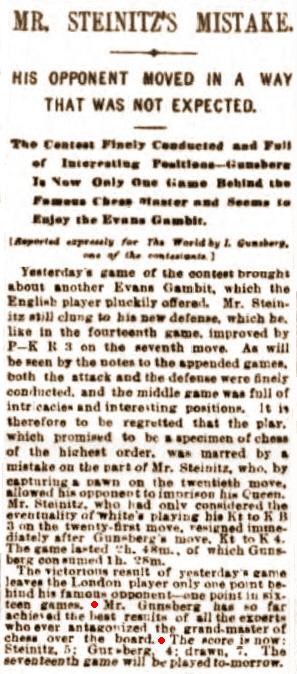
(7779)
Alexander Rietema (Fort Lee, NJ, USA) has forwarded some photographs, which he took in late September/early October 2006, of the graves of Steinitz (Brooklyn, NY) and Lasker (Queens, NY):
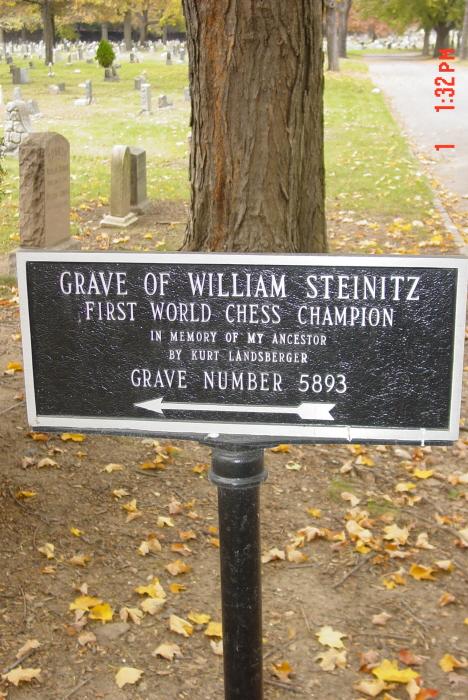
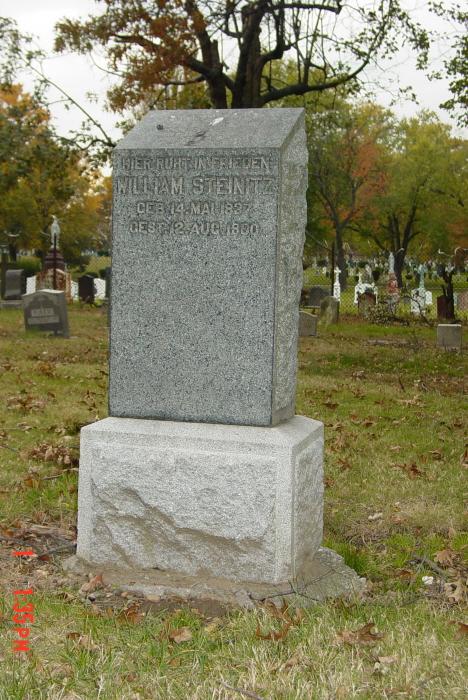
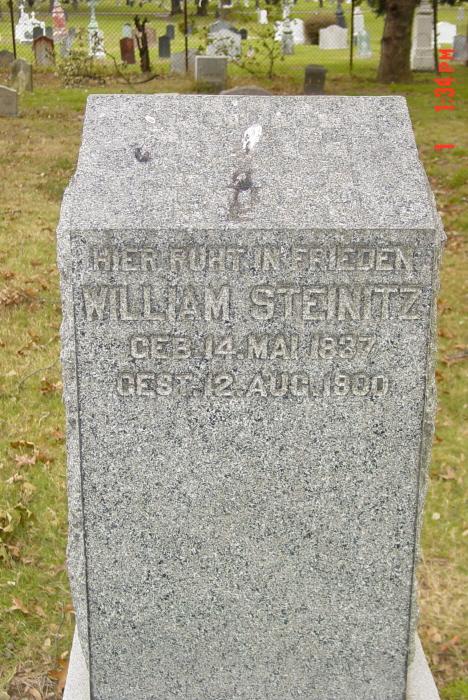
It will be noted that the year of birth is incorrect.
(7794)
Page 22 of the booklet Schach WM 2008 Deutschland has a photograph of Zukertort and Steinitz which was new to us, and we are grateful to Michael Negele for the opportunity to present it here:
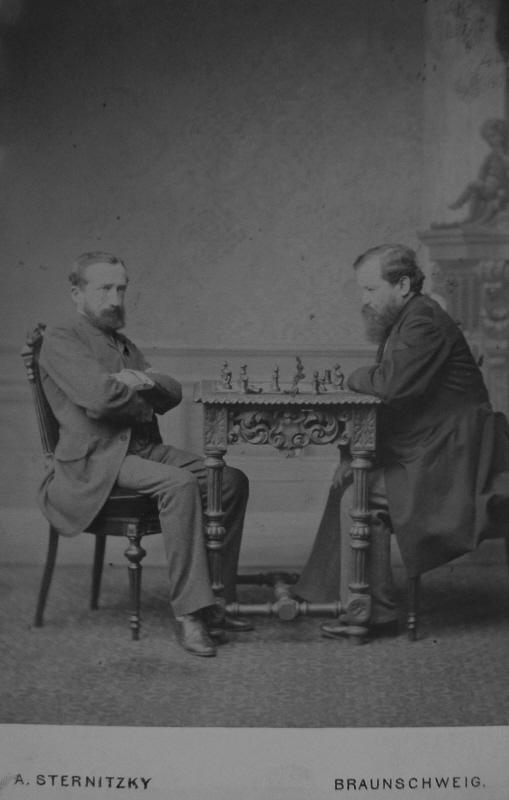
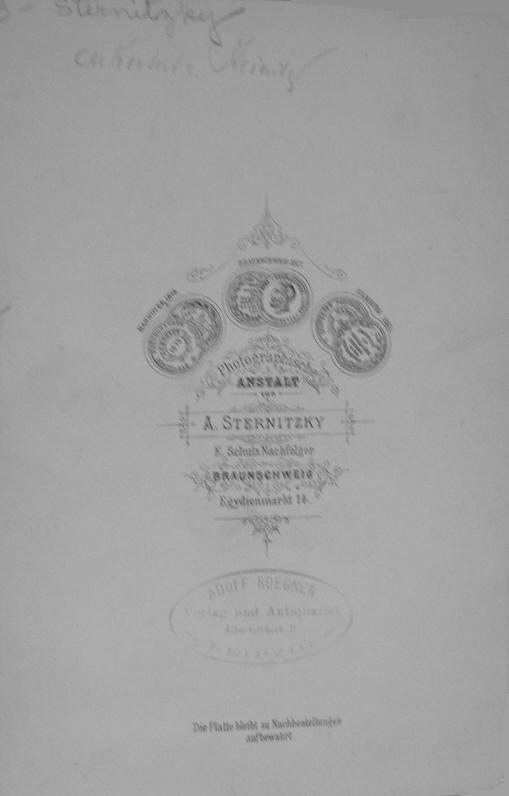
Mr Negele found the photograph in the archives of the Cleveland Public Library in 2007. Although the booklet states that it was taken in 1886, our correspondent suggests that the occasion was Brunswick, 1880, a tournament which, as stated on page 235 of the August 1880 Deutsche Schachzeitung, both Zukertort and Steinitz visited.
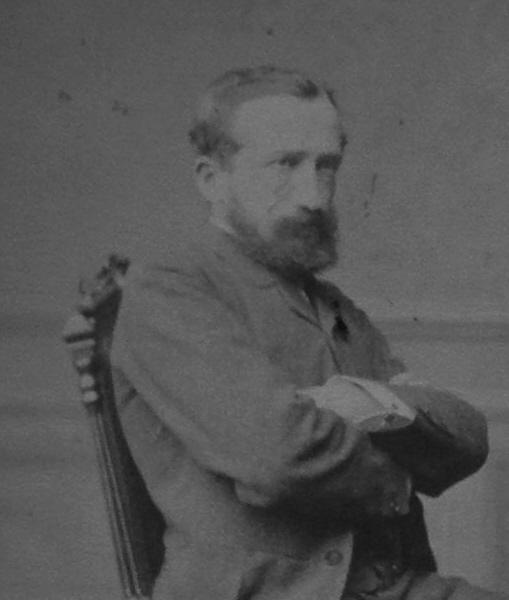
J.H. Zukertort
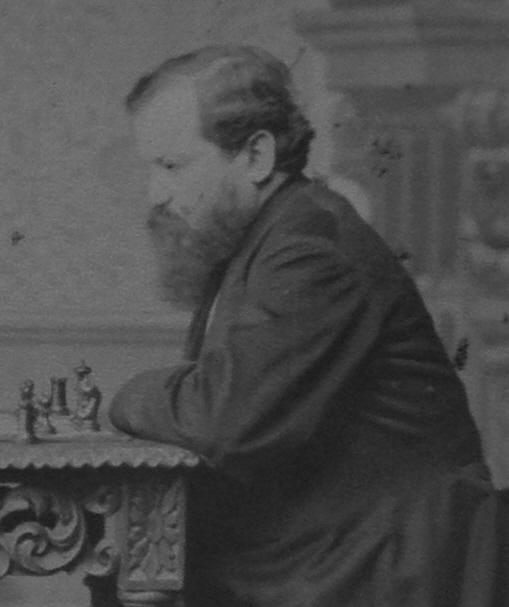
W. Steinitz
(7795)
John Townsend (Wokingham, England) notes a catalogue entry for a photograph of Steinitz held by the Royal Northern College of Music in Manchester (reference: AB/235):
‘The date of this photograph was that on which the sixth game of the Lasker match was played at the Union Square Hotel, New York, after which the match moved to Philadelphia. The back of the photo is signed as follows: “Union Square Hotel, March 30th 1894 Yours very truly W Steinitz To Professor A. Brodsky”.’
Having been shown the photograph by the College, we can add that it is the frontispiece to The Steinitz Papers by K. Landsberger (Jefferson, 2002), which reproduced it courtesy of the College. Further details are provided on the book’s imprint page (which gives the date as 20, and not 30, March 1894).
We are grateful to the College for permission to show here Steinitz’s inscription:
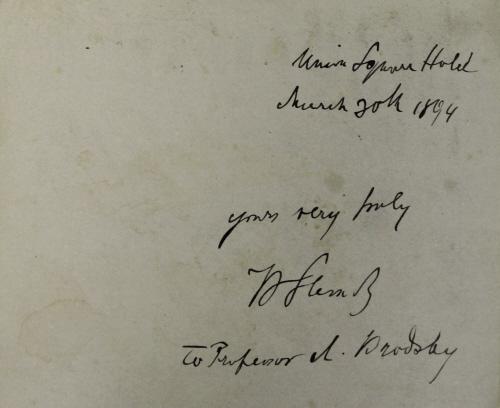
(7820)
John Blackstone notes a news report on page 6 of the New York Sun, 20 November 1890 and, in particular, the final paragraph:
‘We imagine that the popular estimate of chess will be revolutionized by these games. As their slow changes are watched by a continually increasing attention on the part of the public, the idea must grow that chess under the ordinary rules is too fast, and that a truly perfect contest must spread over weeks or even months, perhaps years.’
As regards the popularity of the two games, we add that Steinitz wrote on page 4 of the New York Tribune, 1 May 1891:
‘Never before in the history of our pastime has a chess contest created such widespread and literally universal interest during its progress as the one just concluded between myself and Mr Chigorin.’
The full article was reprinted on pages 107-111 of the April 1891 International Chess Magazine.
(7851)
David Nudelman (Hamden, CT, USA) is seeking information on a publication by Steinitz towards the end of his life about anti-Semitism in Vienna and elsewhere. In various Russian sources the title is given as ‘Мой ответ антисемитам в Вене и где бы то ни было’.
Pages 231-232 of The Steinitz Papers by Kurt Landsberger (Jefferson, 2002) gave an English translation of an article published in the ‘Berliner Anzeigung’ (sic – Anzeiger) of 20 March 1897 which quoted Steinitz as follows:
‘After every match I am always very excited and do not feel well, but it has never been as bad as in Moscow. I am, however, my own doctor; as a passionate Kneippianer I cure myself with cold water, which has always helped me. This time it took longer and I could not hold my thoughts together, which saddened me since I wanted to write my book “Judaism in Chess” as quickly as possible to combat anti-Semitism.’
The newspaper article added:
‘Steinitz had engaged a young Russian with language abilities as secretary since he wanted to dictate it simultaneously for German and English publication.’
The paragraph below comes from page 167 of the May 1897 BCM:
‘Mr Steinitz has been playing off-hand games at Vienna with Herr Schlechter, with about an even result. He is said to be now writing a book entitled “Das Judenthum im Schach” (“The Jewish Element in Chess”).’
A work of that title had been mentioned on page 122 of the April 1897 Deutsche Schachzeitung.
(7952)
David Nudelman submits this title page:
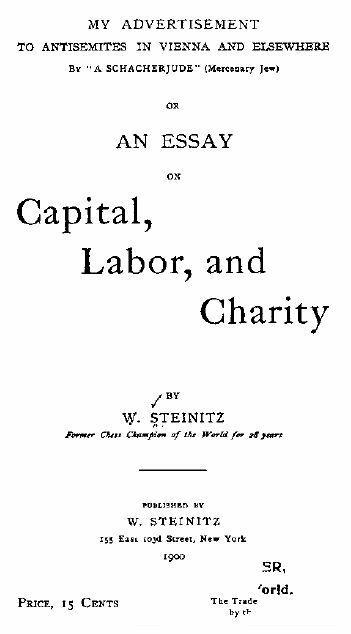
See too pages 382-386 of William Steinitz, Chess Champion by Kurt Landsberger (Jefferson, 1993).
(7969)
An item that we wrote on pages 23-24 of Kingpin, Spring 1992 (see too page 197 of Kings, Commoners and Knaves):
Who was the first to claim the title of world chess champion? Those who thought that it might have been Steinitz will be put right by page 23 of The Great Jewish Chess Champions by Harold U. Ribalow and Meir Z. Ribalow (New York, 1986):
‘Albert Alexandre, a Frenchman who claimed the world title in 1776, was a Jew.’
The co-authors may have meant Aaron Alexandre, even though he was only about ten at the time. Appropriately, the book’s dust-jacket mentions that ‘the Harold U. Ribalow Award is presented annually by Hadassah magazine for an outstanding English-language work of Jewish fiction’.
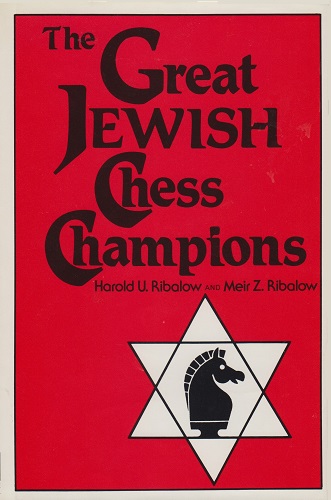
Another example of the book’s shoddiness is this ‘once’ dialogue on page 28:
‘Steinitz, a German Jew, was also baited by one of his rivals, the fine player Johannes von [sic] Zukertort who, unfortunately, was anti-Semitic. A feud developed between the two and Zukertort once said to Steinitz, “You are not a chessplayer, but a Jew”. The great champion’s cutting reply was, “You, apparently, are neither”.’
(10038)
From D.J. Morgan’s Quotes and Queries column on page 23 of the January 1961 BCM:
‘R.D. Blackmore on Chess. We found this in the novelist’s biography by W.H. Dunn (page 174): “The only game worth playing!”, he once said to James Baker. “Think of the genius who invented the knight’s move.” He came to know Steinitz and H.F.L. Meyer.’
(7976)
Regarding R.D. Blackmore, see too C.N. 7992.
From pages 54-55 of My Seven Chess Prodigies by John W. Collins (New York, 1974):
‘In Bobby Fischer’s Chess Games, by Wade and O’Connell, contributing editor Sir [sic – see C.N. 5674] Harry Golombek remarks on the influence of Capablanca on Bobby’s style and sees a strong resemblance in the respective strategies that run through their games. He recalls that Bobby acknowledged the influence in an interview with Leonard Barden that was broadcast on the BBC, and that Bobby also said he had read and appreciated a book on Capablanca by Golombek. The influence and resemblance are evident, and I have always been aware of it, recent evidence of it being in his third and fifth games with Spassky in Iceland. But I must say that I do not recall Bobby ever dwelling on his admiration of Capablanca or playing over great numbers of Capa’s games, though I assume he played over all of them at some time.
With Anderssen and Steinitz the story is much different. I remember I once lent a brand-new copy of Adolf Anderssen, by Dr Hermann von Gottschall, to him. Some weeks or months later he returned it, and I had good reason to believe he had worked over every game and note in it – all 751 games in the main section, plus 80 problems by Anderssen in another section. And later on Bobby and I played over 36 games that Anderssen played during 1851 to 1859 in Breslau with Louis Eichborn, a banker and good friend of chess. Much to our great glee we found that Anderssen lost them all. Steinitz received even more attention. Bobby was always intrigued by the man and his games, and he has revived many of his discarded variations, one is the Two Knights’ Defense, for instance. And another is the Petroff Defense. As with the Anderssen book, he borrowed my four volumes of Chess Master Steinitz [Schachmeister Steinitz], by Ludwig Bachmann, and thoroughly chewed and digested every one of the 669 games in them. Later, on many an afternoon and evening in my apartment, he and I would go over a score or so of these same Steinitzian struggles again. Bound copies of Steinitz’s The International Chess Magazine also provided us with grand old games and insights into the frightening intellect and acid pen of the “Father of Modern Chess”.’
(7987)
Steinitz writing on page 267 of the September 1887 International Chess Magazine:
‘To my mind it is clear from long experience that the greatest evil that has to be contended with in tournaments is the scoring of the draws absolutely, and the system of the London tournament of 1883 is by far the best compromise that can be effected in order to make tournaments a real test of superiority.’
(8007)
From page 297 of the October 1887 International Chess Magazine:
‘One of the drawbacks of tournament play is that a defeated competitor has not alone to bear the disappointment and chagrin over his losses, but he is also liable to be reproached by his rivals for failures which may have affected their own individual interests in the race.’
(8021)
A remark by Steinitz on page 303 of the October 1888 International Chess Magazine:
‘... a few weeks’ practice with masters is worth years of study.’
(8031)
Thomas Höpfl (Halle, Germany) notes a report on page 3 of the 31 August 1866 edition of Die Debatte und Wiener Lloyd (left-hand column):
‘The Club took offence at Steinitz’s not very agreeable appearance and, not finding him suitable to represent the Wiener Schachklub, refrained from sending anyone to the London Chess Congress.’
The newspaper added that Steinitz went to London under his own steam.
(8072)
Part of an article by G.H. Diggle in the May 1985 Newsflash and reprinted on page 21 of volume two of Chess Characters (Geneva, 1987):
‘When Steinitz beat Blackburne in 1876 (7-0-0) the crestfallen anti-Steinitz Westminster Papers summed up as follows (it should first be explained that the arrangement was for each game to be adjourned after four hours, play to be resumed “after dinner”, and further that the rooms of the West End Club were commandeered for the match against the wishes of some of the members):
“... The professional chessplayers’ mountain has brought forth its mouse. The match, which one of the players has described as ‘momentous’, will certainly be memorable, if only ... from the thoroughly mercenary manner in which the affair has been conducted throughout. At the West End Chess Club, where the players meet, an admission fee is levied upon any innocent that may be caught abroad for the purpose of witnessing a chess farce, and ... an organized Club is converted into a “Bohemian” free-and-easy, with no higher motive, that we can see, than to put a few half guineas into somebody’s pocket. A chess match conducted in such a manner could not possibly evoke much interest outside of the little knot of do-nothings, ... and the character of the play has only increased the indifference with which it is regarded by the London chessplayers. Up to the present time, six games have been played, and all have been scored by the Bohemian. ... After four hours’ play, the players will leave the roped arena, in which they sit, ‘caged as our rarer monsters are’, adjourning for dinner. Then will the long hushed voices of the gallery break forth into Babylonian noises, and after wild discussion, and still wilder analysis, the verdict will be ‘an even game’. ... Anon the players will resume play, and from that time forth, slowly, but surely, the Englishman’s pawns will disappear from the board, and soon the Bohemian Caesar will add another spangle to his tinsel crown. This, in little, is the story of the ‘momentous’ chess match. In every game, except the first, the English player has outplayed his adversary for four hours, but that tocsin of the soul, the dinner bell, seems to have exercised a very curious effect upon his ‘space imagination’, and if he were not a blindfold player, we should be inclined to remind him of Carrera’s observation that ‘fulness is contrary to speculation and obfuscates the sight’.”’ [Westminster Papers, 1 March 1876, page 215.]
(8075)
Frank J. Marshall on Steinitz, from page 398 of Kings, Commoners and Knaves:
‘He was a very great player. He was wonderful, but too deep for any mortal power. He had to fail in the execution of such difficult plans as he followed. That is why he finally was defeated by the younger masters.’
Source: Lasker’s Chess Magazine, July 1906, page 126.
From the same page of our book:
On page 182 of the August-September 1906 issue of Lasker’s Chess Magazine, Emanuel Lasker wrote regarding his first match against Steinitz:
‘When Steinitz entered this contest he felt sure of victory. But when fate went against him and he found himself, for the first time in his life, beaten, he behaved with the utmost chivalry. His way of resigning the last game of the match was to call for cheers for the new champion of the world.’
From World Chess Championship Rules:
Steinitz v Lasker (New York, Philadelphia and Montreal, 15 March-26 May 1894):
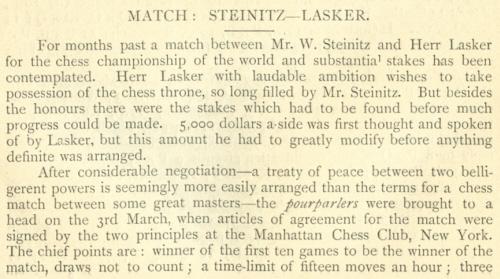

Source: BCM, April 1894, pages 162-163. A signed original (ten pages) of the above-mentioned agreement is owned by David DeLucia, who reproduced the first two pages in the books discussed in C.N.s 3164 and 5323.
Lasker v Steinitz (Moscow, 7 November 1896-14 January 1897):
Page 425 of the November 1896 BCM stated that the return match between Lasker and Steinitz would take place ‘under the same conditions as those of the first match, with the exception of the stake’. On page 468 of the December 1896 issue a summary of the match rules was provided: ‘it will be decided by ten won games, draws not being counted. The time-limit is 15 moves an hour. A purse of £200 will be presented by the Moscow Club to the winner, and £100 to the loser.’
Hans Renette sends an interview with Steinitz by Wolf Heinemann which was published on page 48 of the Otago Witness, 5 October 1899:

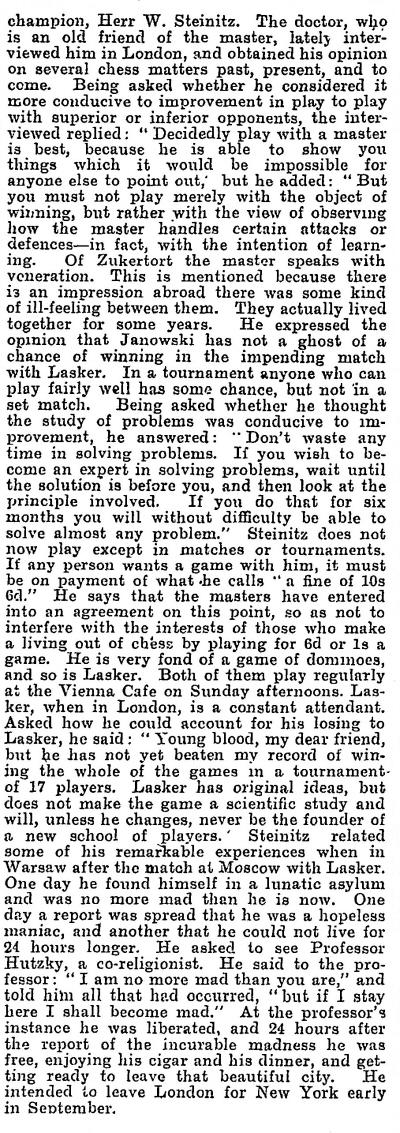
(8290)
In 1899 George Alcock MacDonnell died, a fact which did not prevent Christian Hesse from stating in a ChessBase article that MacDonnell lost a game to Amos Burn in 1910 (see C.N. 8276). On page 183 of The Joys of Chess (Alkmaar, 2011) Hesse had been vaguer and therefore closer to the truth, White being identified only as ‘MacDonald’. He was Edmund E. Macdonald. (See, for instance, our feature article Macdonald v Burn, Liverpool, 1910.)
In 1900 Wilhelm/William Steinitz died, a fact which did not prevent Christian Hesse from quoting a remark by Steinitz about a mate-in-two problem by Pulitzer which, according to Hesse, was dated 1907. (See page 166 of The Joys of Chess.) Hesse miscopied from our presentation of the Pulitzer problem on page 11 of A Chess Omnibus (also included in Steinitz Stuck and Capa Caught). We gave Steinitz’s comments on the composition as quoted on page 60 of the Chess Player’s Scrap Book, April 1907, and that sufficed for Hesse to assume that the problem was composed in 1907.
(8319)
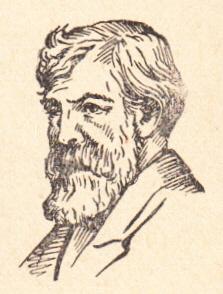
This sketch purportedly of Wilhelm Steinitz comes from page 110 of Schach – mehr als ein Spiel by Herbert R. Grätz (Leipzig, 1964). Is it based on a nineteenth-century picture?
(8342)
Hans Renette forwards an excerpt from pages 79-80 of My Windows on the Street of the World by James Mavor (London and New York, 1923):
‘In 1873 or 74 I resumed my interest in chess, and in one or other of these years I joined the Glasgow Chess Club. About the same time Zukertort came to Glasgow to play a series of simultaneous blindfold games, and I was asked to call out the moves for him. I think he played 22 boards. It was a very marvellous performance. One of the players challenged one of Zukertort’s moves. The player had in defiance of all rules been moving about the pieces on his board. Zukertort was not in the least disturbed by the challenge. He repeated the game from the beginning, and then gave the position as it should be. It is needless to say that he was indisputably right and the seeing player wrong.
Within this decade also I became acquainted with Blackburne, with Captain MacKenzie, the celebrated American chessplayer, and more importantly, with Steinitz, with whom I remained on friendly terms until his death. Steinitz was undoubtedly the greatest chess master of his time, and perhaps of any time. He did not distinguish himself beyond the field of chess, but he had other interests. He had either invented or somehow become involved in an invention in marine engineering. This invention consisted in some alleged improvement in the screw-propeller. I got him some information that he wanted from some of my shipbuilding friends, but I do not think his project came to anything. Much more interesting were his philosophical views which he propounded on various occasions. Curiously enough, he regarded his achievements in chess with great modesty; but he really prided himself upon his powers as a philosopher. I cannot say, however, that there was anything original in his philosophy. So far as I could form a judgment, he was a Spinozist. Among his less well-known writings is a little pamphlet called The Economies of Chess [sic], in which he shows for the benefit of the intending chess professional that chess does not pay. This pamphlet promulgates the thesis which he once developed to me viva voce: “Here am I”, he said, “the most successful chess professional of my time, winner of the most important prizes in chess matches and editor of the most important and remunerative chess column” (he edited the chess column of The Field), “and yet, on the average, I have not received more than the wages of an artisan.” Sometimes, in the eighties, I used to play with Bird at Simpson’s Divan in the Strand, and occasionally Steinitz used to look on and make caustic comments on the game.’
Page 45 of Blindfold Chess by Eliot Hearst and John Knott (Jefferson, 2009) notes that the largest number of blindfold games ever played by Zukertort simultaneously was 16. How many exhibitions he gave in Glasgow we do not know, but one such display, on 12 boards, was reported on page 221 of the February 1873 Chess Player’s Chronicle.
(8401)
McFarland & Company, Inc. is often said to produce the finest chess books, and the company’s catalogue certainly has many very good volumes, including a few of superb quality. Such is the company’s reputation that some reviewers tend to give an unthinkingly warm welcome to any new McFarland title, but blanket praise does a disservice to a truly exceptional book such as Aron Nimzowitsch On the Road to Chess Mastery, 1886-1924 by Per Skjoldager and Jørn Erik Nielsen and is far too generous to, for instance, Isaac Kashdan, American Chess Grandmaster by Peter P. Lahde.
In this sense, McFarland books may serve as a test of the book reviewer’s knowledge, judgement and reliability. If he writes that William Steinitz, Chess Champion by Kurt Landsberger is a dependable work of scholarship, alarm bells should ring.
(8494)
Patsy A. D’Eramo (North East, MD, USA) has found the following games:
Wilhelm Steinitz – Jacob Elson
Philadelphia, 12 December 1882
French Defence
1 e4 e6 2 e5 d5 3 exd6 Bxd6 4 d4 Nf6 5 Nf3 h6 6 Bd3 Nc6 7 O-O O-O 8 Re1 Re8 9 c3 e5 10 dxe5 Nxe5 11 Nxe5 Bxe5
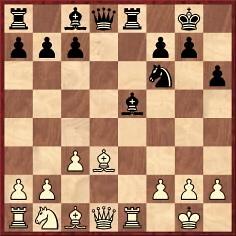
12 h3 Bd6 13 Rxe8+ Qxe8 14 Nd2 Qe5 15 Nf3 Qh5 16 Be3 Bd7 17 Nd4 Qe5 18 Nf3 Qh5 Drawn.
Source: Philadelphia Times, 13 December 1882, page 2.
Otho Michaelis – Wilhelm Steinitz
Fifth match-game, Philadelphia, 13 December 1882
Ruy López
1 e4 e5 2 Nf3 Nc6 3 Bb5 a6 4 Ba4 Nge7 5 d4 exd4 6 Nxd4 Nxd4 7 Qxd4 b5 8 Bb3 d6 9 c3 Be6 10 Bc2 Nc6 11 Qd1 Be7 12 O-O O-O 13 f4 Kh8 14 f5 Bd7 15 Bf4 Bg5 16 Nd2 Bxf4 17 Rxf4 Qg5 18 g3 Ne5 19 Qf1 Rae8 20 Nf3 Qf6 21 Re1 Re7 22 Qf2 c5 23 Nxe5 Rxe5 24 Qd2 Bc6 25 Rd1 Rd8 26 Qe3 Rde8 27 Qd2
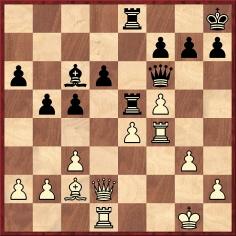
27...d5 28 Qe3 dxe4 29 Rdf1 a5 30 R1f2 b4 Adjourned, with no result reported.
Source: Philadelphia Times, 14 December 1882, page 3.
Wilhelm Steinitz – M.J. Fass and James Wibray
New Orleans, 29 December 1882
(Remove White’s queen’s knight.)
1 e4 e5 2 Bc4 f5 3 d3 Nf6 4 Nf3 c6 5 O-O fxe4 6 dxe4 d5 7 exd5 e4 8 Ne5 cxd5 9 Bb5+ Bd7 10 Nxd7 Nbxd7 11 Bg5 Kf7 12 Kh1 Be7 13 f3 Ne5 14 fxe4 dxe4 15 Qh5+ g6 16 Qh4 Qd6
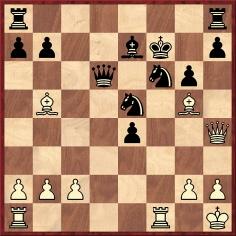
17 Bxf6 Bxf6 18 Rxf6+ Qxf6 19 Rf1 Qxf1+ 20 Bxf1 Rae8 21 Qxe4 Re7 22 Qd5+ Kg7 23 Qc5 Nc6 24 h3 Rc8 25 Qc3+ Kf7 26 b4 Rcc7 27 Qh8 Ke6 28 Bc4+ Kd7 29 Bb3 a6 30 a4 Nd8 31 b5 axb5 32 axb5 Re1+ 33 Kh2 Kc8 34 b6 Rce7 35 Qc3+ Nc6 36 Bd5 Kb8 37 Qh8+ Re8 38 Qxh7 Ne7 39 Bf3 Nc6 40 Qc7+ Ka8 41 Bxc6 Resigns.
Source: New Orleans Times-Picayune, 2 January 1883, page 8.
Wilhelm Steinitz – Otto M. Tennison
Simultaneous exhibition, New Orleans, 2 January 1883
King’s Gambit Accepted
1 e4 e5 2 f4 exf4 3 Nf3 g5 4 Bc4 Bg7 5 O-O h6 6 d4 d6 7 g3 g4 8 Ne1 f3 9 c3 Nf6 10 Bd3 Qe7 11 Na3 Bd7 12 Nc4 Nc6 13 b4 b5 14 Nd2 Nh7 15 Nb3 Ng5 16 Nc2 Nh3+ 17 Kh1 a6 18 Ne3 O-O-O 19 a4 Na7 20 axb5 Nxb5 21 Nd5 Qe6 22 Rxa6 c6 23 Bxb5 cxd5
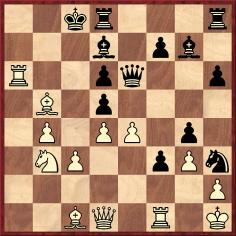
24 Nc5 Qe8 25 Qa4 dxc5 26 Ra8+ Kc7 27 Qa7+ Kd6 28 Qxc5+ Ke6 29 Ra6+ Bc6 30 Bxc6 Resigns.
Source: New Orleans Times-Picayune, 4 January 1883, page 3.
Wilhelm Steinitz – James Wibray
Simultaneous exhibition, New Orleans, 2 January 1883
Bishop’s Opening
1 e4 e5 2 Bc4 Nf6 3 f4 d6 4 Qe2 Bg4 5 Nf3 c6 6 d3 Nbd7 7 O-O Be7 8 Nc3 Qc7 9 Bb3 O-O-O 10 Bxf7 Rdf8 11 Bb3 Nh5 12 f5 Bh4
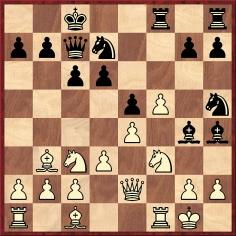
13 Qe3 Bxf3 14 Rxf3 Kb8 15 Rh3 Qd8 16 g3 g5 17 gxh4 g4 18 Rg3 Nxg3 19 hxg3 Nf6 20 Qf2 d5 21 Bd2 d4 22 Ne2 c5 23 Bc4 Qd6 24 c3 a6 25 b4 b5 26 bxc5 Qxc5 27 cxd4 exd4 28 Be6 Nh5 29 Nxd4 Qd6 30 e5 Qb6 31 Be3 Qb7 32 Rc1 Ka8 33 Nc6 Ng7 34 Bd5 Rxf5 35 Bf4 Rc8
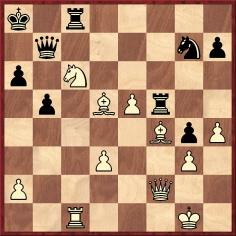
36 Qa7+ Resigns.
Source: New Orleans Times-Picayune, 4 January 1883, page 3.
Wilhelm Steinitz – J. Tardos, Jr.
Simultaneous exhibition, New Orleans, 2 January 1883
Vienna Gambit
1 e4 e5 2 Nc3 Nf6 3 f4 d5 4 d3 dxe4 5 fxe5 Ng4 6 Nxe4 Nc6 7 c3 Qd5 8 Qb3 Qxe5 9 Nf3 Qe6 10 Be2 Qxb3 11 axb3 f5 12 Nf2 Bd6 13 d4 O-O 14 Bc4+ Kh8 15 O-O f4 16 Ne4 Bd7 17 Nxd6 cxd6 18 Ng5 h5 (‘P-R4’) 19 Bxf4 Rf6 20 Bxd6 Rxf1+ 21 Rxf1 Ne3 22 Rf7 Rd8 23 Bf8 Nxc4 24 Bxg7+ Kg8 25 bxc4 Be6 26 Rxb7 Bxc4 27 Bf6 Rb8 28 Rc7 Bd5 29 c4 Resigns.
Source: New Orleans Times-Picayune, 4 January 1883, page 3.
Wilhelm Steinitz – G. Generes
Simultaneous exhibition, New Orleans, 2 January 1883
Two Knights’ Defence
1 e4 e5 2 Nf3 Nc6 3 Bc4 Nf6 4 Ng5 d5 5 exd5 Nxd5 6 Nxf7 Kxf7 7 Qf3+ Ke6 8 Nc3 Nce7 9 d4 c6 10 Bg5 Qd6 11 O-O Qb4 12 Bb3 h6 13 Bxe7 Bxe7 14 Nxd5 cxd5 15 Qxd5+ Kf6 16 Qf7+ Kg5
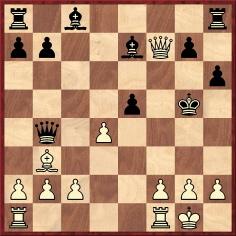
17 h4+ Kg4 18 Qf3+ ‘and mate’.
Source: New Orleans Times-Picayune, 4 January 1883, page 3.
Wilhelm Steinitz – M.J. Fass
Simultaneous exhibition, New Orleans, 2 January 1883
Evans Gambit Declined
1 e4 e5 2 Nf3 Nc6 3 Bc4 Bc5 4 b4 d5 5 exd5 Nxb4 6 Ba3 a5
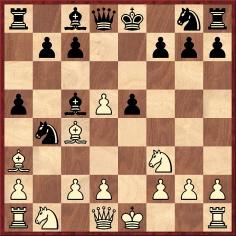
7 c3 Nd3+ 8 Bxd3 Qxd5 9 Qc2 Nf6 10 O-O O-O 11 Ng5 h6 12 Ne4 Nxe4 13 Bxe4 Qd6 14 Bxc5 Qxc5 15 d3 f5 16 Bf3 c6 17 Nd2 a4 18 Rfe1 Bd7 19 Qb2 Rae8 20 Qxb7 Qxc3 21 Nc4 e4 22 Bh5 Re7 23 Qb2 Qxd3 24 Ne5 Qd6 25 Ng6 a3 26 Nxe7+ Qxe7 27 Qc3 Be6 28 Be2 Bd5 29 Bc4 f4 30 Bxd5+ cxd5 31 Qd4 f3 32 Qxd5+ Kh8 33 Qxe4 Qg5 34 g3 Qh5 35 h4 Qf7 36 Re3 Qf6 37 Rae1 Resigns.
Source: New Orleans Times-Picayune, 4 January 1883, page 3.
Wilhelm Steinitz – D.S. Thompson
Philadelphia, 6 November 1883
Falkbeer Counter-Gambit
1 e4 e5 2 f4 d5 3 exd5 e4 4 Nc3 Nf6 5 Qe2 Be7 6 d3 exd3 7 Qxd3 O-O 8 Be3 Na6 9 O-O-O Re8 10 Nf3 Ng4 11 Bg1 Nb4 12 Qd2 c6 13 d6 Qa5 14 dxe7 Be6 15 a3 Nf6 16 f5 Nfd5 17 Nxd5 and wins.
Source: Philadelphia Times, 7 November 1883, page 3.
Julius A. Kaiser – Wilhelm Steinitz
Philadelphia, 27 November 1883
Evans Gambit Accepted
1 e4 e5 2 Nf3 Nc6 3 Bc4 Bc5 4 b4 Bxb4 5 c3 Ba5 6 d4 exd4 7 O-O dxc3 8 Qb3 Qf6 9 e5 Qg6 10 Nxc3 Nge7 11 Ba3 O-O 12 Nd5 d6 13 Bd3 Qh6 14 Bc1 Qe6
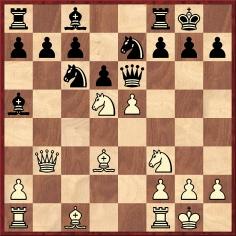
15 Bxh7+ Kh8 16 Be4 Nxd5 17 Ng5 Qxe5 18 Bxd5 Nd4 19 Qd1 Ne2+ 20 Kh1 Bg4 21 f3 Bh5 22 Be4 Nxc1 23 Qxc1 f6 24 Nh3 d5 25 Bd3 Qc3 26 Qd1 g5 27 Rc1 Qd4 28 Qb3 Bf7 29 Bb1 Kg7 30 f4 g4 31 Rfd1 Qb6 32 Qg3 Rg8 33 Qxg4+ Kf8 34 Qh4 Re8 35 f5 Re5 36 Nf4 Ke8 37 Ng6 Re3 38 Qh7 Qd6 39 Qh4 c6 40 Rd4 Kd8 41 Rf4 Rge8 42 Rff1 Bc7 43 Qh7
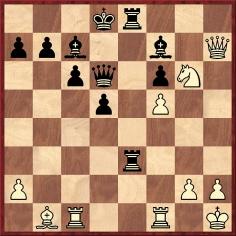
43...d4 44 Nf4 Qxf4 45 Rxf4 Bxf4 46 Qh4 Bd5 47 Kg1 Bg5 48 Qxd4 Re2 49 Rc3 Re1+ 50 Kf2 R8e2+ 51 Kg3 Rxg2+ 52 Kh3 Rh1 53 Qxd5+ cxd5 54 Kxg2 Rxb1 55 White resigns.
Source: New Orleans Times-Picayune, 6 December 1883, page 8. The game had previously been published in the Philadelphia Record, 28 November 1883.
(8590)
A few lines about Sam Loyd from page 186 of William Steinitz, Chess Champion by Kurt Landsberger (Jefferson, 1993):

The references ‘(34)’ and ‘(23)’ relate to entries in the ‘Bibliography’, on page 472. Thus Landsberger’s misinformation that Chess Strategy was published in 1882 (the book was dated 1878) is ascribed simply to the Deutsche Schachzeitung, without any date of issue or other particulars. Landsberger’s source for the Steinitz quote is merely Irving Chernev’s The Bright Side of Chess (with a mix-up over the publication details of the US and UK editions). McFarland & Co. Inc.’s decision to publish William Steinitz, Chess Champion is as bewildering as the encomiums which the back cover of the 2006 paperback edition was able to cite.
Chernev did indeed give the Steinitz quote, without a source, in The Bright Side of Chess (see page 109), and also, in a ‘once’ version, at the start of an article on the inside front cover of the May 1950 Chess Review:
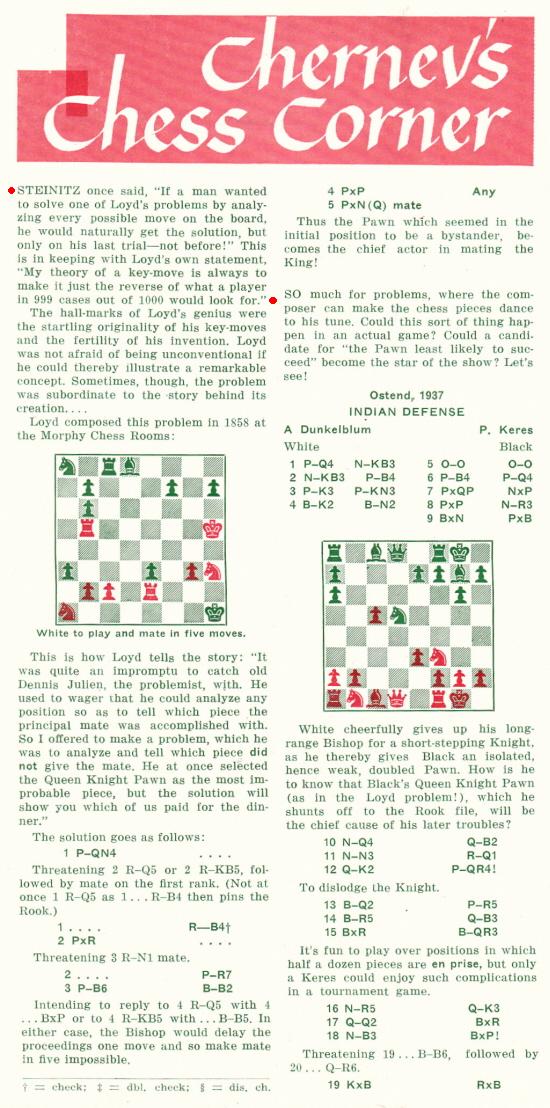
The Loyd section was reproduced by Chernev on page 153 of The Chess Companion (New York, 1968).
But when did the remarks by Steinitz and by Loyd himself first appear in print? Michael McDowell notes that they were both included in an unsigned article on pages 83-85 of the December 1904 issue of Lasker’s Chess Magazine:
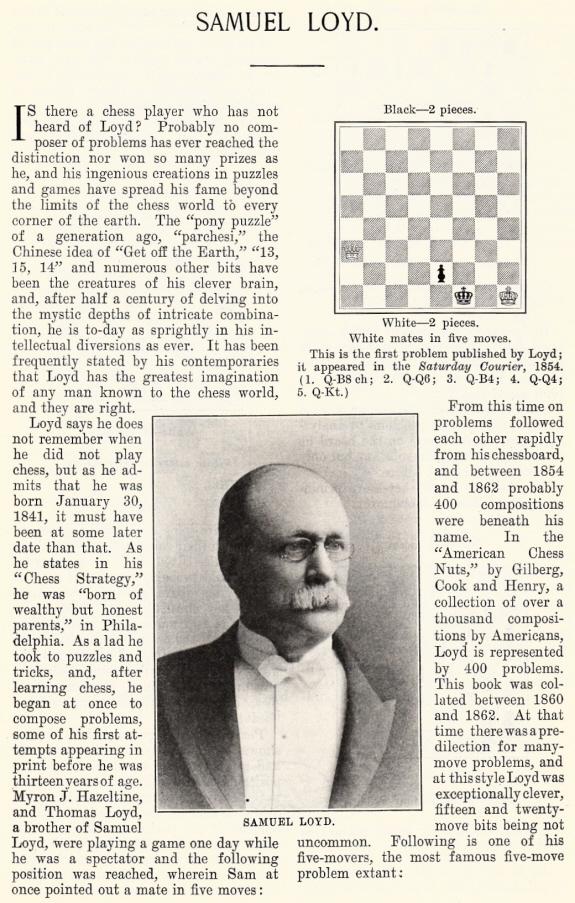
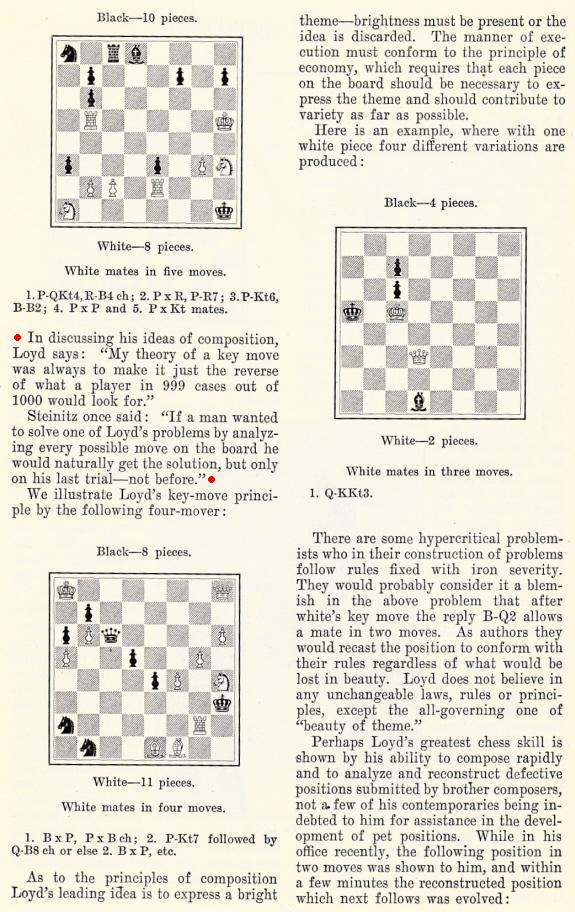
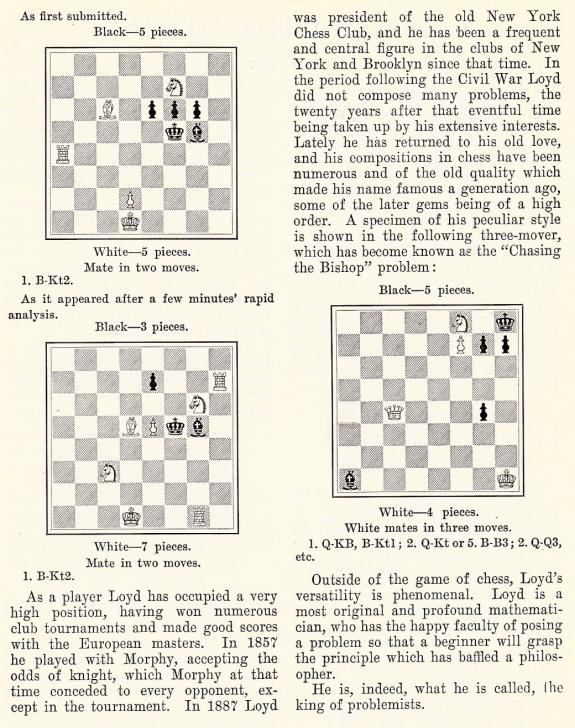
The mast-head named Loyd as an ‘Associate Editor’ of Lasker’s Chess Magazine, and he had a regular column (‘The Problem World’).
Is it possible to find earlier appearances in print of what ‘Steinitz once said’?
(8692)
As shown in C.N. 11686, Loyd’s three-mover ‘The Steinitz Gambit’ was first published on page 262 of the August 1903 issue of Checkmate.
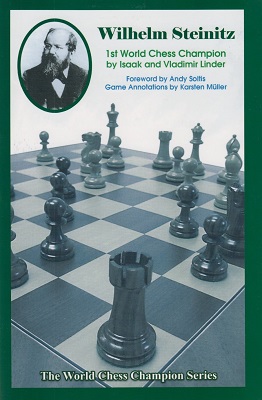
From undiscerning websites based on gossiping, bickering and kibitzing one can count on nothing better, but there are even ‘historians’ who do not bother with sources. For example, Wilhelm Steinitz First World Chess Champion by I. and V. Linder (Milford, 2014) has, on pages 188-190, a section headed ‘World Champions about Steinitz’, comprising a sequence of quotes from Lasker to Kramnik. Many, though not all, mention a year, but not a single one has a source. Capablanca’s comments on Steinitz, for example:
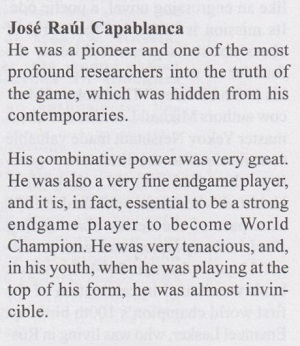
For the information which the book would not give, see Capablanca on his Predecessors.
(9003)
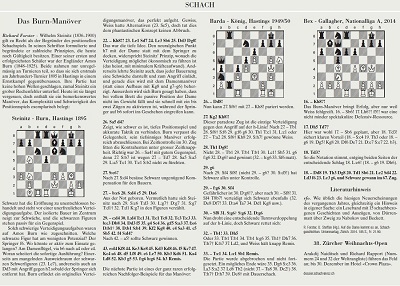
In his column on page 60 of the Neue Zürcher Zeitung, 27 December 2014 Richard Forster offered the term ‘Burn Manoeuvre’ to describe ...Kh8 and ...Qg8, as seen in Steinitz v Burn, Hastings, 1895. He also drew attention to a neglected game in which Black used the manoeuvre in surprising fashion to defend against a dangerous attack on the h-file. At Hastings on 5 January 1950 the position below occurred in the seventh-round game between Olaf Barda and Imre König:
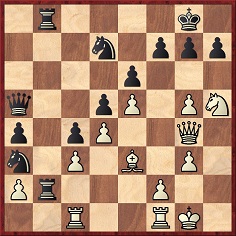
Black to move
26...Qd8 27 Kg2 Kh8 28 Rh1 Qg8
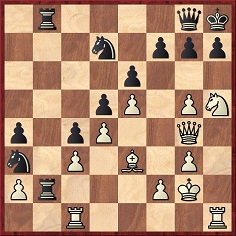
29 g6 fxg6 30 Nf4 Nf8 31 Nxg6+ Nxg6 32 Qxg6 Rb1 33 Qh5 Rxc1 34 Bxc1 Nb1 Drawn. (There are databases which give Black’s final move as the faulty 34...Rb1.)
The game was briefly described, but not given, in the round-by-round reports published in 1950 by the BCM and CHESS. Has it been annotated anywhere?
(9047)
From page 11 of Maxims of Chess by John W. Collins (New York, 1978):

The remark can be found elsewhere in connection with Steinitz, e.g. on page 26 of the January 1953 Chess Review:
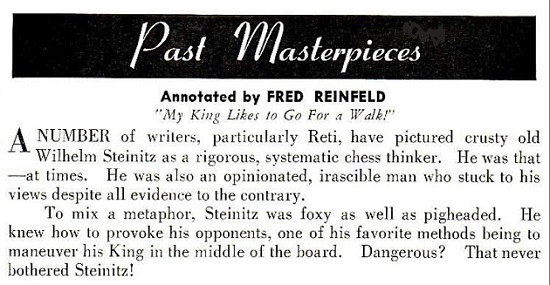
An anecdote on page 13 of The Bright Side of Chess by Irving Chernev (Philadelphia, 1948):
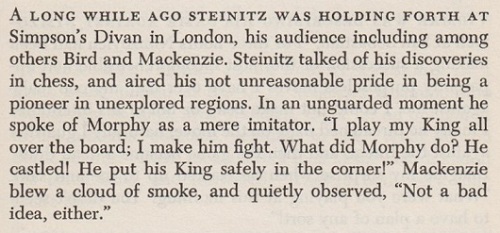
Attempting to trace the story backwards, we find it in these magazines:
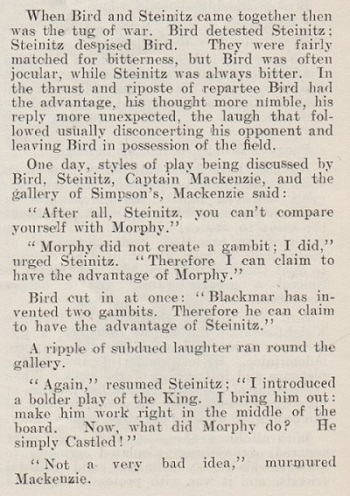
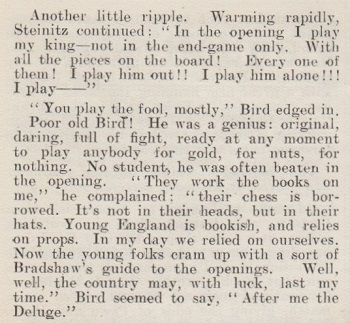
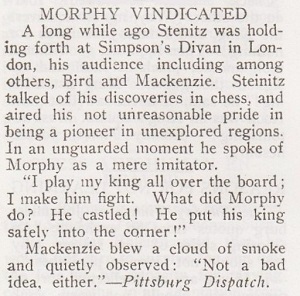
It is disagreeable to note that Chernev’s The Bright Side of Chess copied this exact wording. Can the item in the Pittsburg Dispatch be found?
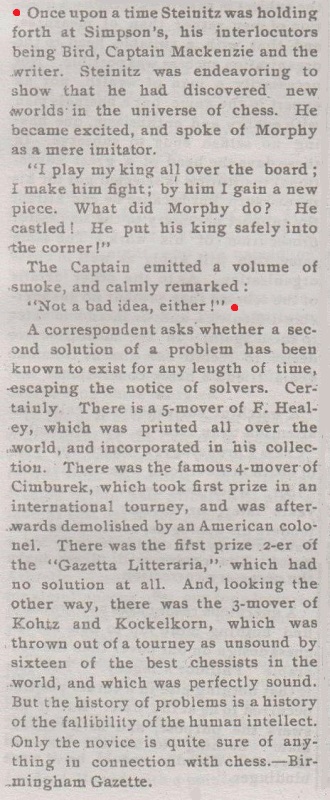
Steinitz’s views can be found in non-anecdotal form in an interview on page 3 of the New-York Daily Tribune, 22 March 1883:
‘How would Morphy compare with the players of the present day?’
‘Well, the game has made immense strides since his time. For one first-class player then, there are 20 now, and the science has developed. Morphy would have to alter his style to suit the new conditions. For instance, Morphy considered the king as an object merely of attack and defence, while the modern view is that it is itself a strong piece, to be used throughout the game. You see how frequently I will move my king all over the board to capture a pawn. In the old days that was never done. It sometimes loses me a game on account of the extraordinary foresight required. That is, in a match game it may do so, but in a game by correspondence never.’
(9084)
Thomas Niessen writes:
‘The website of the National Archives of the Czech Republic has posted online the “Registers of Births, Marriages and Deaths of Jewish Religion Communities from the years 1784-1949”. In one of the registers the second entry on page 277 states that Wilhelm Steinitz was born in Prague, as Wolf Steinitz, on 14 May 1836.’
Our correspondent notes that the register was one of the sources mentioned in the lengthy, though by no means wholly accurate, discussion of Steinitz’s date of birth by Kurt Landsberger on pages 2-3 of William Steinitz, Chess Champion (Jefferson, 1993). (The references to Deutsches Wochenschach and the American Chess Magazine were faulty.) The list of siblings on pages 2-3 of Landsberger’s book indicates that Wolf (Wilhelm) was the ninth of 13, and on page 3 it was concluded that ‘the preponderance of evidence is for the date 14 May 1836’.
(9200)
Steinitz’s passport application was provided in C.N. 7149 by Russell Miller:
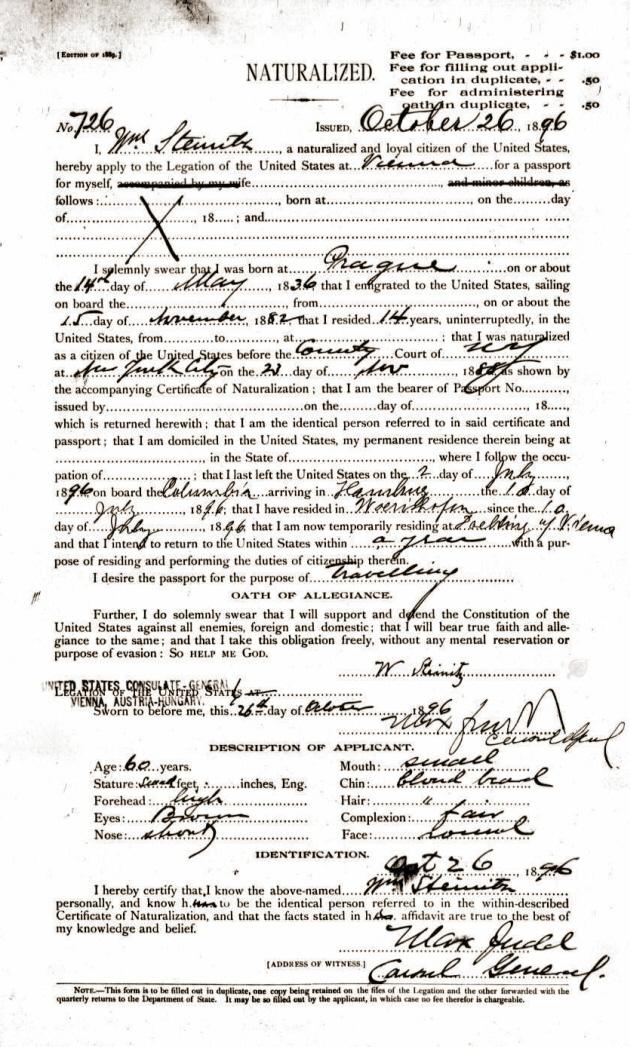
From Thomas Niessen:
‘A number of relevant documents can be found in an online database of the National Archives of the Czech Republic in Prague, including conscriptions, which are police registration forms.
There is a conscription concerning Wolf Steinitz for the years 1855 and 1856, and the fact that he had his own form shows that he was not living with his family (see the general description). The entries in the third, fifth and sixth columns identify him as Wolf Steinitz, born in 1836 in Prague. (It was usual to omit the initial digit 1 in the year, to save space.) The first entry was made on 20 January 1855, and Steinitz was then living in the house 196/5. The second number describes the quarter/district of Prague, and 5 (or the equivalent V) means Josefov (in German: Josefstadt), which was formerly the Jewish ghetto of Prague.
The next document to consider is an extract from a Prague address book for 1859 (Adreßbuch der Königlichen Hauptstadt Prag, etc. by Nikolaus Lehmann, (Prague, 1859), page II-31.)
The house 196 was in the “Rabbinergasse”, and its owners were the “Israel Frankl’sche Stiftung” and several individuals. The “Stiftung” is of particular interest:
Above, from page 102 of the Jahrbuch 1893-94 für die israelitischen Cultusgemeinden Böhmens, etc. (Prague, 1893), is a description of the foundation: apart from a small synagogue, there were two apartments for rabbis of the foundation, six rooms for poor Talmud students, and also one room for Jewish scholars passing through Prague. It was named after its founder, Israel [Simon, Spiro] Frankl, who was “Primator” in the second half of the eighteenth century. I believe that this means that Frankl was a kind of mayor of the Jewish quarter or ghetto, because the Czech word “primátor” means mayor).
The address 196/5 is related to the question of whether Steinitz was a Talmud student in his youth. About a year before his death, the Jewish Chronicle published an article “A Chat with Steinitz” (4 August 1899, pages 12-13). Here is a quote from page 12:
“I asked Steinitz to give me some account of his life. He is descended from a Rabbinical family. The name of his uncle, Lazarstein [sic; Lazar Steinitz], is to be seen on many of the Chumoshin [Pentateuch] published in Prague, where he was the official corrector of the Jewish Press. Prague was Steinitz’s native city. He was born there on 14 May 1836. His grandfather was a Rabbi and celebrated Talmudist. His grandfather’s brother, Sholem Steinitz, was called to Altona to become a Rabbi. Many families of the name Steinitz to be found today in various parts of Germany are descended from Rabbi Sholem Steinitz.
W. Steinitz himself was educated for the Rabbinical profession. At the age of 13 he was acknowledged to be the best Talmudist among the young men in Prague.”
Not every word in that passage is true, but some of the information must be based on Steinitz’s original words. A point of particular interest is that Steinitz was aged 18, and not 13, when the conscription with the address 196/5 was made.
In the fourth column of that conscription, Steinitz was described as “student and son of the master tailor Josef Steinitz, who resides in house 848/1”. In the final column, the word “Einheimisch” means that his home community was Prague. Every Austrian citizen had such a community, which entailed legal implications, e.g. in case of poverty.
On 20 February 1856 Steinitz’s address was changed to 922/2. The figure 2 denotes the quarter “New Town”, which is a little misleading, because it had been founded as early as 1348. The house 922 was in the Mariengasse/Mariánská ulice, which today is Opletalova ulice. (The house, or its successor, can be seen on Google Street View.)
Among the conscriptions there are also two concerning Steinitz’s father. The first one contains information from 1839, whereas the second one begins in 1865. In all three documents, the father’s profession is master tailor (German: Schneidermeister).
The gap between these records can be filled by a folio from a different online database. The Prague City Archives include the Census of the Prague Population (1830-1949).
This document is much more difficult to decipher. It contains entries covering several decades, and the different sets of handwriting are hard to read. It describes the Steinitz family, and the record is therefore stored under the father’s name. In the small column on the very left are many addresses, some of them with years specified. For example, 6/5 in 1837, 195/5 in 1840, 103/5 in 1843, 879/1 in 1850, 842/5 in 1852 and (already known) 848/1 in 1854.
The first person is the father, Joseph Salamon Steinitz, “Schneidermeister”. The third line from the bottom concerns Wolf Steinitz. His birth-date is given correctly as 14 May 1836, and the next column contains a description of his occupation. I am not sure about the first word, which is crossed out, but I think that it is “Schüler” (pupil). However, the second word is clear: “Hauslehrer” (tutor).
The remaining columns of this line are a real challenge. They begin with “in NC 196/5 [1]855”. NC is an abbreviation indicating a house number. So, this states that in 1855 Steinitz was living in 196/5, a fact already known from the above. However, I should like to offer an additional interpretation: both entries show that Steinitz probably left his family in 1855.
The next part of the text is hard to work out, although there is clearly the year, [1]857, which is important for reasons explained below, followed by the word “risidiert” or “residiert”, which means “resides”. Below that text I read “befindet sich in Strakonitz” (“resides in Strakonitz”).
Moreover, two passports are mentioned; one dated 30 June 1857 and the other 6 July 1858. Both were valid for one year, the normal period. The text after the date 30 June 1857 contains the word “Lehrer” (teacher) and, possibly, a description of a place or institution.
It is now necessary to compare these documents with what appeared in Kurt Landsberger’s biography of Steinitz (Jefferson, 1993), and I list some points in the order in which they appear above.
The address 196/5 (or, to be more precise, the numbers 196 and V) appear in the last paragraph on page 7 of Landsberger’s book as a description of a folio, but this is probably a small mistake. The 11 August 1851 document mentioned in that sentence would be very interesting to see. Landsberger discussed there the possibility that Steinitz left his family at the age of 15.
The profession of Steinitz’s father is discussed on page 4 (in the paragraph which begins “The death notice indicated ...”), and all sources confirm Landsberger’s point: the father was a tailor, but not an ironmonger (see Zmatlik’s text on page 6).
Among the many addresses of the family there is no record of what Landsberger calls “Goldrichgasse” (see page 6, in Zmatlik’s text) or “Goldrich Street” (page 8). The name of the street is given differently in several nineteenth-century sources, Golčische Gasse, Goldrichs Gasse, Goldreichsgasse, etc, but only the houses 12-15/V belonged to it.
When Wilhelm Steinitz applied to study at the Polytechnic in Vienna, he mentioned three years of tutoring. Landsberger wrote (in the middle of page 16), “without indicating whether William was tutored or did the tutoring”. That point can be answered now.
Strakonitz’s Czech name is Strakonice. It is a town about 100 km south-west of Prague. At the bottom of page 7 Landsberger wrote a sentence unsupported by any particular reference:
“In 1855 his residence was no longer Prague, but Strakonici [sic].”
The year 1855 is questionable, because in the census document Strakonitz is mentioned after an entry referring to 1857.
Landsberger referred to both passports at the bottom of page 15, and claimed that for some reason Steinitz stayed in the Prague area. However, a passport or “Heimatschein” was necessary to travel, and it seems probable that Steinitz needed the first one to go to Strakonitz.’
(9403)
From Steinitz’s column in The Field, 7 February 1880, page 151:
‘We give the following game in illustration of the curious complications which arise at the odds of the “kept pawn”. This rare advantage was here given by Mr Mortimer, the inventor of the well-known Fraser-Mortimer variation of the Evans Gambit, and the game was played last month at Holloway Prison, where Mr Mortimer is now confined as a first-class misdemeanant, for having allowed a libel to appear in the Figaro, of which paper he is the proprietor. White gives the odds of the KBP coiffé, and undertakes to mate the adversary with that pawn without queening it.’
1 e3 e5 2 d3 d5 3 Nc3 c6 4 g3 Bd6 5 Nf3 Bg4 6 Bg2 e4 7 dxe4 dxe4 8 Nxe4 Bc7 9 Qxd8+ Bxd8 10 Nd6+ Kf8 11 Nxb7 Bb6 12 Nd6 Ne7 13 a4 Bxf3 14 Bxf3 Nd5 15 a5 Bc5 16 Nc4 Bb4+ 17 c3 Be7 18 O-O Nd7 19 Rd1 N7f6 20 Ne5 Rc8 21 c4 Nb4 22 Bd2 c5 23 Bc3 Nc2 24 Rac1 Nb4 25 Nd7+ Nxd7 26 Rxd7 Na2 27 Rc2 Nxc3 28 Rxc3 Bf6 29 Rb3 g6 30 Rbb7 Ke8 31 Rxf7 Bg5 32 Rxh7 Rxh7 33 Rxh7 Rd8 34 Rh8+ Ke7 35 Rxd8 Kxd8 36 Be4 Bf6 37 Bxg6 Bxb2 38 Be4 Kc7 39 Kf1 Bc3 40 a6 Kb6 41 Bb7 Ka5 42 Ke2 Kb4 43 Bd5 Ka5 44 Kd3 Be1 45 f3 Kxa6 46 g4 Bh4 47 f4 Kb6 48 Kc3 Bf6+ 49 Kb3 a5 50 g5 Bg7 51 h4 Ba1 52 h5 Bg7 53 h6 Bh8 54 g6 Bf6 55 g7 Bh4 56 g8(Q) Bf6 57 h7 Kc7 58 h8(R) Kd7 59 Rh7+ Kd6 60 Be4
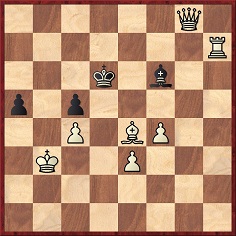
60...Be5 61 Qd8+ Ke6 62 f5 mate.
Black was identified only as ‘Mr B.’ by Steinitz, who annotated the game in depth. His term ‘kept pawn’ may well be an error for ‘capped pawn’.
(9250)
From page 390 of Kings, Commoners and Knaves:
Blackburne offered his views in an interview with The Standard, from which the August 1910 BCM (page 338) printed an excerpt:
‘I think Zukertort was the best for a short time; but he fell off in a few years through ill-health. Steinitz was considered the strongest player, because he beat Zukertort in a match in the London Tournament of 1883. I played Zukertort in 1887, and beat him, but he was not himself at that time. The present champion, Dr Lasker, beat Steinitz ... in the last match Steinitz ever played. I think Dr Lasker is as good as Steinitz ever was in his best days. At the present time he is undoubtedly champion of the world. Morphy ..., in my opinion, would have been superior to Lasker or any champions of the modern school. He was my ideal of a chessplayer, and one of the greatest players, I think, who ever lived.’
On page 7 of the January 1885 International Chess Magazine Steinitz wrote:
‘On sifting the matter by a sort of statistical research, we were rather amused to find, and probably our readers will be astonished to learn, that out of all of Morphy’s match games with Paulsen, Löwenthal, Harrwitz and Anderssen, nay, even including his matches with “Alter” and Mongrédien, therefore in 56 games altogether, there were only two that can lay claim to being called brilliant, namely the ninth with Anderssen and the fourth with Harrwitz. As regards the former, Morphy leaves a bishop to be taken on the ninth move, for which he might gain a clear rook, coming out with the exchange ahead. He prefers instituting an apparently vehement attack, which might have resulted in an exchange of queens, Morphy remaining only with one pawn ahead, and with two knights against the adverse two bishops, and we do not agree that the game was so absolutely lost for Anderssen as represented by Löwenthal. Winning the exchange was more sure. Doubt has also been thrown by the Chess Monthly on the soundness of the sacrifice, on the ground that on the 14th move Anderssen might have played K-K2, a move which it would have been heresy to think of at that time, because it blocks up queen and bishop, but nowadays any second-class player would give it his first consideration if he has the chance of remaining a piece ahead; knowing that it has been often enough successful even with a pawn behind. However, Anderssen plays K-Kt3, overlooking a very brilliant winding up, of which his ingenious opponent fully avails himself.’
(9519)
A claim by Fred Reinfeld on page 185 of The Joys of Chess (New York, 1961):
‘In his old age Steinitz was such a fanatical preacher for defensive play that he must have regretted the brilliancies of his youth.’
(9567)
From page 62 of the book mentioned in C.N. 9884, Introduction to Chess by Christopher Nicole (London, 1973):
‘Wilhelm Steinitz, the first recognized world champion, used to say, “Stall, stall, and then stall some more. Sooner or later your opponent will get an idea, and that idea will smell”.’
We do not know where or when Steinitz ‘used to say’ this, or what grounds I.A. Horowitz had for writing the following on page 27 of the February 1946 Chess Review:
‘... Steinitz, whose famous proverb had suggested the proper strategy: “Stall, stall and stall some more. Your opponent will be sure to get an idea. It will be sure to be rotten, and you will win.”’
Tarrasch is also mentioned in this connection, e.g. on page 254 of The Wisest Things Ever Said About Chess by Andrew Soltis (London, 2008):
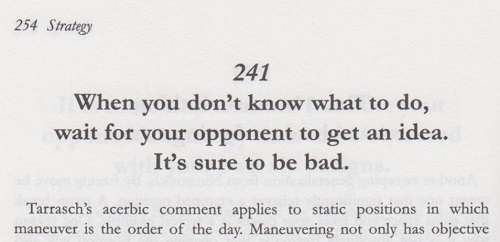
Naturally no source was given.
(9894)
When the facts about, for example, a player’s identity, a date or a venue are open to doubt, the reader needs to be informed accordingly, and a question mark helpfully signals caution. Nonetheless, some writers prefer to plump, perhaps at random, for one of the options, thereby presenting as a certainty a matter on which the evidence is mixed. A question mark added in, for instance, a game heading, to indicate that the factual details are not clear-cut, is a sign of strength, not weakness.
(9887)
A common example of the plumping process discussed in C.N. 9887 concerns quotations. When plumpers say what a given master ‘once said’, ‘often said’ or ‘used to say’, they are simply opting for one version of what earlier plumpers said was said. No caveats are expressed, and random possibilities are presented as fact.
A dictum usually ascribed to Steinitz is that the best way to refute an offer is to accept it. The wording varies, au gré du preneur, and either ‘gambit’ or ‘sacrifice’ may be plumped for.
The investigator hoping that a McFarland book will resolve the question may turn to William Steinitz, Chess Champion by Kurt Landsberger (Jefferson, 1993), but it fell far short of that publisher’s usual standards. Page 282 attributed this remark to Steinitz:
‘“The refutation of a sacrifice fervently consists in its acceptance” (80).’
The word ‘fervently’ is peculiar, but the matter can be pursued because the ‘(80)’ relates to a source note on page 473. Any hope of a precise reference to, perhaps, one of Steinitz’s books or columns, or to the International Chess Magazine, is dashed. Note 80 merely states:
‘80. Levy & Reuben. The Chess Scene. London: Faber & Faber, 1974.’
So the next step, however unpromising, is to turn to The Chess Scene, which has the following on page 70:
‘The refutation of a sacrifice frequently consists in its acceptance. Steinitz.’
As feared, we are no further forward, except that ‘fervently’ can be seen as Landsberger’s mistranscription of ‘frequently’.
Although they did not bother to say so, the exact wording given by Levy and Reuben was in the entry for Epigrams on page 119 of The Encyclopaedia of Chess by Anne Sunnucks (London, 1970):
‘The refutation of a sacrifice frequently consists in its acceptance. W Steinitz.’
Again, no source was supplied.
A few years earlier, the ‘gambit’ version had cropped up twice in book two of The Middle Game by Max Euwe and Haije Kramer (London, 1965):
‘Steinitz would certainly have taken it [a pawn], following his own motto “The only way to refute a gambit is to accept it”.’ (Page 276).
‘“The only way to refute a gambit”, said Steinitz, “is to accept it”.’ (Page 329).
Books co-authored by Savielly Tartakower and Julius du Mont had both the ‘sacrifice’ and the ‘gambit’ versions, with Steinitz mentioned in connection with the former:
‘Steinitz’s dictum that “a sacrifice is best refuted by its acceptance” is here put to the test.’
Source: page 233 of 500 Master Games of Chess, book one (London, 1952).
‘On the principle that the best refutation of a gambit is to accept it.’
Source: page 16 of 100 Master Games of Modern Chess (London, 1954).
From the previous decade, page 178 of The World’s a Chessboard by Reuben Fine (Philadelphia, 1948) had this:
‘Steinitz used to say that the way to refute a gambit is to accept it.’
Fine’s text had originally appeared on page 24 of the Chess Review, June-July 1946. On page 43 of the November 1946 issue I.A. Horowitz wrote after 1 e4 e5 2 d4 exd4:
‘As a rule, and this is no exception, the best way to meet a gambit is to accept it ...’
Larry Evans’ books and articles often referred to the remark sourcelessly, and page 86 of The Italian Gambit by Jude Acers and George S. Laven (Victoria, 2003) even attributed it to him, also sourcelessly:
‘The best way to refute a gambit is to accept it. – GM L. Evans.’
From pages 221-222 of The Human Side of Chess by Fred Reinfeld (New York, 1952), in his notes to an 1860 game won by Anderssen with the Evans Gambit:
‘To decline a gambit in those days was almost as unthinkable as for a gentleman to decline to fight a duel. Offering the gambit was a challenge that one could refuse only at the risk of stamping himself as a sissy and a coward.
Later on Steinitz, with the attitude of “a pawn’s a pawn for a’ that”, gave the quietus to aristocratic chess.’
That brings to mind a paragraph on page 4 of Winning with Chess Psychology by Pal Benko and Burt Hochberg (New York, 1991):
‘Steinitz believed that the choice of a plan or move must be based not on a single-minded desire for checkmate but on the objective characteristics of the position. One was not being a sissy to decline a sacrifice, he declared, if concrete analysis showed that accepting it would be dangerous. There was no shame in taking the trouble to win a pawn. A superior endgame was no less legitimate a goal of an opening or middlegame plan than was the possibility of a mating attack.’
The penultimate sentence will take us on to a related remark regularly ascribed to Steinitz. One example comes from page 228 of The Most Instructive Games of Chess Ever Played by Irving Chernev (New York, 1965):
‘... as Steinitz once mentioned, “A pawn ahead is worth a little trouble”.’
The observation ‘When in doubt, take a pawn. A pawn is worth a little trouble’ is on page 282 of Landsberger’s above-mentioned book on Steinitz. Again, the reference is ‘(80)’, and again the quote is on page 70 of Levy and Reuben’s The Chess Scene, again without a source.
And so it goes on. Many chess writers do not take even a little trouble and, above all, they pretend to possess knowledge which they do not have. Entire websites are ‘devoted’ to sourceless quotations, that most facile way of filling space, and they are a plumper’s charter.
Assistance from readers in tracking down the exact origins of the gambit and sacrifice remarks will be greatly appreciated.
(9929)
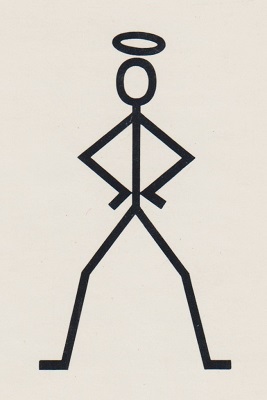
‘And the best way to refute a gambit is to accept it.’
That observation occurs in The Pawn Gambit on page 158 of Send for the Saint by Leslie Charteris (London, 1977):
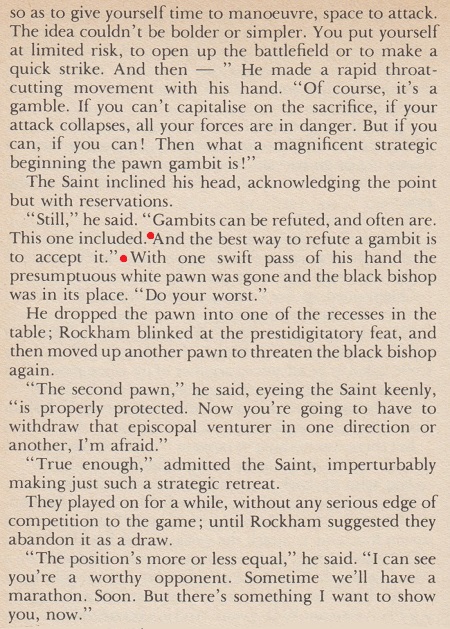
In a description of an Evans Gambit game the previous page had references to ‘the Göttingen manuscript of 1490’, ‘Bird, Blackman, Staunton, Anderssen’ and ‘Morphy, Steinity’.
The Pawn Gambit (the title The Pawn Gamble can also be found) was not written by Charteris. The contents page of Send for the Saint specified ‘Original Teleplay by Donald James’ and ‘Adapted by Peter Bloxsom’. The corresponding television episode, starring Roger Moore as Simon Templar, was ‘The Organisation Man’ (1968).
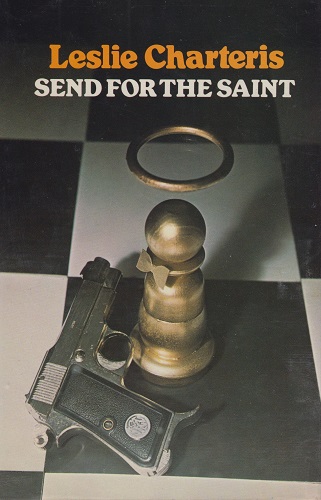
(9952)
Steinitz on page 114 of the International Chess Magazine, April 1885:

(9974)
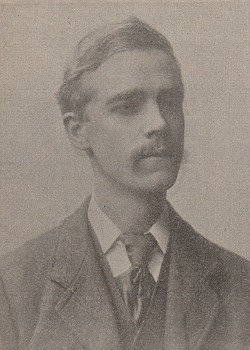
Henry Ernest Atkins (BCM, October 1897, page 382)
A Treasury of British Chess Masterpieces by Fred Reinfeld (London, 1950), page 70.
H.E. Atkins Doyen of British Chess Champions by R.N. Coles (London, 1952), page 2.
Harry Golombek, in The Times (Review section), 7 September 1968, page 23.
Entry on Atkins, by Raymond Keene, in The Encyclopedia of Chess by Harry Golombek (London, 1977), page 17.
Harry Golombek, The Times (Review section), 29 August 1981, page 12.
A source for this claim about Atkins is never specified, and the best that we can offer is the following, from page 34 of the first (1922) issue of Chess Pie:
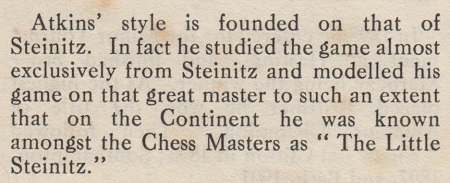
To what extent was Atkins ever known ‘on the Continent’ as ‘the little Steinitz’? More generally, even if nicknames of this sort can be corroborated, their purpose and value are far from clear.
(10173)
C.N. 10173 quoted six unsubstantiated assertions that ‘the little Steinitz’ was H.E. Atkins’ nickname ‘on the Continent’. A seventh instance is in an article about Atkins by Harry Golombek on page 70 of Chess Treasury of the Air by Terence Tiller (Harmondsworth, 1966).
(11209)
Neil Blackburn (Redditch, England) draws attention to an observation by Lasker about Steinitz (Lasker’s Chess Magazine, August-September 1906, page 182) concerning the opening game of their first world championship match (New York, 15 and 16 March 1894), in which Lasker was White. 1 e4 e5 2 Nf3 Nc6 3 Bb5 d6 4 d4 Bd7 5 Nc3:
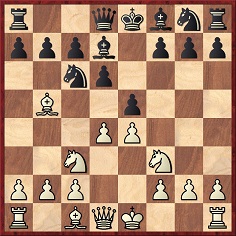
Steinitz now played 5...Nge7.
Lasker wrote:
‘I did not try for more than the slight advantage which naturally accrues to the first player from a somewhat quicker development. Steinitz played an absolutely sound defence to my Ruy López, such as with slight modification has come into vogue at the present moment. Still, his fifth move left something to be desired, as it advanced Black’s development only to a small degree. But quick development was not a thing which Steinitz aimed at.
He was satisfied with a development sufficiently rapid to meet attacks, but sufficiently backward to leave many pieces unexchanged and to lead to many complications – an ingenious idea of which nobody but Steinitz has ever known, the masterly execution.
It was in the nature of things that Black’s king’s knight had to make many moves before it arrived at a stable position. The fifth move implied that necessity.’
Pages 183-184 had Steinitz’s annotations to the game. The first two notes:
After 3...d6: ‘The revival of this defence met with much opposition, but I have seen nothing as yet to vitiate the equalizing effect which, in my opinion, it possesses.’
After 5...Nge7: ‘An important key-move to this defence, which I first adopted in my match against Gunsberg.’
Steinitz was referring to the second game of his 1890-91 match against Gunsberg, which began 1 e4 e5 2 Nf3 Nc6 3 Bb5 d6 4 c3 Bd7 5 O-O Nge7.
Steinitz’s notes to the above-mentioned Lasker game were published in the New York Recorder of 18 March 1894. An account by Lasker had appeared in the New York Daily Tribune the previous day.
(10434)
Extracts from our feature article on Pollock:
Few chessplayers today seem to know much about W.H.K. Pollock (1859-96), yet in his time he was celebrated for his spectacular combinations and original style of play. He seldom came first in events, an exception being the Belfast, 1886 tournament, which he won with a clean score of 8/8, ahead of Blackburne and Burn. On the other hand, many of his individual games received high plaudits from the most demanding critics, as is shown by a brief compilation of comments by the then world champion, Steinitz:
Pollock defeated Steinitz in their only individual encounter (Hastings, 1895), a game which the victor annotated on pages 396-397 of the September 1895 BCM. Apart from their intrinsic interest, the notes are significant for being the source of Pollock’s most famous quote, ‘It is no easy matter to reply correctly to Lasker’s bad moves.’
Wilhelm Steinitz – William Henry Krause Pollock
Hastings, 12 August 1895
Giuoco Piano
(Notes by Pollock)
1 e4 e5 2 Nf3 Nc6 3 Bc4 Bc5 4 c3 (‘A favourite opening with Mr Steinitz in this tournament, in which he has beautifully demonstrated the efficiency of some new ideas contained in the last section of the Modern Chess Instructor.’) 4…Qe7 (‘Strangely enough, this valid old defence of the days of the Berlin ‘Pleiades’ has escaped all notice in the work referred to. A little story comes in here: Previous to the championship match between Steinitz and Lasker, at the request of the latter I played the defence to the Giuoco in a few off-hand games with him at the Manhattan Chess Club. I adopted this old defence without success, although Lasker admitted it was new to him. But I told him that Steinitz would play it against him and beat him if he did not play the attack differently. (It is no easy matter to reply correctly to Lasker’s bad moves.) Lasker good humouredly suggested that we submit the theoretical question to Showalter. However, he did not adopt this attack against Steinitz. The points of the defence are well shown in the present game.’) 5 d4 Bb6 6 a4 a5 7 O-O d6 8 d5 (‘This is, as usual, a questionable advance.’) 8…Nd8 9 Bd3 Nf6 (‘White’s ninth move was in order to prevent …f5. Without doubt Black should now have played for the advance by 9…g6.’) 10 Na3 c6 11 Nc4 Bc7 12 Ne3 Nh5 (‘If 12…cxd5 13 Bb5+, followed by 14 Nxd5. Nor can Black well castle, on account of 13 Nh4, threatening to establish a knight at f5.’) 13 g3 g6 14 b4 (‘Intending no doubt 15 dxc6 bxc6 16 b5, when it would be difficult to prevent the posting of the white knight at d5.’) 14…f5 (‘It is necessary for Black to attack, but the situation is a critical one.’) 15 Ng2 (‘15 dxc6 might have been tried as an alternative to prevent 15…f4, for if then 15…f4 16 cxb7, followed by Bb5+ and Nd5.’) 15…cxd5 16 exd5 (‘Preferable certainly seems 16 Bb5+ and if 16…Bd7 17 exf5, with the threat of Nxe5 or Bg5 presently.’) 16…Nf7 (‘In order to keep the queen’s bishop out.’) 17 Re1 O-O (‘Black has now an excellent position.’) 18 Nd4 Qf6 19 Nb5 Bb6 20 bxa5 Bxa5 21 Be2 Ng7 22 Bd2 Bd7 23 Rf1 Rac8 24 c4 Bb6 25 Be3 Bxe3 26 fxe3 Ng5 (‘Of course an attack by …g5 might be on the cards, but Black prefers the safer plan of …Ne4 and …Nc5, thus first securing the queen’s side.’) 27 Nc3 (‘Bad, as yielding the opponent a splendid opportunity for a king’s side assault.’) 27…f4 28 Qc2 (‘If 28 gxf4 exf4, attacking the knight.’) 28…f3 29 Nh4 (‘If the bishop moves, 29…Nh3+, followed by 30…fxg2+.’) 29…Nf5
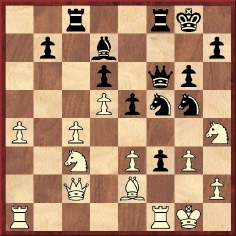
30 Rxf3 (‘If 30 Nxf5 Bxf5 31 Bd3 f2+, etc.’) 30…Nxf3+ 31 Nxf3 Nxe3 32 Qb1 Nxc4 33 Ne4 Qd8 34 Qxb7 Na5 35 Qb4 Bg4 36 Rf1 Bh3 37 Re1 Rb8 38 Qxd6 Qxd6 39 Nxd6 Rb2 40 Bd1 Rg2+ 41 Kh1 Rf2 42 Ne4 R2xf3 43 Bxf3 Rxf3 44 d6 Rf1+ 45 Rxf1 Bxf1 46 Kg1 Bd3 (‘Not 46…Bh3 on account of 47 g4.’) 47 Nf6+ Kf7 48 Nxh7 Ke6 49 Kf2 Kxd6 50 Ke3 Bc2 51 h4 Nc4+ 52 Ke2 Kd5 53 g4 Kd4 (‘The ending is a good one for the ‘gallery’; either the king or pawn must advance with immediate effect.’) 54 Nf8 Bd3+ 55 Ke1 Ke3 56 h5 gxh5 (‘Unnecessary; Black has a mate in four moves here.’) 57 gxh5 Be2 58 Nd7 Na3 59 White resigns.
It is instructive to compare the above notes with those by Pillsbury in the Hastings, 1895 tournament book (edited by Horace F. Cheshire) and, for a modern view, with the annotations of Colin Crouch in the 1995 monograph on the tournament which he co-wrote with Kean Haines. Pillsbury’s final note read, ‘Rather an amusing finish to a very interesting game’.
The following footnote was given on page 232 of A Chess Omnibus:
In a letter to Walter Penn Shipley dated 23 June 1894 Steinitz referred to ‘the black ingratitude and daily hostility of drunken Pollock whom I had treated like a brother’. Source: The Steinitz Papers by K. Landsberger, page 188.
From a column by Fred Reinfeld (Chess Review, March 1952, page 77):
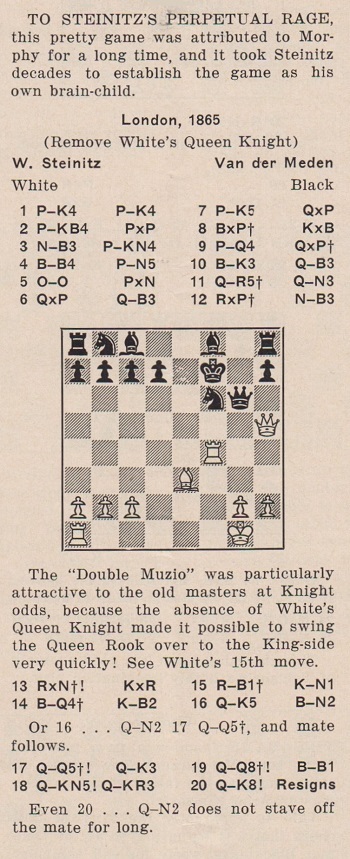
Reinfeld appeared unaware that, less than a decade earlier, a very similar game had been played by Morphy. Nothing has been found to justify the assertion that Steinitz was in a ‘perpetual rage’ with regard to his Muzio Gambit game.
Establishing the basic facts about either game is not easy. For example, the name of Steinitz’s opponent appears inconsistently in chess literature. Reinfeld also named him as ‘van der Meden’ on pages 40-42 of Great Moments in Chess (New York, 1963), which had this introduction: ‘Games like the following one show how Steinitz acquired the nickname of “the Austrian Morphy”.’ Chernev’s 1000 Best Short Games of Chess (pages 341-342) called him ‘Meden’. Pages 97-98 of the first volume of Bachmann’s monograph on Steinitz had ‘Van der Meelen’ and offered an occasion: the London Club, 10 December 1865. However, that is the exact date when the game was published, with Black unidentified, in the Era (page 4):
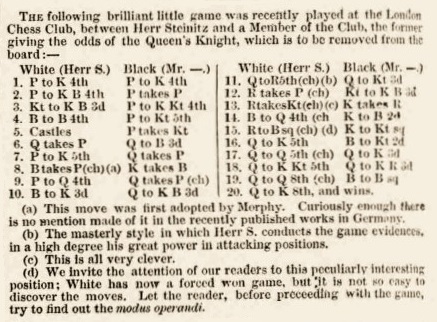
The similar game by Morphy referred to above was on page 206 of the July 1858 Chess Monthly:
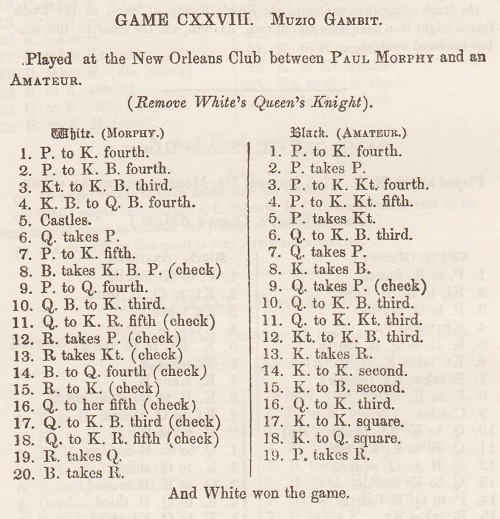
The venue specified above is the New Orleans Chess Club, but a number of Morphy anthologies place the game in New York (with the date 1857).
Both games were discussed by Steinitz in a series of ‘Personal and General’ articles in the International Chess Magazine, May, June, July and August 1885. On pages 210-211 of the July 1885 issue, Steinitz stressed his familiarity with the Morphy game, noting its publication in the Chess Monthly. See too pages 71-80 of The Steinitz Papers by Kurt Landsberger (Jefferson, 2002).
Writing before clarification of the exact year of his game had been provided, Steinitz stated on page 143 of the May 1885 International Chess Magazine:
‘I played the game, a Muzio Gambit at the odds of a Kt, at the old London Chess Club, against Herr van der Meden, then Belgian Consul in London, in the year 1866 at the very latest.’
On page 14 of The Transactions of the British Chess Association for the Years 1866 and 1867 by J. Löwenthal and G.W. Medley (London, 1868) a list of subscribers included ‘Von der Meden, O.’.
(10464)
C.N.s 3680, 3681, 3689 and 9904 (see Chess and Postage Stamps) showed Austrian stamps featuring Alekhine, Capablanca, Fischer, Kasparov, Rubinstein and Mieses.
We have a few others, including portraits of Steinitz, Lasker and Smyslov:
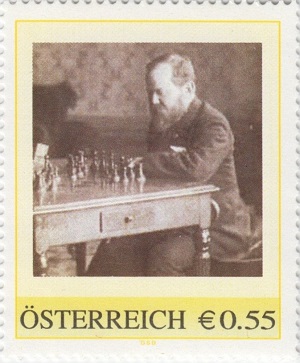
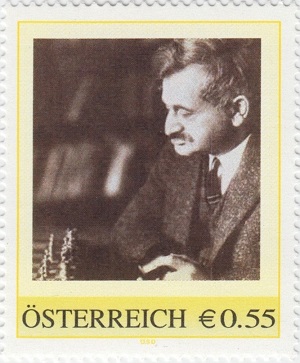
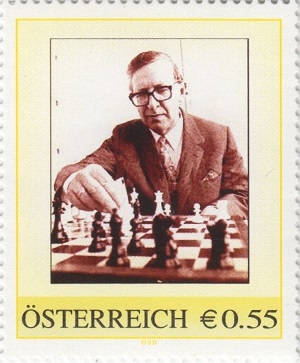
(10545)
How much of Fred Reinfeld’s passage below, concerning Steinitz and Chigorin, can be corroborated?
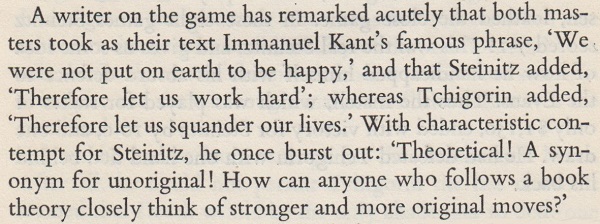
The source is Reinfeld’s book The Great Chess Masters and Their Games (subtitle: ‘The Human Side of Chess’). See pages 109-110 of the original US edition (New York, 1952) and page 113 of the UK edition (London, 1953).
(10641)
Dan Scoones (Port Coquitlam, BC, Canada) writes:
‘The final quote from Chigorin in C.N. 10641 was on page 13 of Nikolai Grekov’s book Soviet Chess (New York, 1949):
The book’s translator was Theodore Reich.
Earlier the Chigorin quote had been given by Grekov on page 539 of his book Великий русский шахматист М. И. Чигорин (Moscow, 1939), again without any source:
“Нередко... ‘теоретическое’ – синоним шаблонного. Ибо что такое ‘теоретическое’ в шахматах, как не то, что можно встретить в учебниках и чего стараются придерживаться, раз не могут придумать чего-либо более сильного или равного, самобытного.”
I propose this translation:
“Often ... the ‘theoretical’ is synonymous with the stereotypical. For the ‘theoretical’ in chess is nothing other than what can be found in textbooks, which people try to follow because they cannot think of anything stronger, equally strong, or original.”’
(10646)
C.N. 1075 (see page 241 of Chess Explorations and Steinitz Quotes) reproduced some affectionate remarks by Steinitz about Bernhard Horwitz from page 301 of the October 1885 International Chess Magazine. A further comment by the world champion was on page 366 of the December 1888 issue:
‘... probably the most gentle and good-natured chess master that has ever graced our Royal pastime.’
(10684)
This photograph, from page 6 of Das interessante Blatt, 26 April 1894, has been noted by Jan Kalendovský (Brno, Czech Republic):
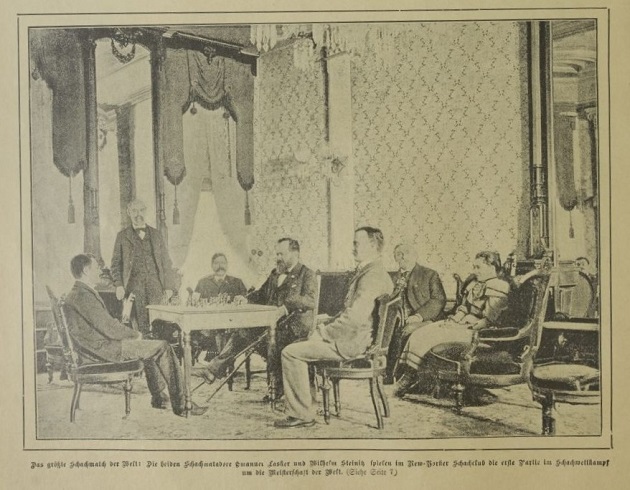
The picture was given, from another source, on page 55 of Emanuel Lasker Denker Weltenbürger Schachweltmeister edited by Richard Forster, Stefan Hansen and Michael Negele (Berlin, 2009).
(10824)
From page 15 of Short v Kasparov The Hi-jacking of The World Chess Championship by William Hartston (London, 1993):
‘Apart from the madness (which only afflicted him in his final years), Steinitz’s intellect was one of the greatest that ever chose to devote itself to chess.’
(10840)
‘And it is in this respect that Agatha Christie repeats her Cards on the Table triumph and, as it were, plays and beats Steinitz with a single row of pawns.’
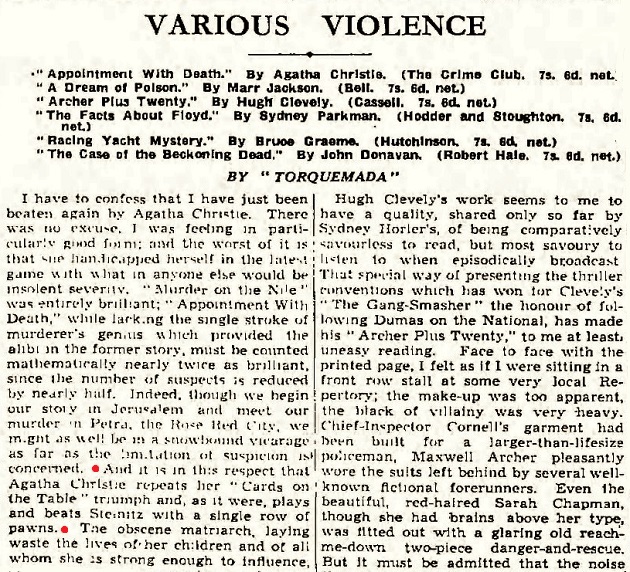
That review by ‘Torquemada’ of the Agatha Christie novel Appointment with Death comes from page 7 of the Observer, 1 May 1938.
(11033)
Page 233 of the Chess Player’s Chronicle, 1 October 1878 had an acrostic by W.H. Cubison on Zukertort:
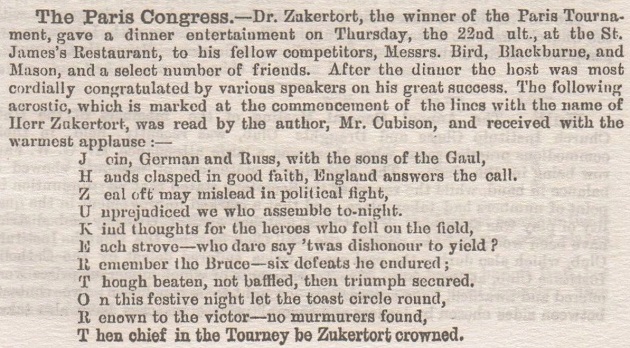
The May 1889 issue of Hoffer’s Chess Monthly (pages 259-260) published a poem by Cubison in commemoration of Kolisch, and page 265 of the same issue carried, anonymously, the notorious ‘Sty-nits’ verse. On page 180 of the June 1889 International Chess Magazine Steinitz deduced that Cubison had written that poem too, an accusation for which he apologized ‘most sincerely and to the fullest extent’ on page 298 of the October 1889 issue of his magazine.
(11060)
On the ‘Sty-nits’ topic, below is the sequence of items in the Chess Monthly, edited by Hoffer, and the International Chess Magazine, edited by Steinitz:
Chess Monthly, May 1889, pages 264-265:
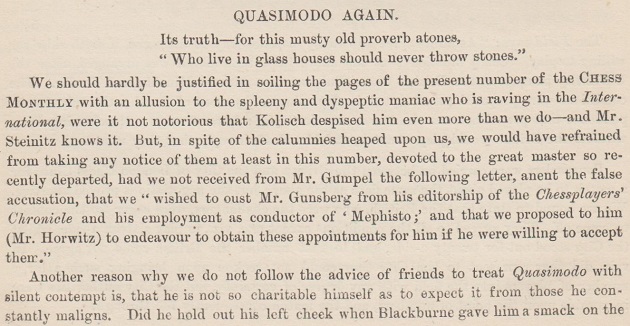
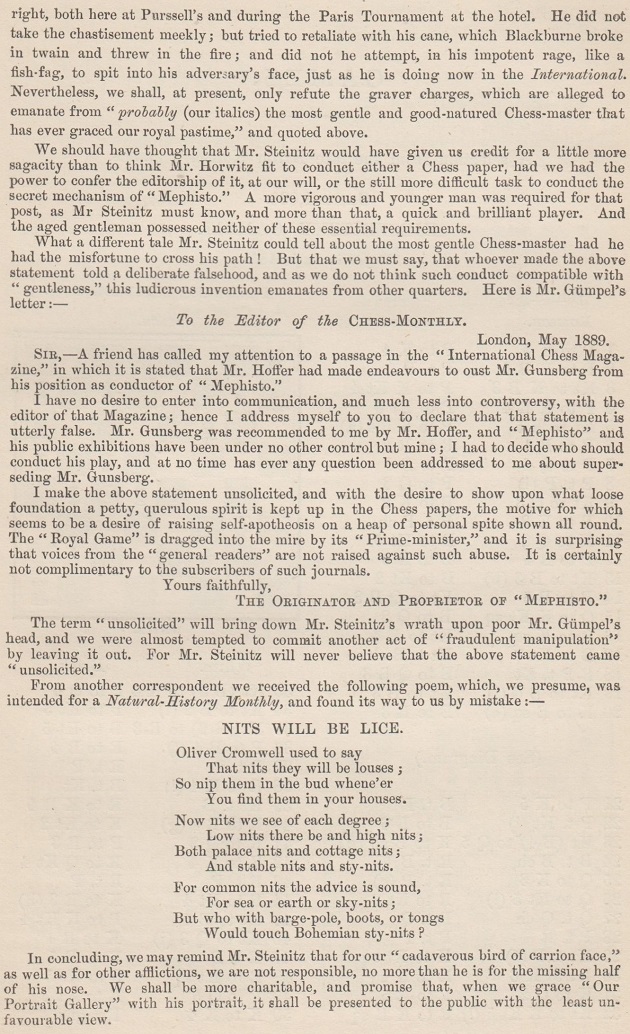
International Chess Magazine, June 1889, page 180:
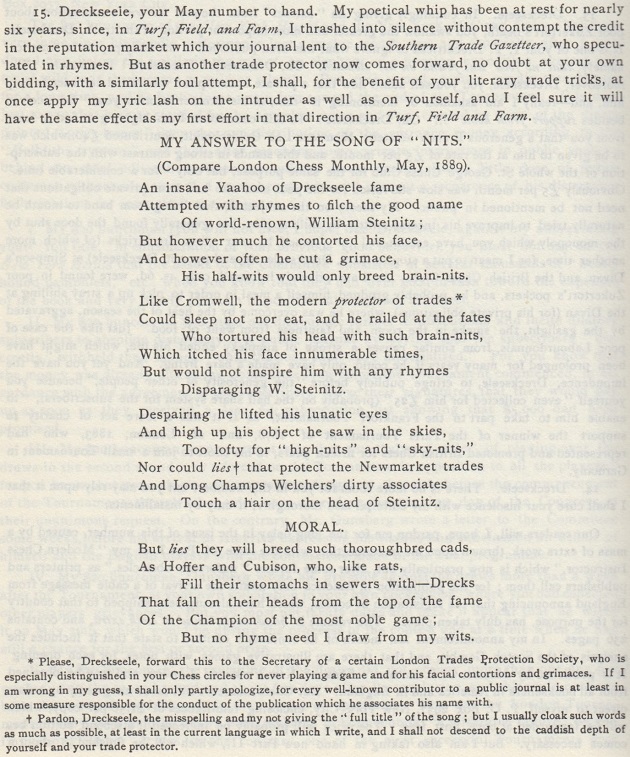
Chess Monthly, September 1889:
A further poem was published in this issue but subsequently withdrawn and replaced by other matter. The 30-verse poem, ‘Song of a Nit’, was reproduced on pages 223-225 of Kurt Landsberger’s first book on Steinitz, but our bound volume of the Chess Monthly has only the replacement material (tournament reports). The same applies to the copies of the Chess Monthly held by libraries and other colleagues whom we have consulted so far. Can any reader send the pages of the September 1889 Chess Monthly which had the poem?
International Chess Magazine, October 1889, page 298:
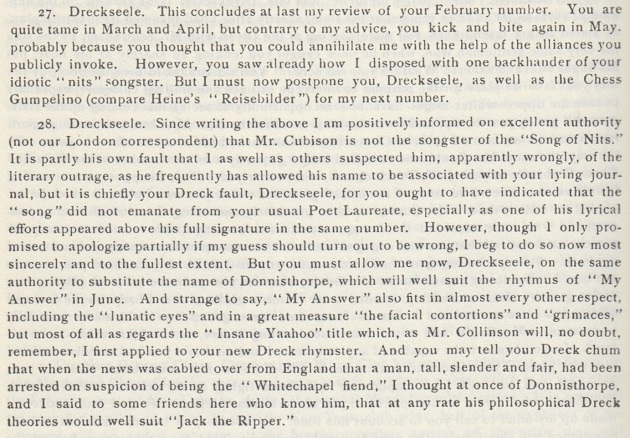
International Chess Magazine, November 1889, page 334:

International Chess Magazine, December 1889, pages 369-370:
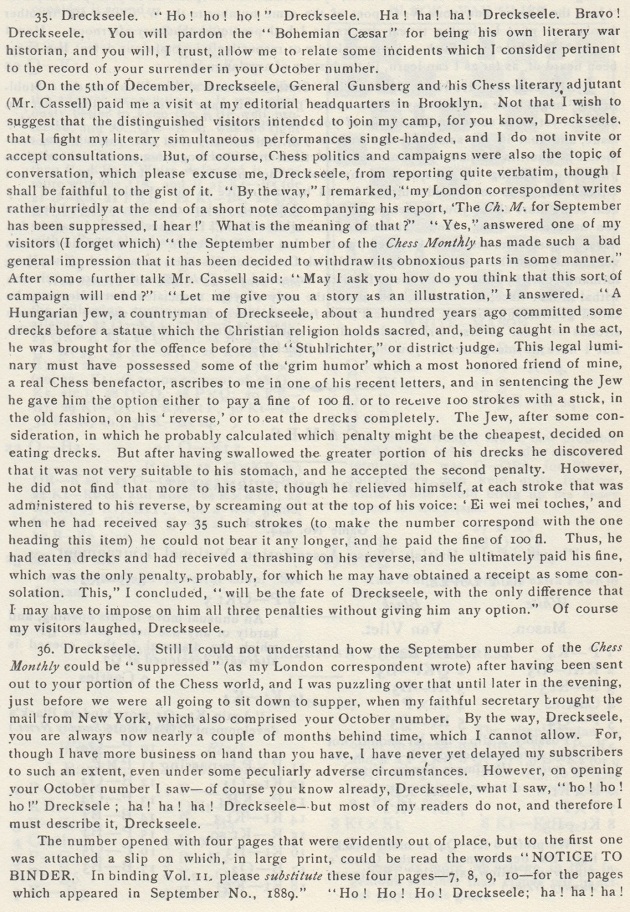
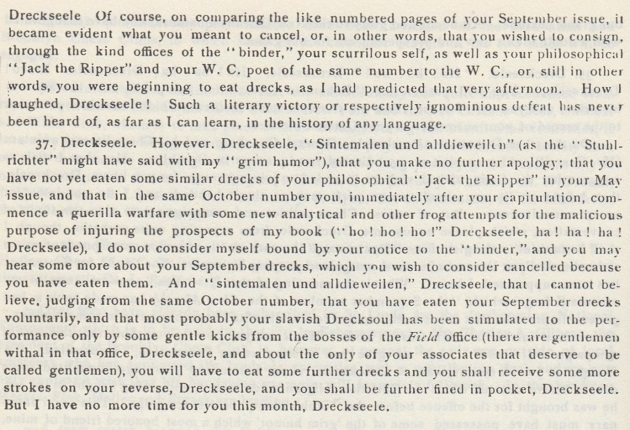
(11071)
See Chess and Poetry.
A remark by Steinitz on page 180 of the June 1889 International Chess Magazine:
‘Every well-known contributor to a public journal is at least in some measure responsible for the conduct of the publication which he associates his name with.’
(11064)
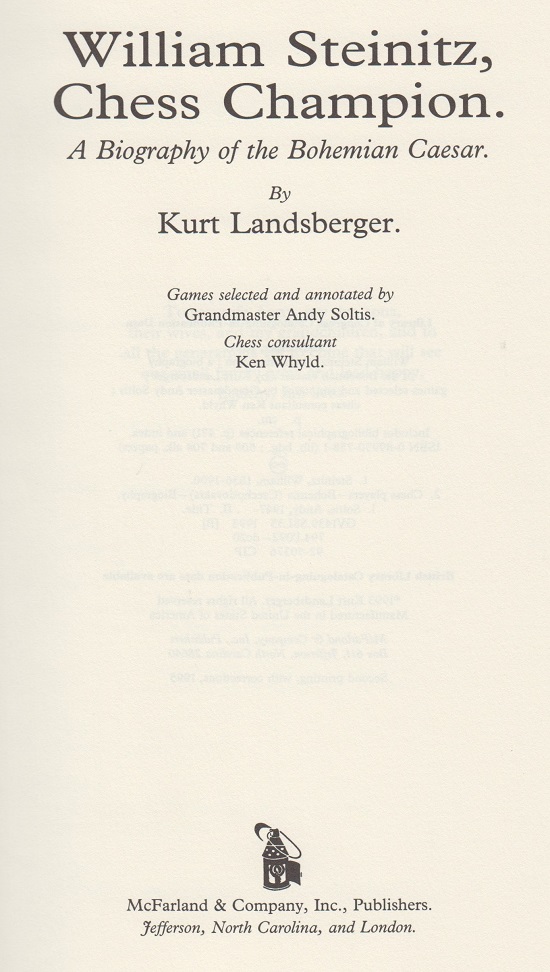
As regards the editorial and linguistic standards of William Steinitz, Chess Champion by Kurt Landsberger (Jefferson, 1993), on 14 September 1994 we wrote a letter to the publisher’s then President.
A ‘second printing, with corrections’ was produced in 1995, and a paperback edition in 2006.
(11072)
From page 11 of Chess Strategy and Tactics by Fred Reinfeld and Irving Chernev (New York, 1933):
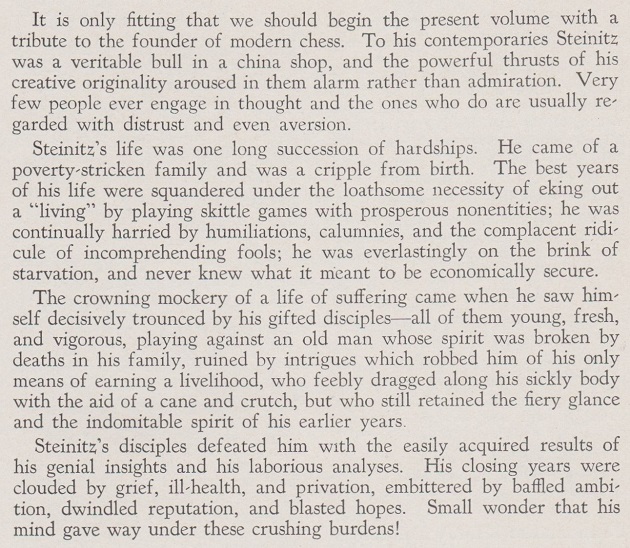
(11131)
‘The best years of his life were squandered under the loathsome necessity of eking out a “living” by playing skittle games with prosperous nonentities ...’
Regarding this comment about Steinitz by Reinfeld and Chernev in C.N. 11131, Eduardo Bauzá Mercére (New York, NY, USA) writes:
‘At least he could exercise his tactical prowess against them, as in the following game:’
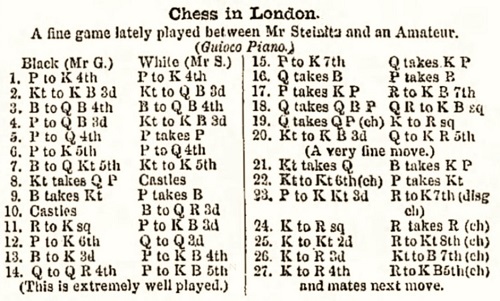
Source: The Era, 25 June 1871, page 7.
1 e4 e5 2 Nf3 Nc6 3 Bc4 Bc5 4 c3 Nf6 5 d4 exd4 6 e5 d5 7 Bb5 Ne4 8 Nxd4 O-O 9 Bxc6 bxc6 10 O-O Ba6 11 Re1 f6 12 e6 Qd6 13 Be3 f5 14 Qa4
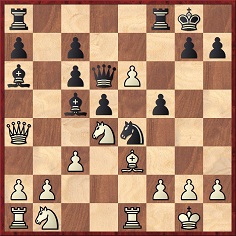
14...f4 15 e7 Qxe7 16 Qxa6 fxe3 17 fxe3 Rf2 18 Qxc6 Raf8 19 Qxd5+ Kh8 20 Nf3
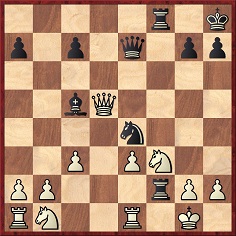
20...Qh4 21 Nxh4 Bxe3 22 Ng6+ hxg6 23 g3 Re2+ 24 Kh1 Rxe1+ 25 Kg2 Rg1+ 26 Kh3 Nf2+ 27 Kh4 Rf4+ 28 White resigns.
(11136)
Olimpiu G. Urcan has been looking into claims that Steinitz referred to chess as intellectual/mental gymnastics (geistige Gymnastik or intellektuelle Gymnastik) and offers these citations for such terms:
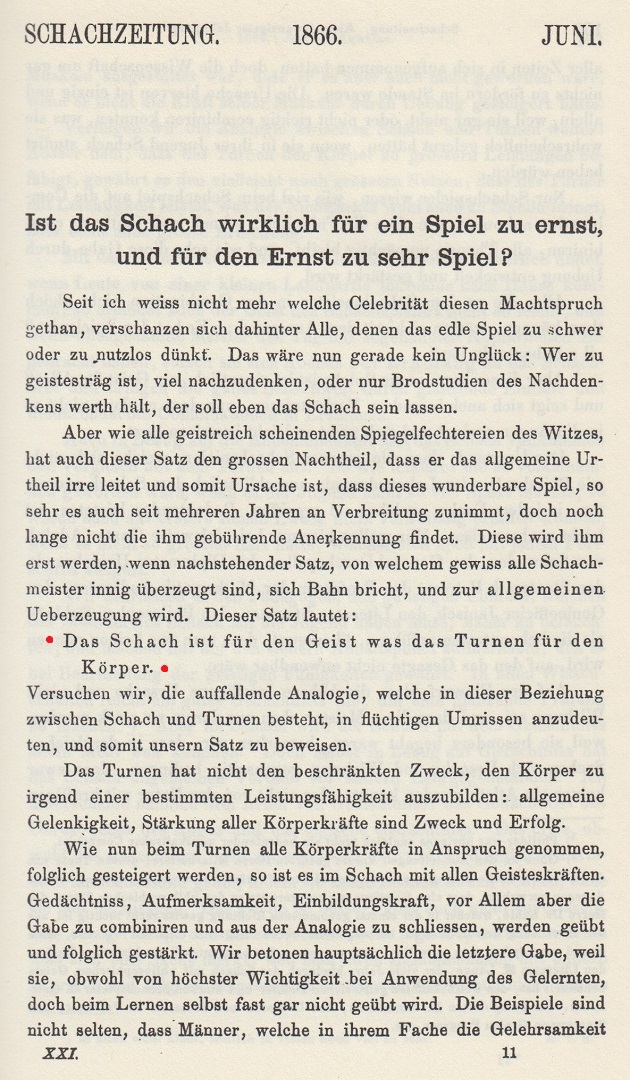
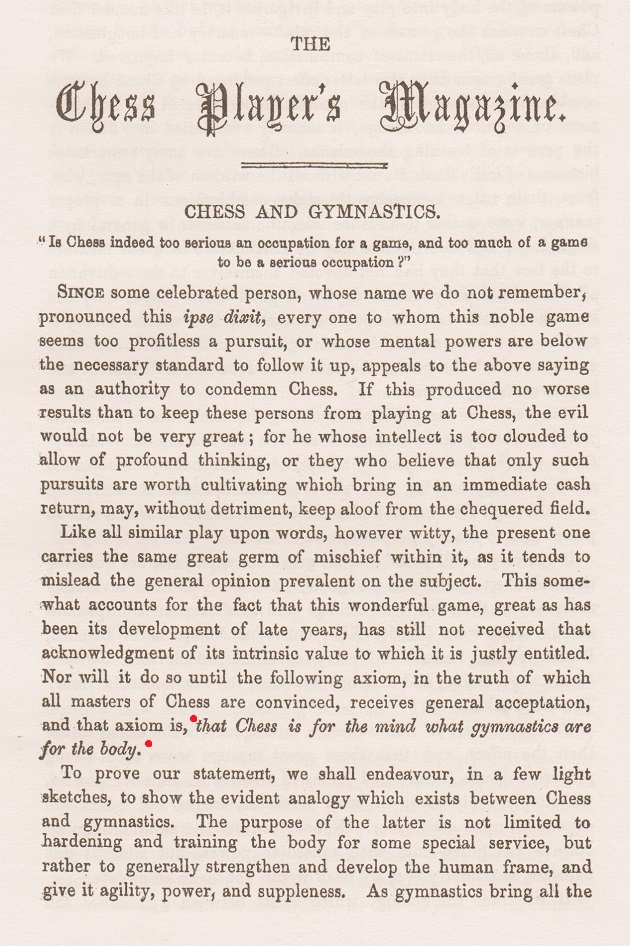
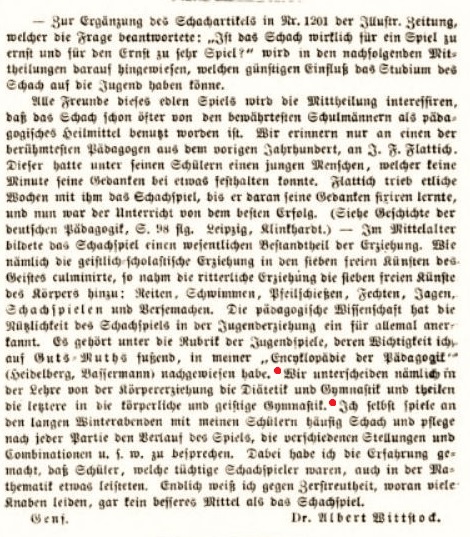
‘It is our intention to create for our readers a series of mental recreations or, in other words, we have pleasure in presenting them with a complete
intellectual gymnastics,
on which the mental portion of their organization may take full swing.
First and foremost in our mental gymnasium stands chess, the royal game; patronized by the Emperor, who reigns over nations, and by Genius, who, still greater, reigns over minds.’
... Charades, draughts, riddles, novels of a chess character, and intellectual gymnastics generally will form additional attractions to our work, and which, we trust, will duly contribute to the amusement of our readers.’
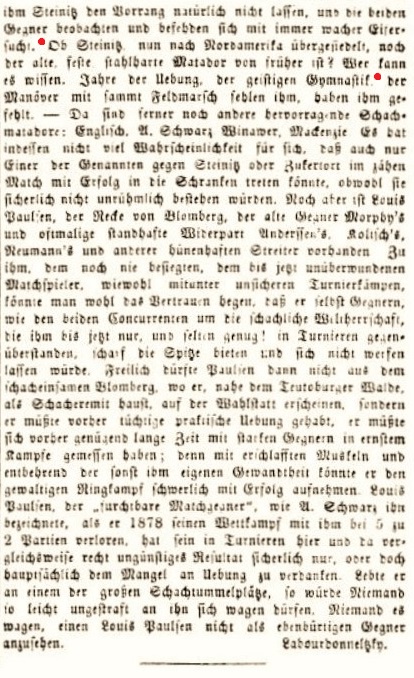
‘Chess is considered the most intellectual of amusements. Its tendencies are moral and refining. It is admirable mental gymnastics.’
‘You see I am trying to recover my good humor but I am really sincere in thinking that our mental gymnastics offered more relief to a philosophical mind in time of great affliction than even music or any other art.’
‘For many enthusiastic chessplayers are, like myself, convinced that the general cultivation of chess logic would help to cure our age from many political, economical and philosophical escrescences, and would also greatly diminish such baneful excesses and unhealthy habits as over-smoking, drinking, gambling, etc., which are incompatible with the acquisition of excellence in our mental gymnastics.’
‘In our time the game is becoming more widely popular among intelligent people in different countries, and it is almost universally recognized as a healthy mental exercise, which in its effects on the intellectual faculties is akin to that of physical gymnastics on the conservation and development of bodily strength.’
‘Chess may be described as mental athletics. It is the gymnasium of the mind. I believe that the mind can be trained as easily and perfectly as the body, and I know of no better exercise than chess. It develops, strengthens and clarifies the brain.’
‘It [chess] is a species of mental gymnastics, which, when properly applied, should be to the hygiene of the mind just what athletics are to the hygiene of the body. In other words, chessplayers may help brain workers to know how to take care of themselves.’
‘The influence of the cultivation of this game [chess] on the highest qualities of mind bears essential resemblance to the effect of gymnastics on the growth, increase and conservation of the physical powers.’
Mr Urcan adds:
‘I cannot provide independent corroboration of the text which Landsberger states was in the Pittsburg Dispatch.
You have noted on several occasions the inadequacy of the sourcing in his book William Steinitz, Chess Champion (Jefferson, 1993), and the gymnastics matter provides another example. From page 152:
The bibliographical reference ‘(34)’ leads to nothing more precise than this on page 472:
I can at least add that pages 357-358 of the November 1885 Deutsche Schachzeitung have a reference to H. Bennecke and to Steinitz’s useful letter, but there is nothing about any “intellectual gymnastics” remark.’
(11172)
Notes by Steinitz from page 22 of the New York Daily Tribune, 25 September 1892:

(11174)
The above is an extract from C.N. 11474, the full text of which is given in Emanuel Lasker Miscellanea.
Fabrizio Zavatarelli (Milan, Italy) draws attention to this excerpt from the ninth edition of the Encyclopaedia Britannica, on page 593, with respect to The Knight Challenge:
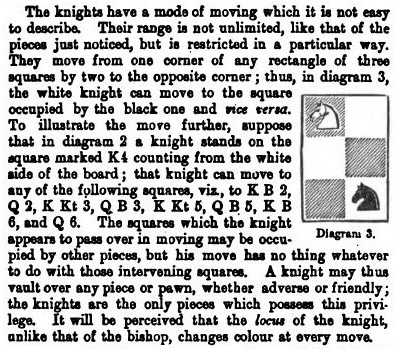
The article on chess, published in the mid-1870s, was signed ‘W.N.P.’, i.e. William Norwood Potter. His obituary on page 180 of the April 1895 BCM called it ‘masterly’; page 226 of the April 1895 Chess Monthly stated that Potter edited the article ‘together with Steinitz and Zukertort’.
(11263)
From page 4b of the St Louis Daily Globe-Democrat, 27 March 1910:

1 d4 d5 2 c4 e6 3 Nc3 Bb4 4 Nf3 dxc4 5 Qa4+ Nc6 6 Bd2 Qd7 7 O-O-O Nf6 8 e3 O-O 9 Bxc4 a6 10 Qc2 a5 11 e4 Nxd4 12 Qd3 Rd8 13 Nxd4 Qxd4 14 Qg3 Qxc4 15 Bh6 Rxd1+ 16 Rxd1 Ne8 17 Rd8 Qf1+ 18 Kc2 Qd3+ 19 Kxd3 Resigns.
C.N. 11572 gave the full text of a report on page 2 of the Weston Mercury and Somersetshire Herald, 7 March 1908 of a visit to Weston-super-Mare by Emanuel Lasker. It included the following:
‘Dr Lasker is of Jewish extraction and, by way of preface, it may be mentioned that there is considerably more in that fact than would prima facie appear, for the championship in the king of games has been retained in Jewish hands for no less than 42 years, Steinitz holding it for 28 years until 1894, while the subject of the present notice has been champion ever since. Dr Lasker himself attributes predominance of the Jewish genius in chess to the fact that its rules are entirely based upon those of self-defence in the struggle for life, of which art Jews are adepts.’
(11442)
Jerry Spinrad seeks information further to this paragraph on page 14 of the Era, 1 January 1865:

(11633)
From Rod Edwards (Victoria, BC, Canada):
‘The opponent of Steinitz was Edward Healey (not Herley). The results of Steinitz’s two match victories against E. Healey at knight odds were given on page 8 of the Chess Player’s Magazine, January 1865: +5 –1 =0 and +5 –1 =1. The matches were also mentioned by P.W. Sergeant on page 136 of A Century of British Chess, where he gave the score of both as 5-1. The statement that Edward Healey was the brother of the better-known Frank Healey was made by Sergeant on page 134. At least one of the matches with Steinitz was completed before 10 April 1864, as announced in the Era that day (page 5)’:

Other references are given at Edo Ratings, Healey, E.’
(11636)
A remark often found attributed, sourcelessly, to Steinitz is:
‘Chess is not for the faint-hearted; it absorbs a person entirely. To get to the bottom of this game, he has to give himself up into slavery. Chess is difficult, it demands work, serious reflection and zealous research.’
Richard Forster (Winterthur, Switzerland) points out the following text on page iv of Ludwig Bachmann’s final volume on Steinitz:
‘Zum Schlusse führe ich noch aus dem interessanten Gedankenaustausch, den der Verfasser 1896 mit Steinitz hatte, einige bemerkenswerte Ausführungen zu seiner Charakteristik an: “Das Schach ist nichts für kleine Geister, es beansprucht einen vollen Mann, der sich nicht sklavisch an das Überlieferte hält, sondern selbständig die Tiefen des Spiels zu ergründen sucht. Es ist wahr, ich bin ein schwieriger, kritischer Kopf; aber sollte man da nicht kritisch werden, wenn man so oft oberflächliche Urteile über Stellungen anhören muss, deren wahrer Wert erst durch tiefgründige Forschung klargestellt werden kann. Soll man sich nicht ärgern, wenn man sieht, wie unselbständig an veralteten Methoden festgehalten wird, bloß damit man nicht in seiner Bequemlichkeit gestört wird. Ja das Schach ist schwer, es erfordert Arbeit, ernstes Nachdenken, nur eifrige Forschung kann befriedigen. Nur rückhaltlose Kritik kann zum Ziele führen. Aber der Kritiker gilt leider vielen als Feind statt als Führer zur Wahrheit. Mich aber wird Niemand vom Wege zur Wahrheit abbringen.”’
Our correspondent also draws attention to page 39 of Reuben Fine’s The Psychology of the Chess Player (New York, 1967), where this translation of Steinitz’s 1896 letter to Bachmann is given:
‘Chess is not for timid souls. It demands a whole man, who does not stick slavishly to what has been handed down, but attempts independently to probe the depths of the game. It is true that I am not easily pleased and critical, but shouldn’t one become critical if one so often has to hear superficial opinions about positions which can only be clarified by a thorough investigation. Shouldn’t one worry if one sees how antiquated methods are clung to in a dependent way merely to avoid having one’s comfort disturbed. Yes, chess is difficult, it demands work, serious reflection, only diligent investigation can satisfy. Only ruthless criticism can lead to the goal. But for many unfortunately the critic is seen as an enemy rather than as a guide to the truth. But no-one will ever draw me away from the road to the truth.’
(11971)
From Street Names with Chess Connections:
James Bell Cooper (Vienna) sends this photograph taken in Vienna:

The Steinitzsteg, a bridge across the Danube for pedestrians and cyclists.
An addition to Chess: Mistaken Identity on 31 October 2023:

Zachary Saine (Amsterdam) points out that the picture is of the architect Wilhelm Stiassny (1842-1910).
This photograph was published on page 129 of the August 1897 American Chess Magazine:

Larger version and detail of the front row
We see no caption in the American Chess Magazine, but as mentioned on page 408 of the first of two volumes on Pillsbury by Nick Pope (see the end of our article Harry Nelson Pillsbury), those seated nearest to the camera are Borsodi, Hanham, Pillsbury, Lipschütz, Pieczonka, Steinitz and Napier.
An Albert Pieczonka webpage shows another photograph from the same location.
Page 148 of the August 1897 American Chess Magazine has the group portrait given in C.N. 5550, and the following is on page 149:

The above images have been provided by the Cleveland Public Library.
(12030)
Much writing on chess history is wishful thinking or name-dropping, but careful authors sidestep the trap of what we propose to call ‘figurehead romanticism’. This includes, for example, claims or assumptions that most of the contents of Lasker’s Chess Magazine and Capablanca-Magazine were written by Lasker and Capablanca themselves. (The case of the International Chess Magazine is different, since Steinitz specified that it was largely a solo enterprise.)
A similar practice was mentioned in C.N. 8827: attributing a book by Tartakower and du Mont to Tartakower only. When there is assisted authorship (such as Kasparov books involving Donald Trelford or Mig Greengard, both of whom receive a ‘with’ credit), some writers need no second bidding to prefer without; they mention Kasparov alone. We can see a case for that in brief bibliographies, but not in reviews or discussions of the book.
(12043)
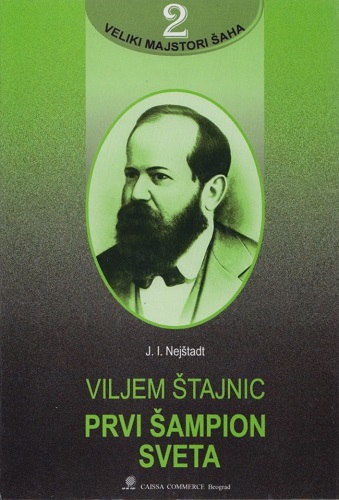
Other chess figures named Steinitz:
The one and only Wilhelm Steinitz is not the one and only chess Steinitz. Jeremy Gaige’s Chess Personalia listed another W. Steinitz (born circa 1904), and others too bore that surname. The best known was the problemist and journalist Steinitz of Breslau, whose 70th birthday was announced on page 271 of the 26 July 1914 Deutsches Wochenschach. Pages 269-270 of the same issue had this miniature:
Julius Steinitz – Arnold Schottänder
Breslau, 1903
Ruy López
1 e4 e5 2 Nf3 Nc6 3 Bb5 f5 4 Nc3 fxe4 5 Nxe4 Nf6 6 Ng3 d6 7 O-O Bd7 8 d4 e4 9 Re1 d5 10 c4 Be7 11 cxd5 exf3 12 dxc6 bxc6 13 Bc4 fxg2 14 Bg5 Kf8 15 Nh5 Bg4 16 Bxf6 Bxd1 17 Bxg7+ Ke8 18 Nf6 mate.
Then there was this notice on page 149 of the September-October 1922 American Chess Bulletin:
‘Y. Steinitz, 939 North Orianna street, (rear No. 8), Philadelphia, Pa., wishes to play by correspondence with any readers of the Bulletin.’
Finally, we have the 212-page book Der praktische Schachspieler by K.G. Steinitz, published in Reutlingen. It is undated, but chess library catalogues give 1888 as the year of first publication.
(3156)
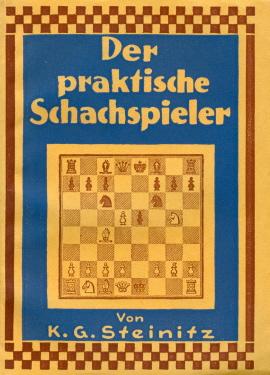
For more information on this topic, including pictures, see Chess Camouflage Publications.
Further to the reference in C.N. 3156 to a twentieth-century W. Steinitz (see page 277 of Chess Facts and Fables) Michael McDowell sends the following, from page 577 of The Problemist, May 1953:
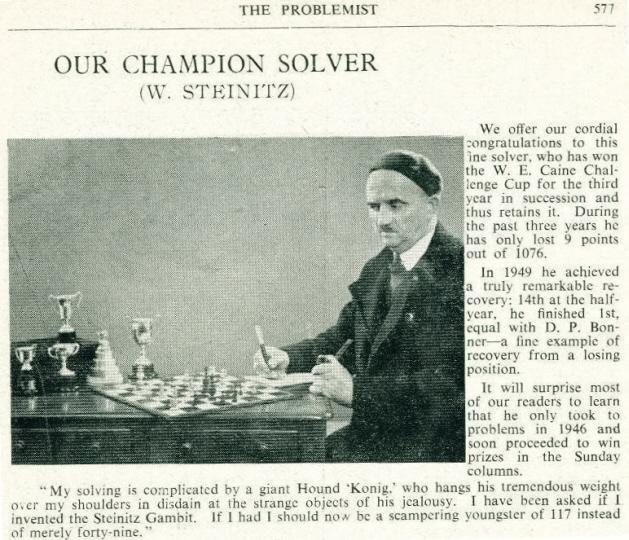
Mr McDowell comments:
‘He was one of the strongest solvers in The Problemist in the late 1940s and the 1950s. His last entry in the solving ladder dates from September 1973. No obituary ever appeared in The Problemist. In 1954 he presented a silver cup to the British Chess Problem Society known as the “Intermediate Cup”; it was to be awarded to the solver who gained the highest points in a section entitled “Our Own Composers”, which was aimed at those with little experience of composition or solving. These days the trophy fulfils a similar function, being awarded to the winner of the solving ladder in The Problemist Supplement.’
(5190)
Addition on 10 January 2025:
On page 9 of the New York Evening Post, 2 November 1907 Lasker gave the 13th match-game between Blackburne and Zukertort, London, 7 June 1887 with this introduction:
‘It is well, from time to time, to cast a look into the past in order to compare present achievements with those of a former generation. One is as apt to exaggerate the one as the other. Those who are musically inclined think of the past as beautiful and dream of a future Eden, but they are never happy in the present. And the practical man who enjoys what he holds fast is a loser to the extent in which he might live old pleasures over again. That is as true in chess as in anything else. In chess we have lately been living at such a high rate of speed that one hears the old masters and masterpieces mentioned but seldom, and then with a sort of apology. There are so many “events” to be recorded that we forget to inquire into the quality of the achievement over the clamor of it. Hence an occasional retrograde movement of, say, two decades back, will do some good to the chess student and chess lover.
At that time there was a great analyst whose notes were studied assiduously by Pillsbury and, in the opinion of many, have never been equalled. That was he of a philosophical if untutored mind, the great Steinitz, who pried the innermost secrets of chess strategy open, but whom the world did not recognize or reward. The manner in which he laid bare the inner workings of the chess pieces in any game that he analyzed is a treat to the connoisseur. Here is an example, taken almost at random from the pages of his International Chess Magazine, where one may find it in the August issue of 1887.’
The present general article on Steinitz complements the following more specific feature articles, and little material from them has been duplicated here:
Grimshaw v Steinitz
Steinitz, Lasker, Potter and
the ‘Modern School’
Steinitz v von Bardeleben
Steinitz versus God
‘Fun’
Kasparov, Karpov and the Scotch
Steinitz Stuck and Capa Caught
Steinitz Quotes
Articles about Wilhelm
Steinitz.
See also The Chess Masters of To-day by Leopold Hoffer.
To the Archives
for other feature articles.
Copyright Edward Winter. All rights reserved.